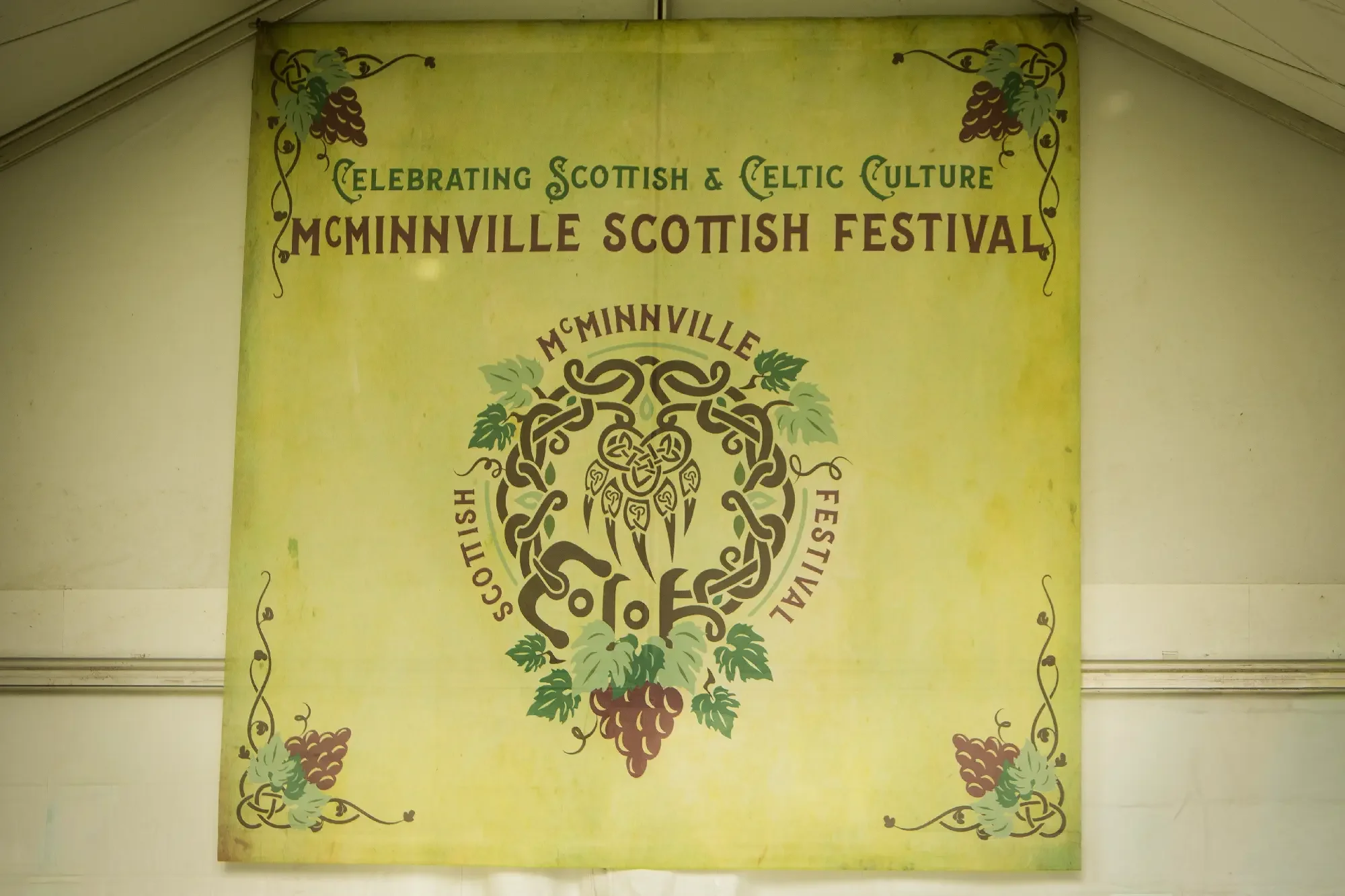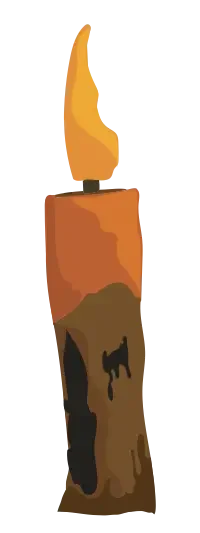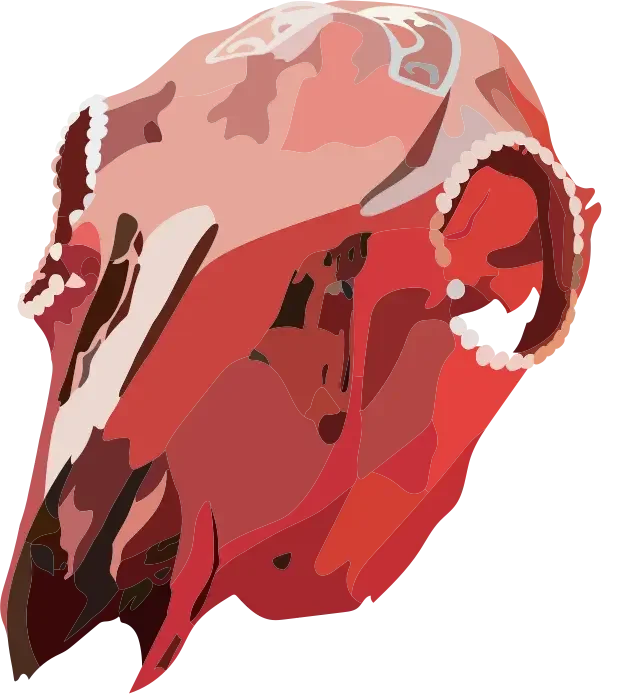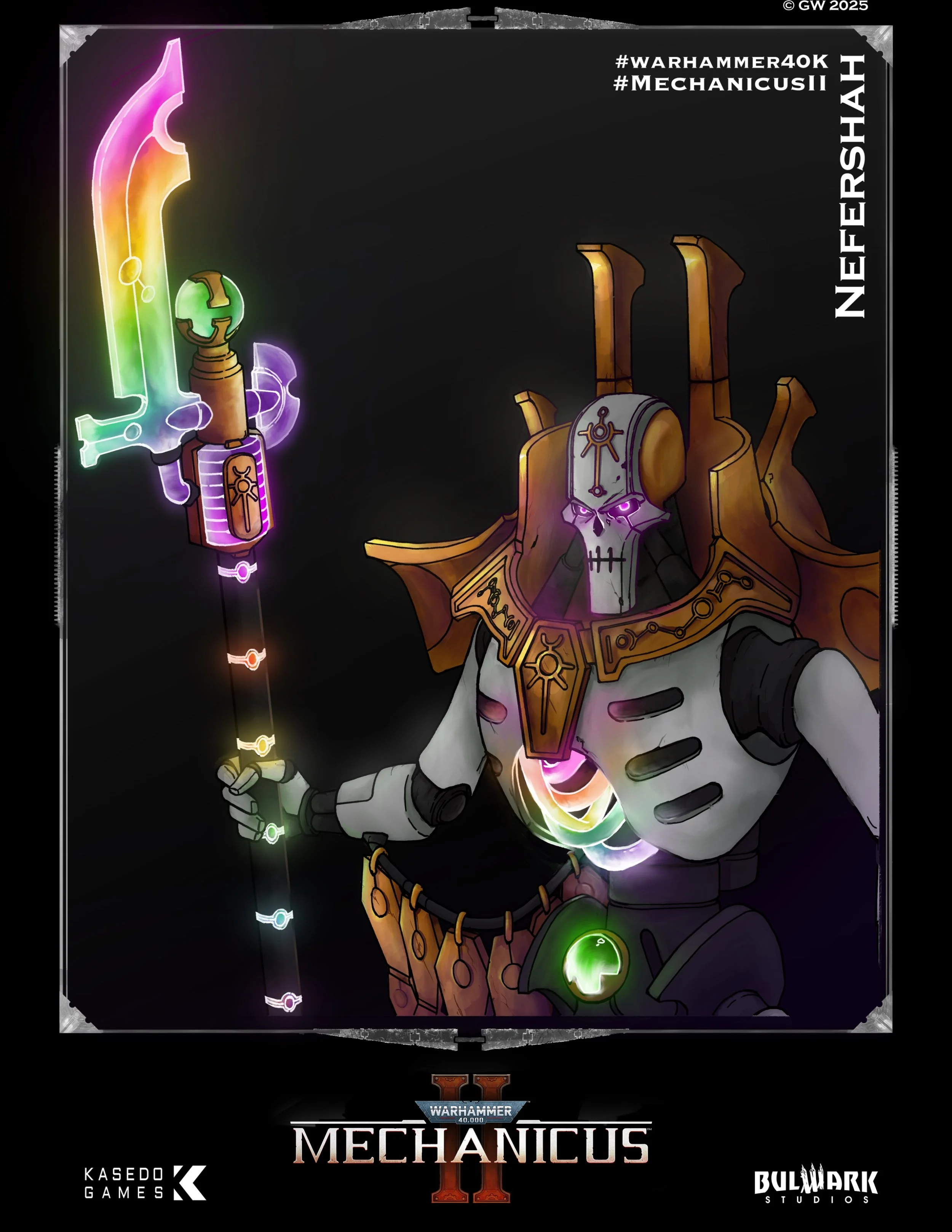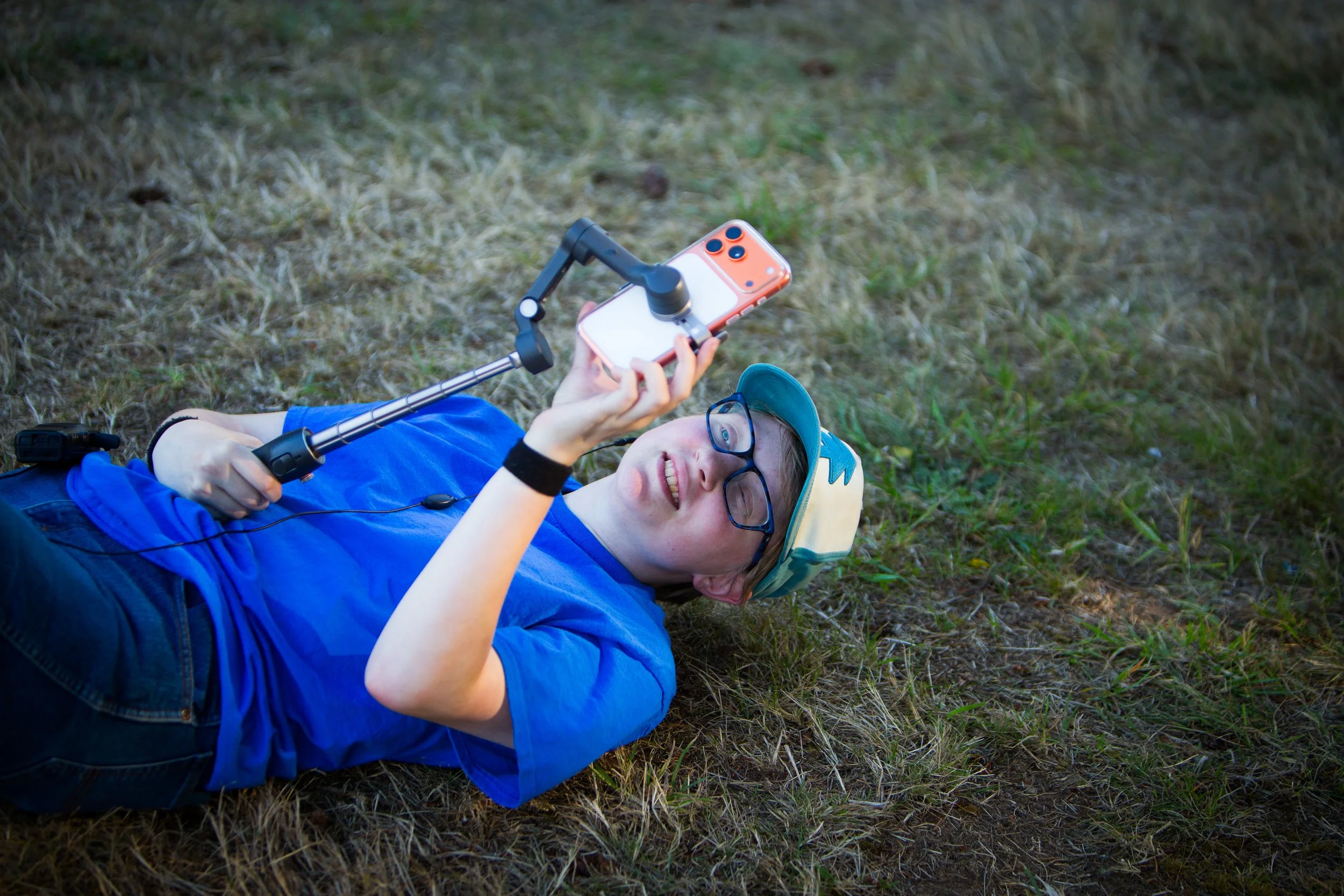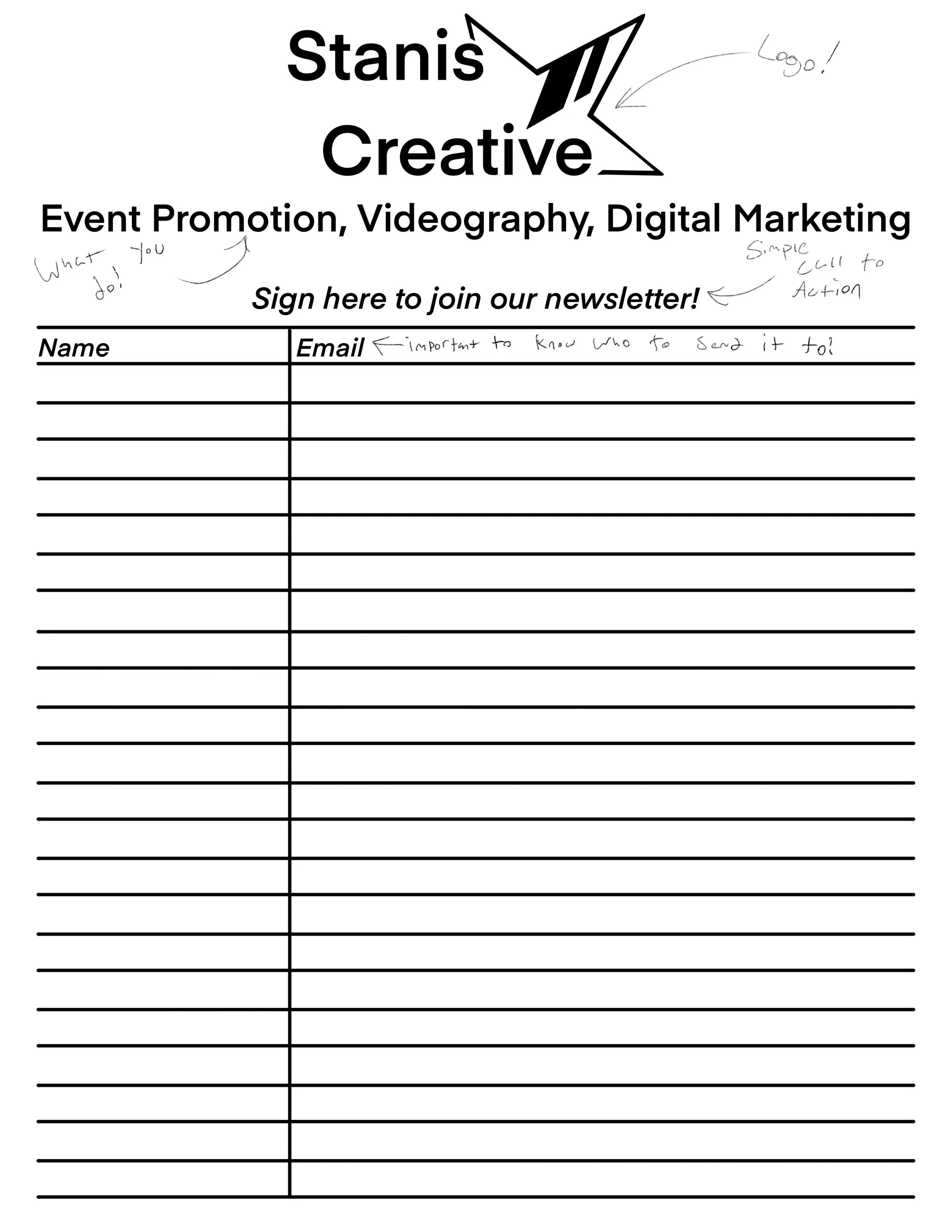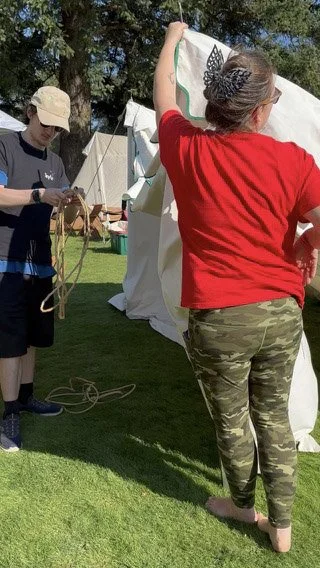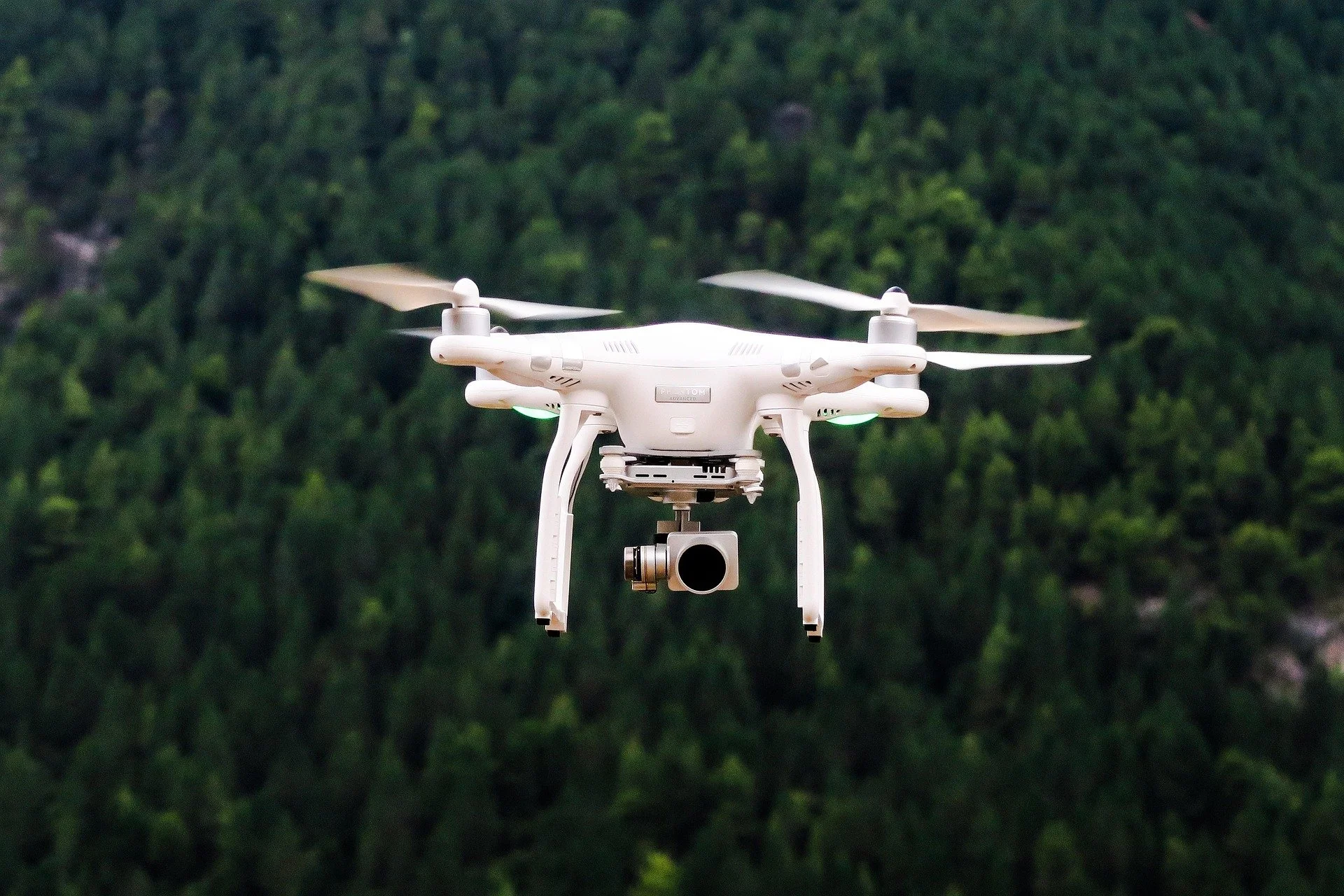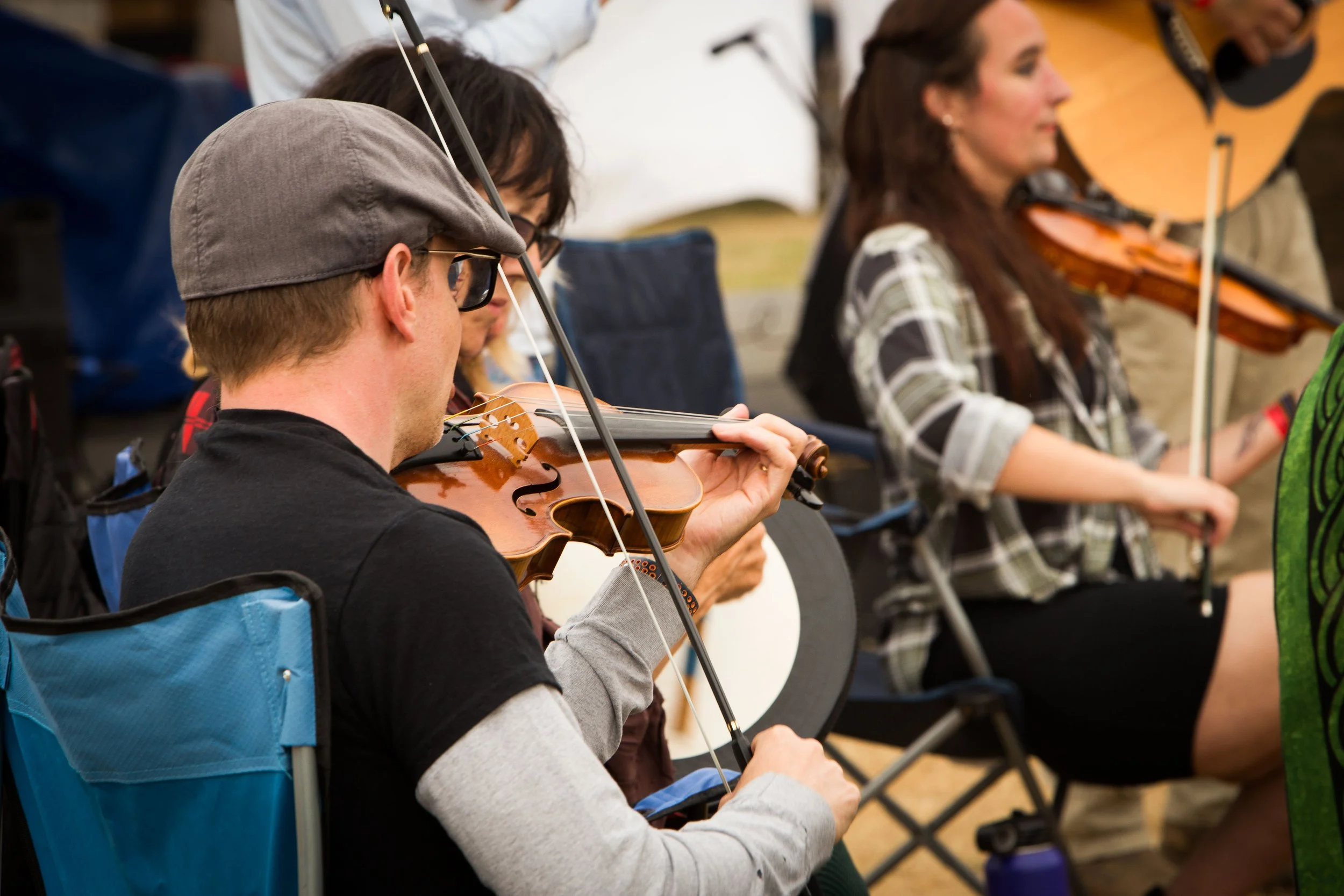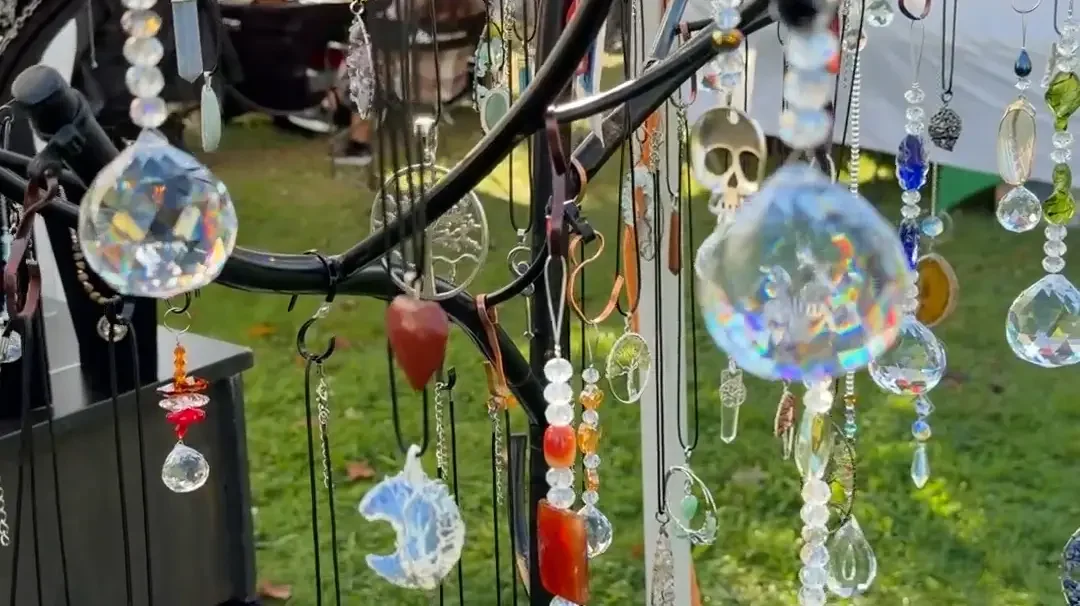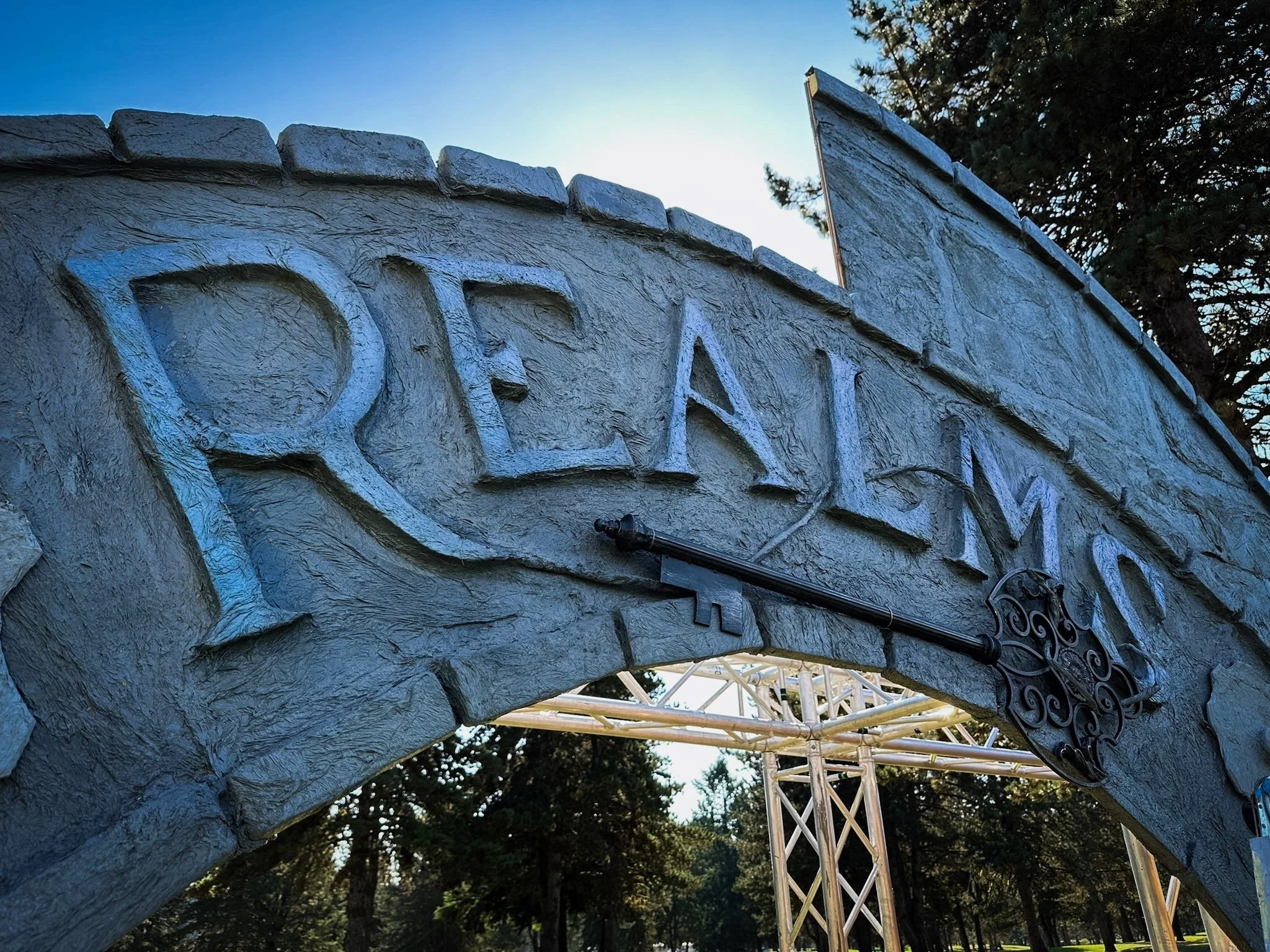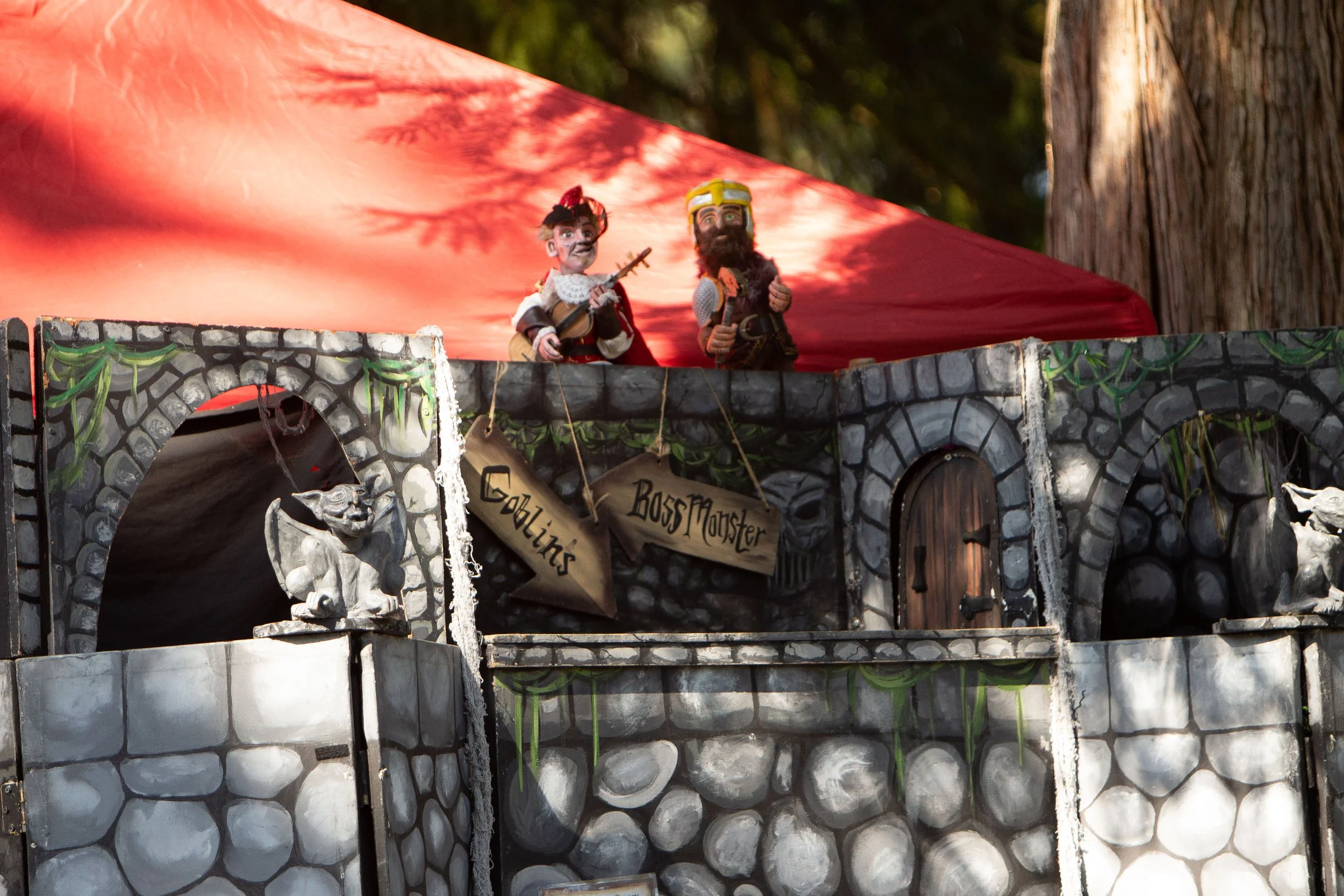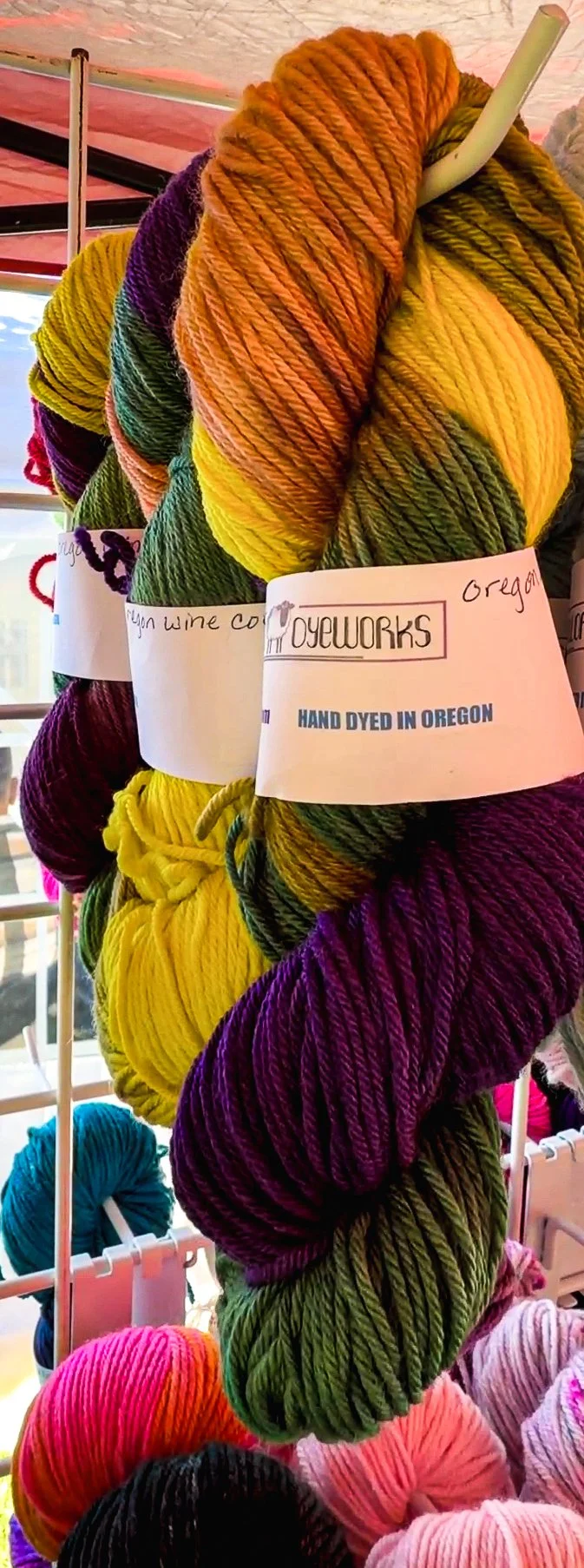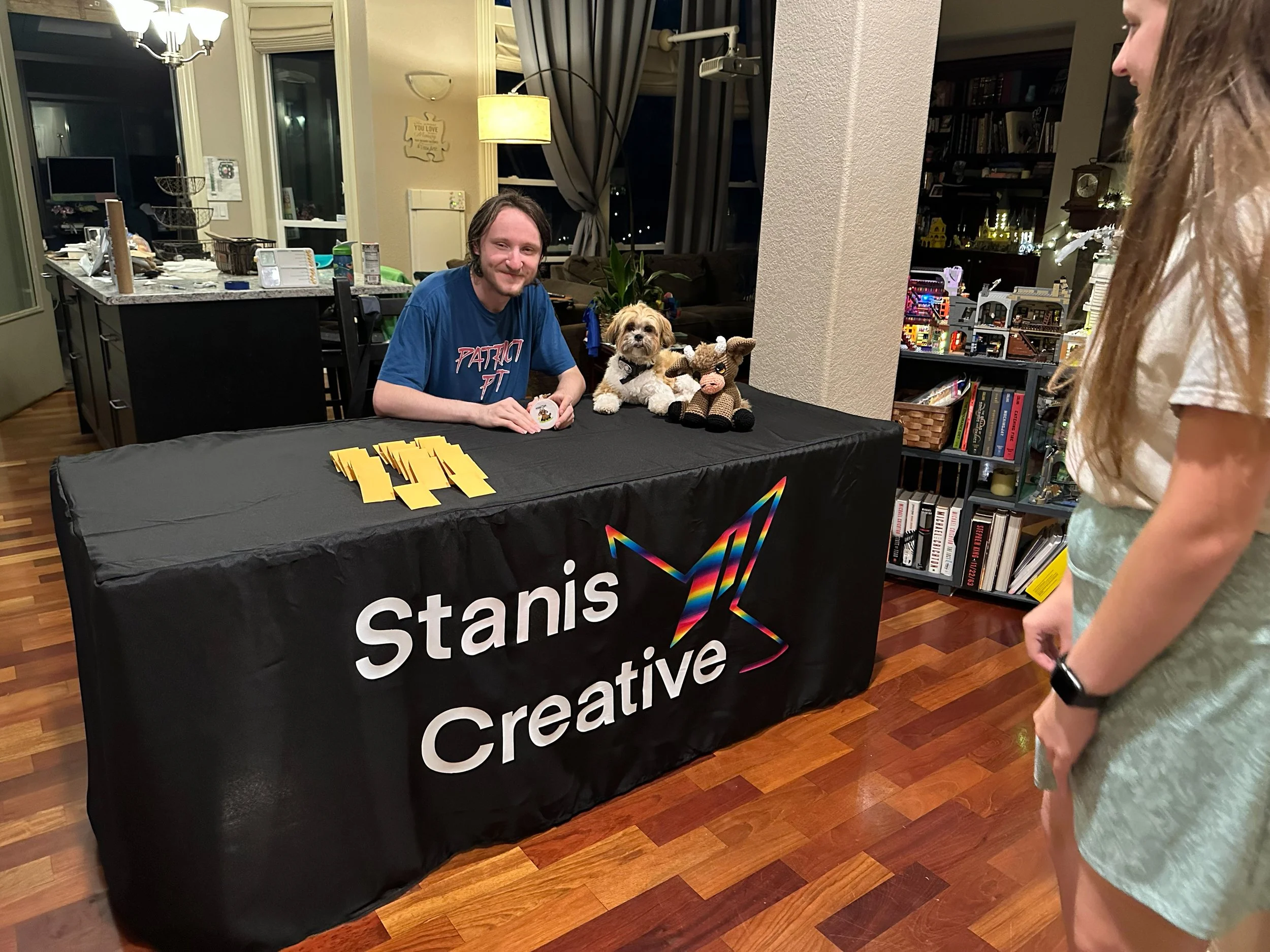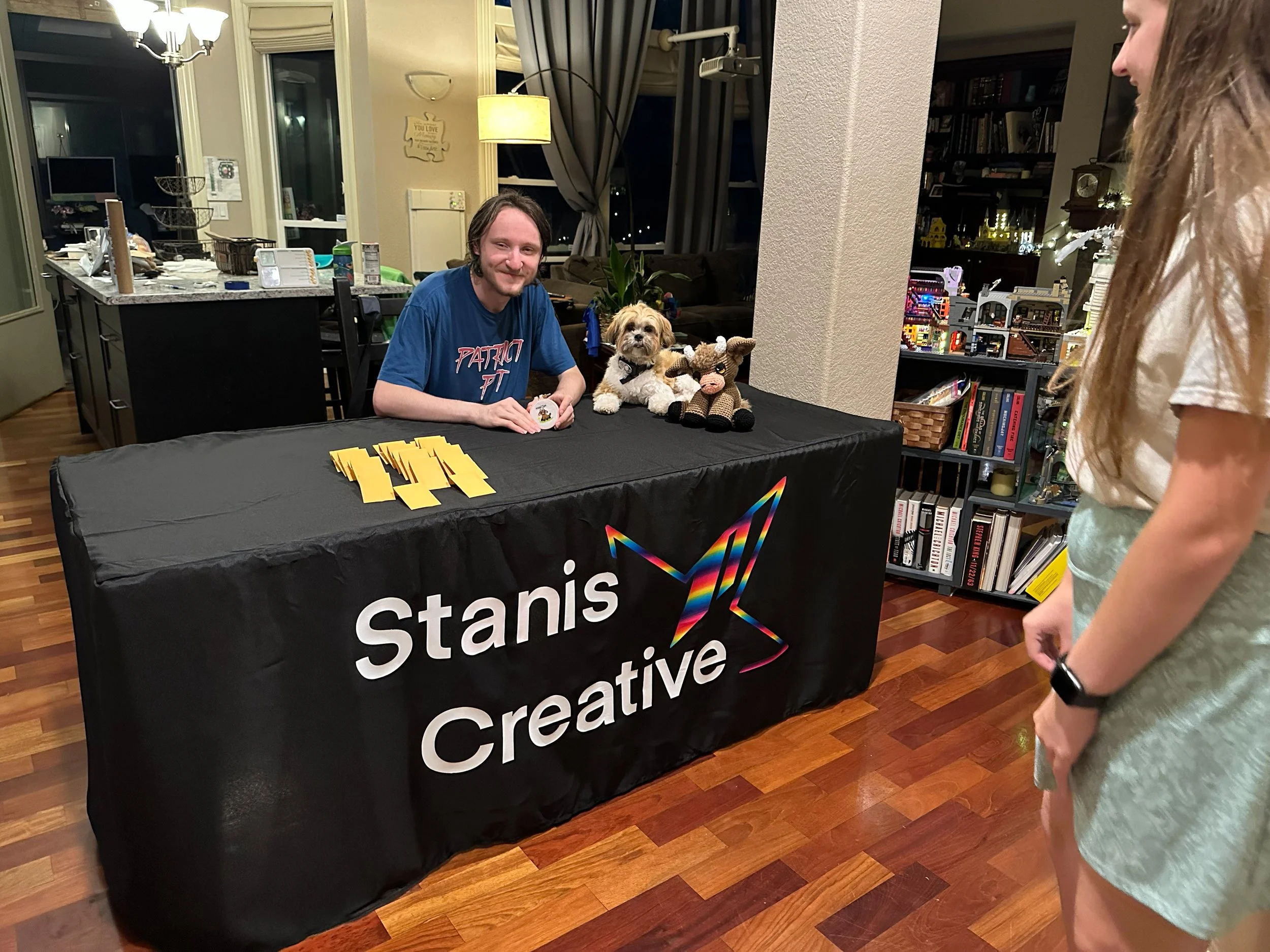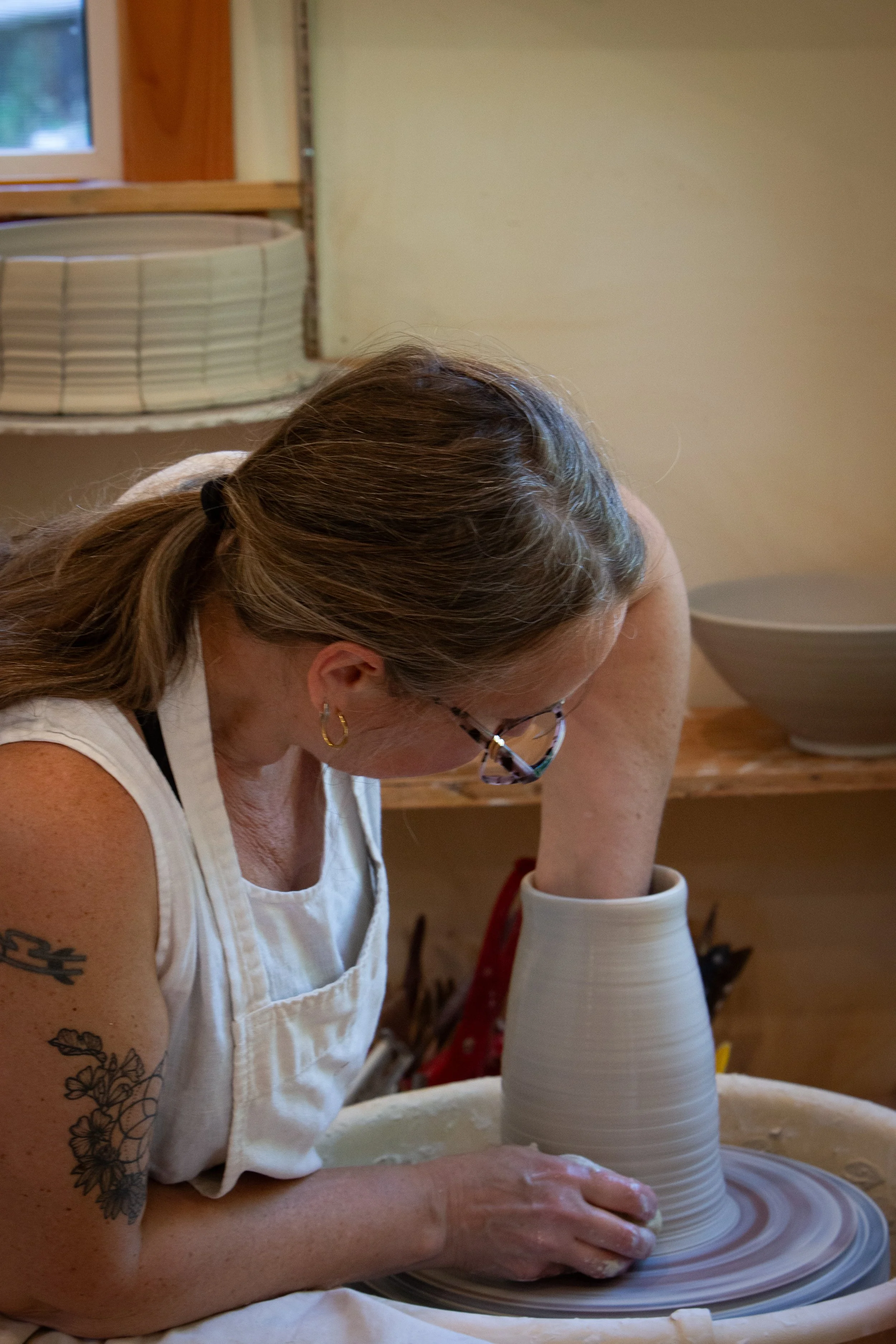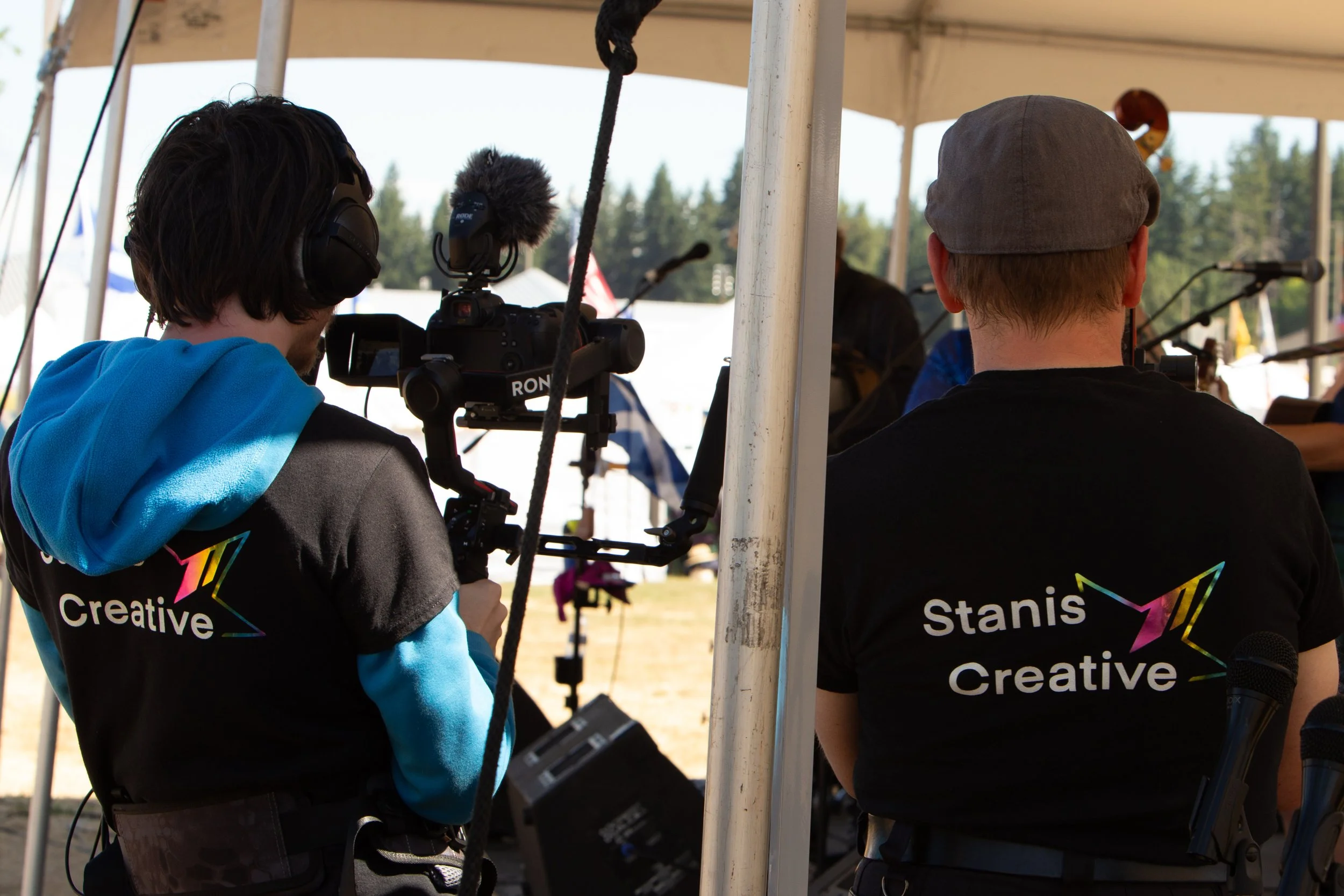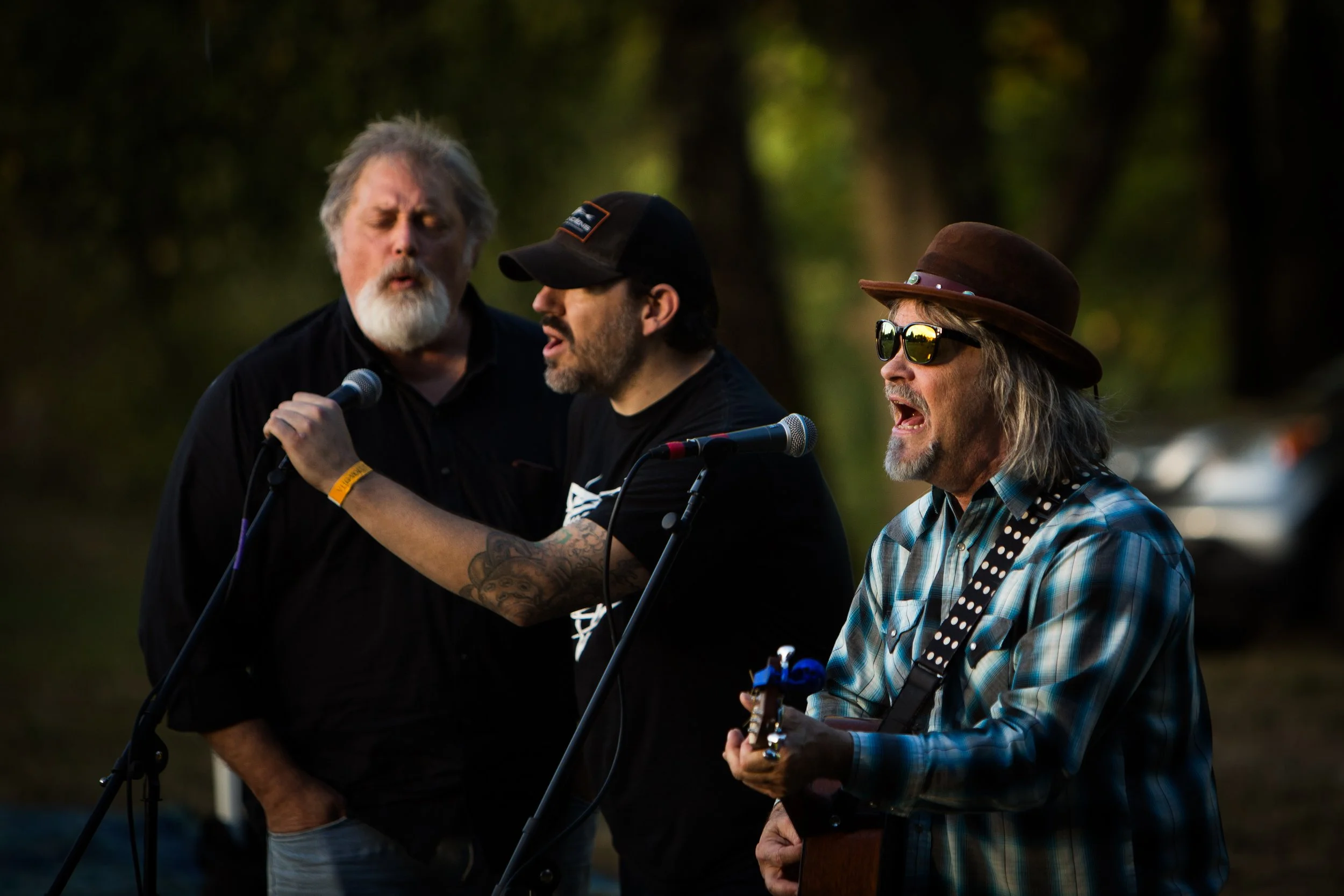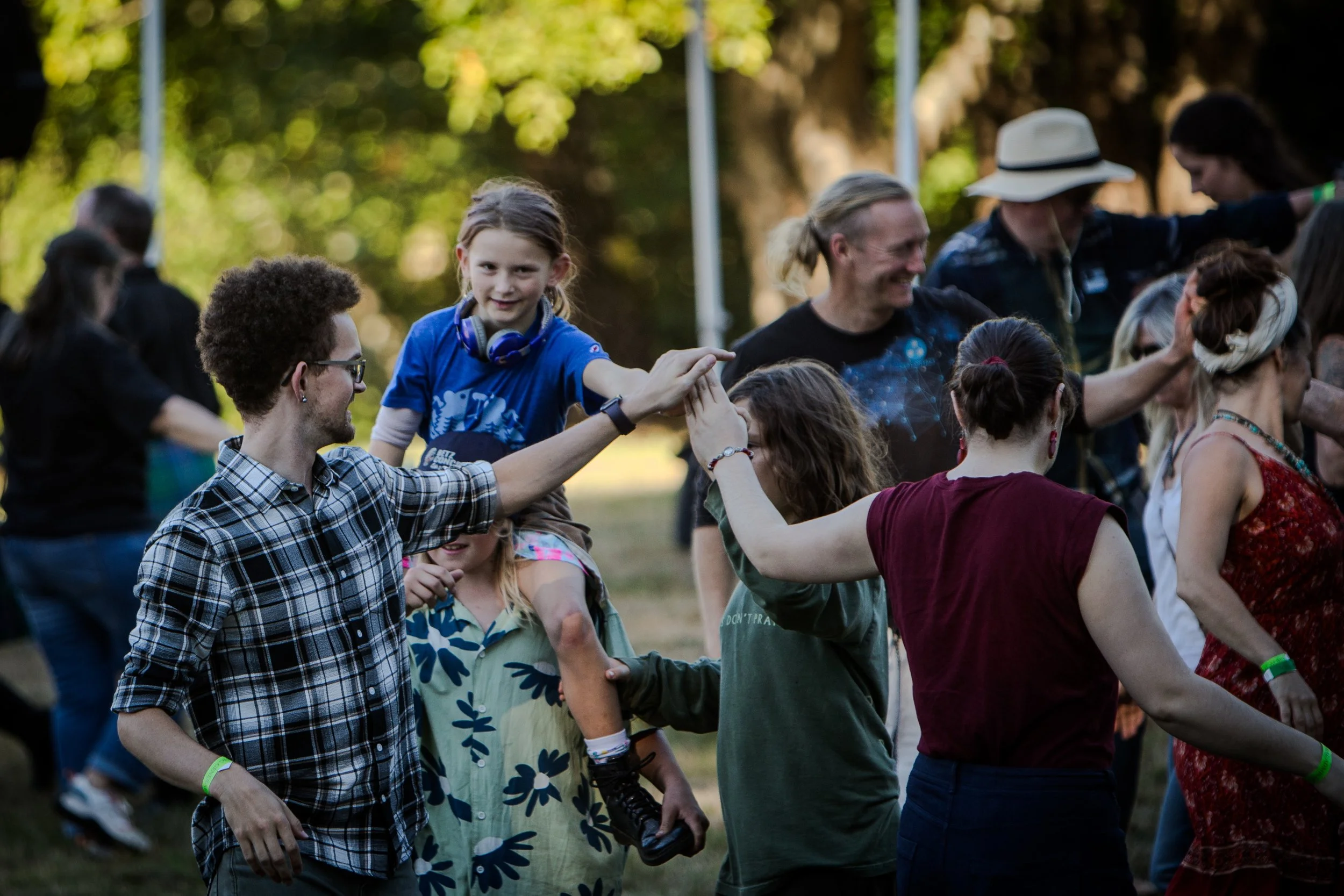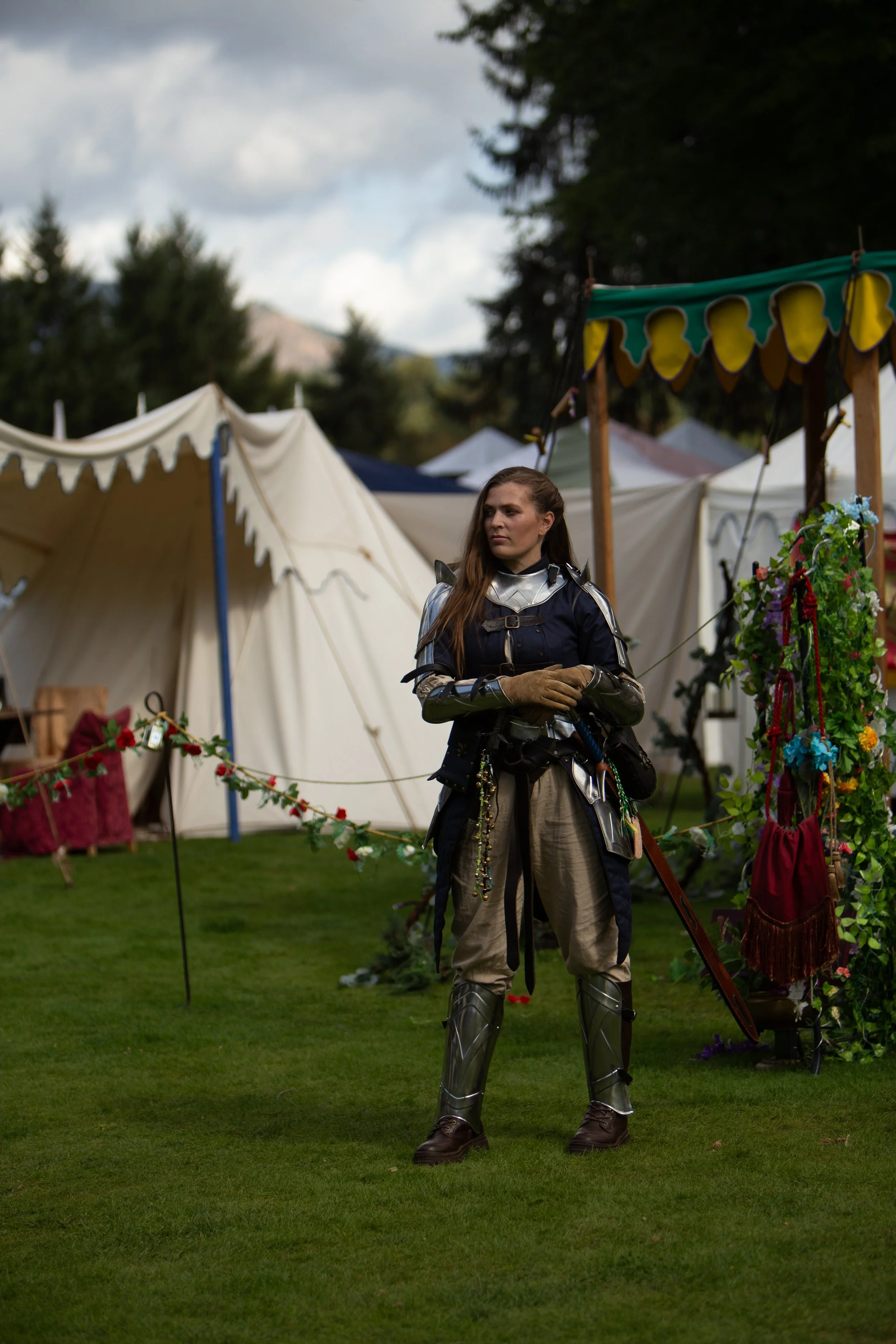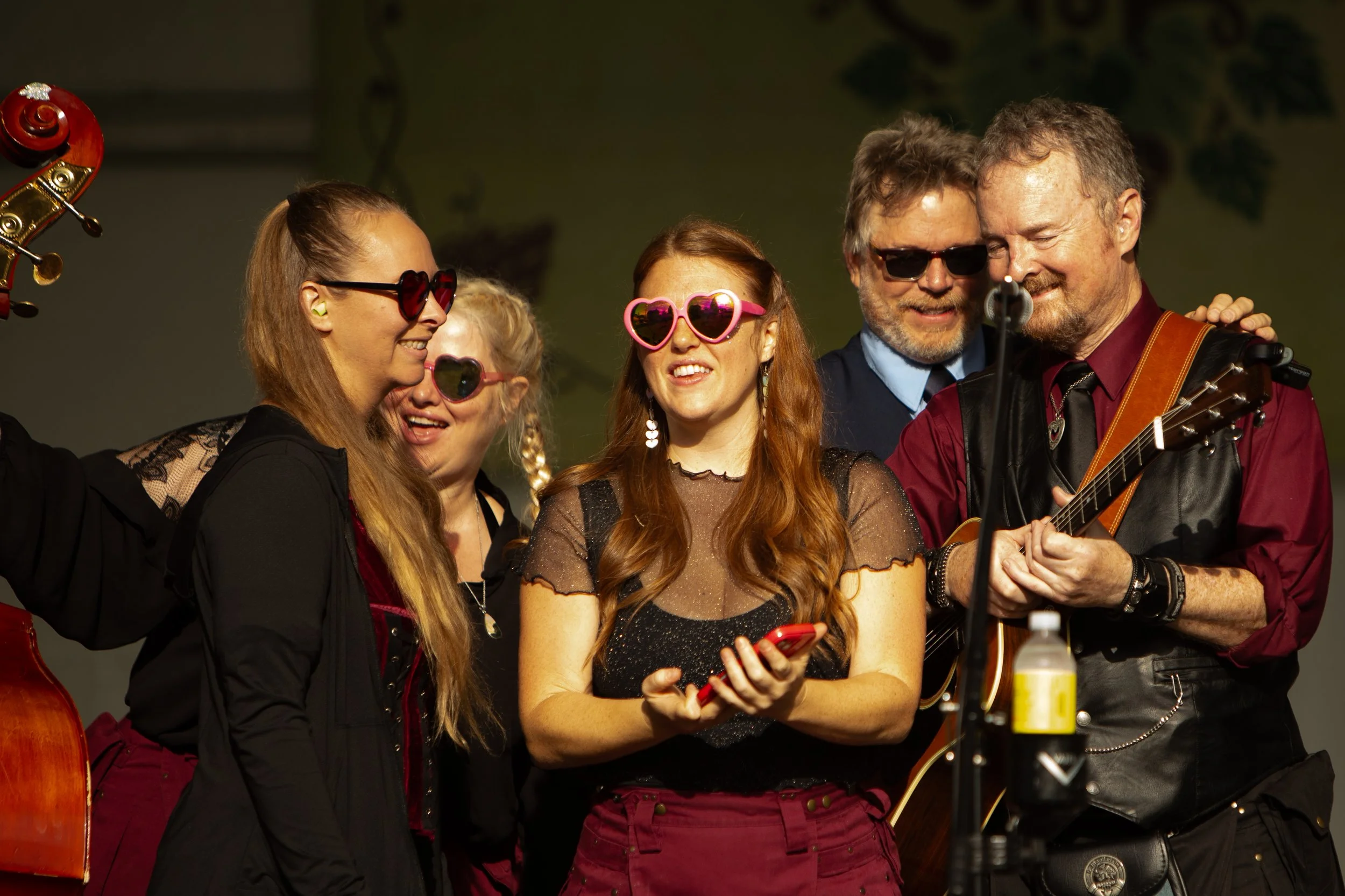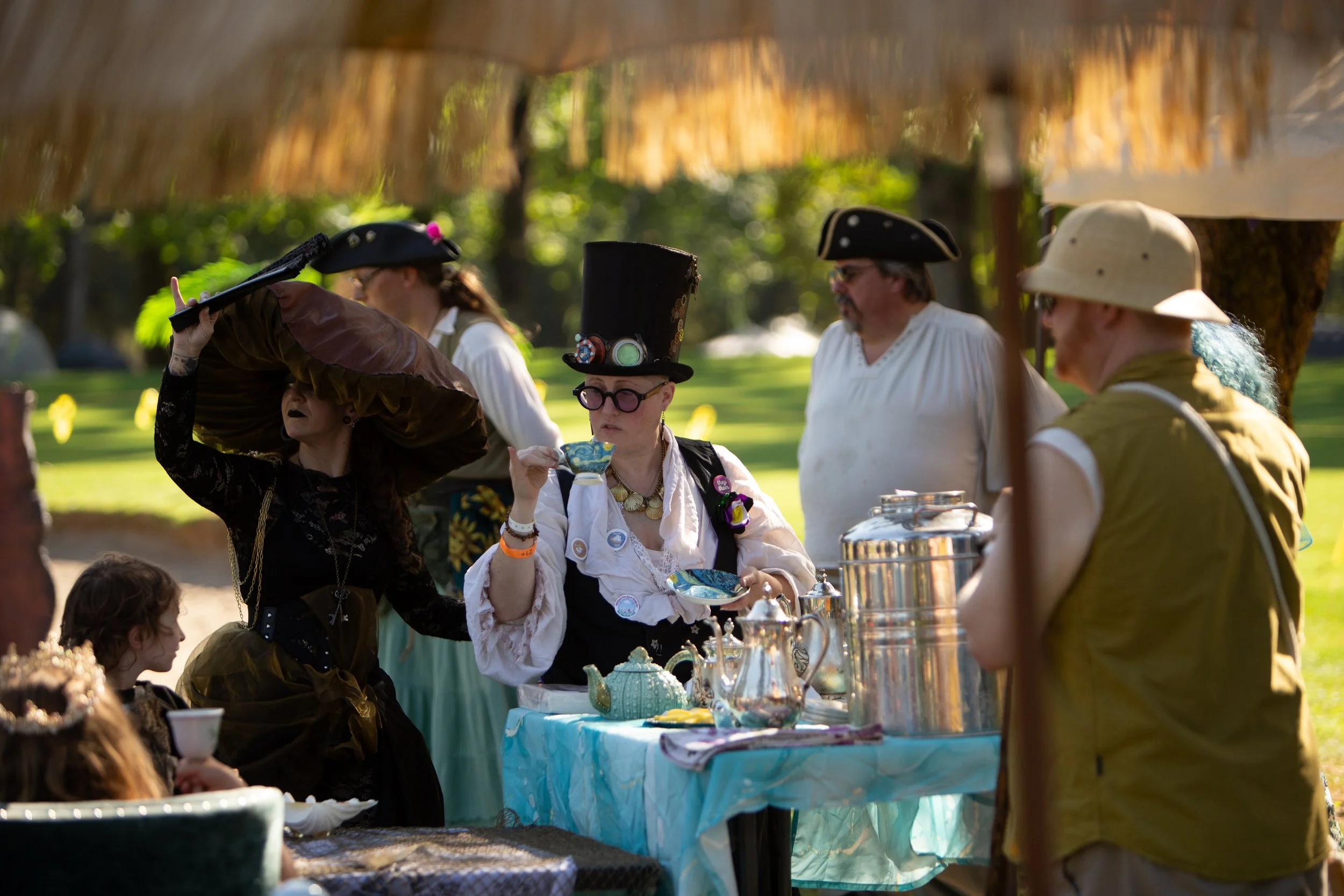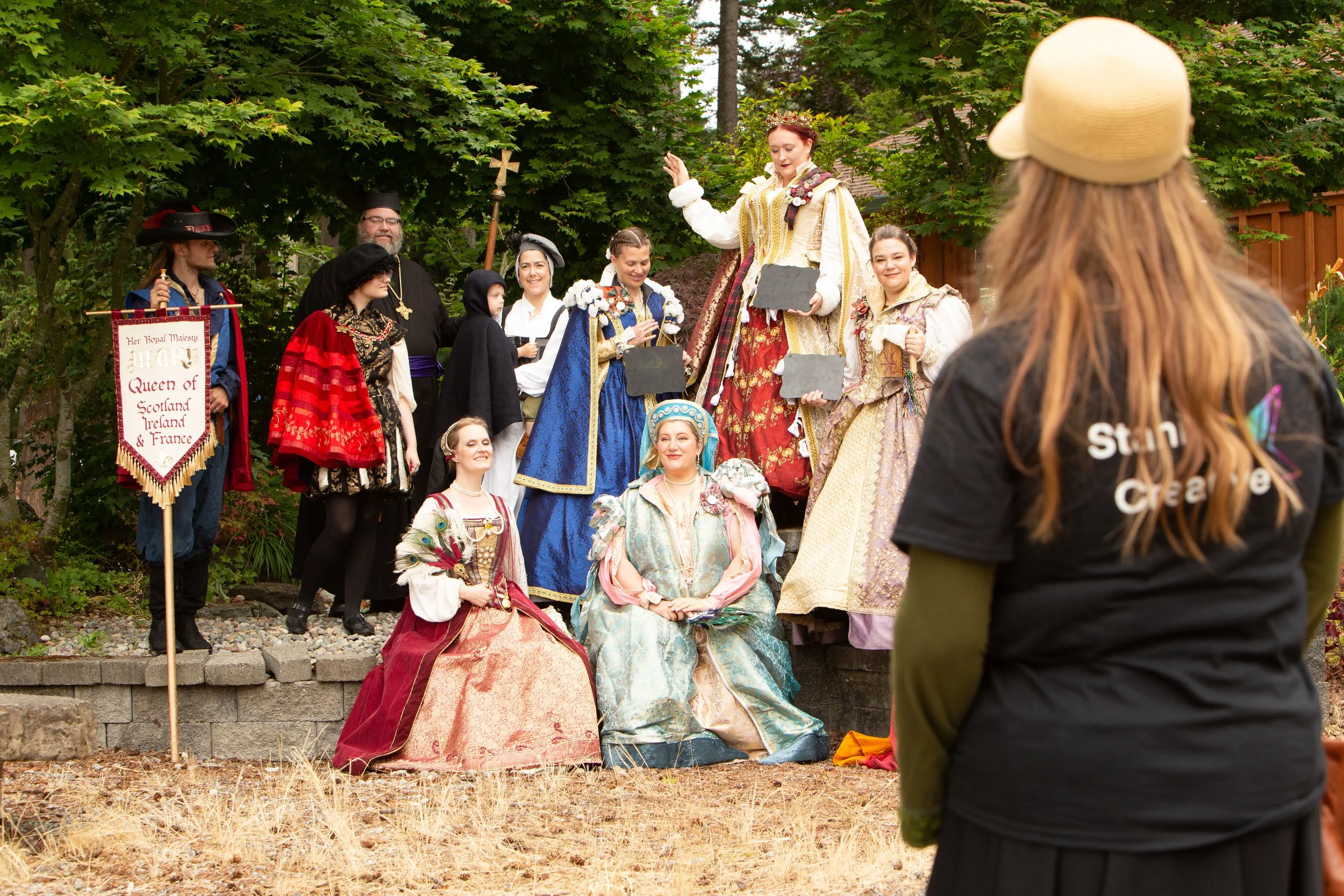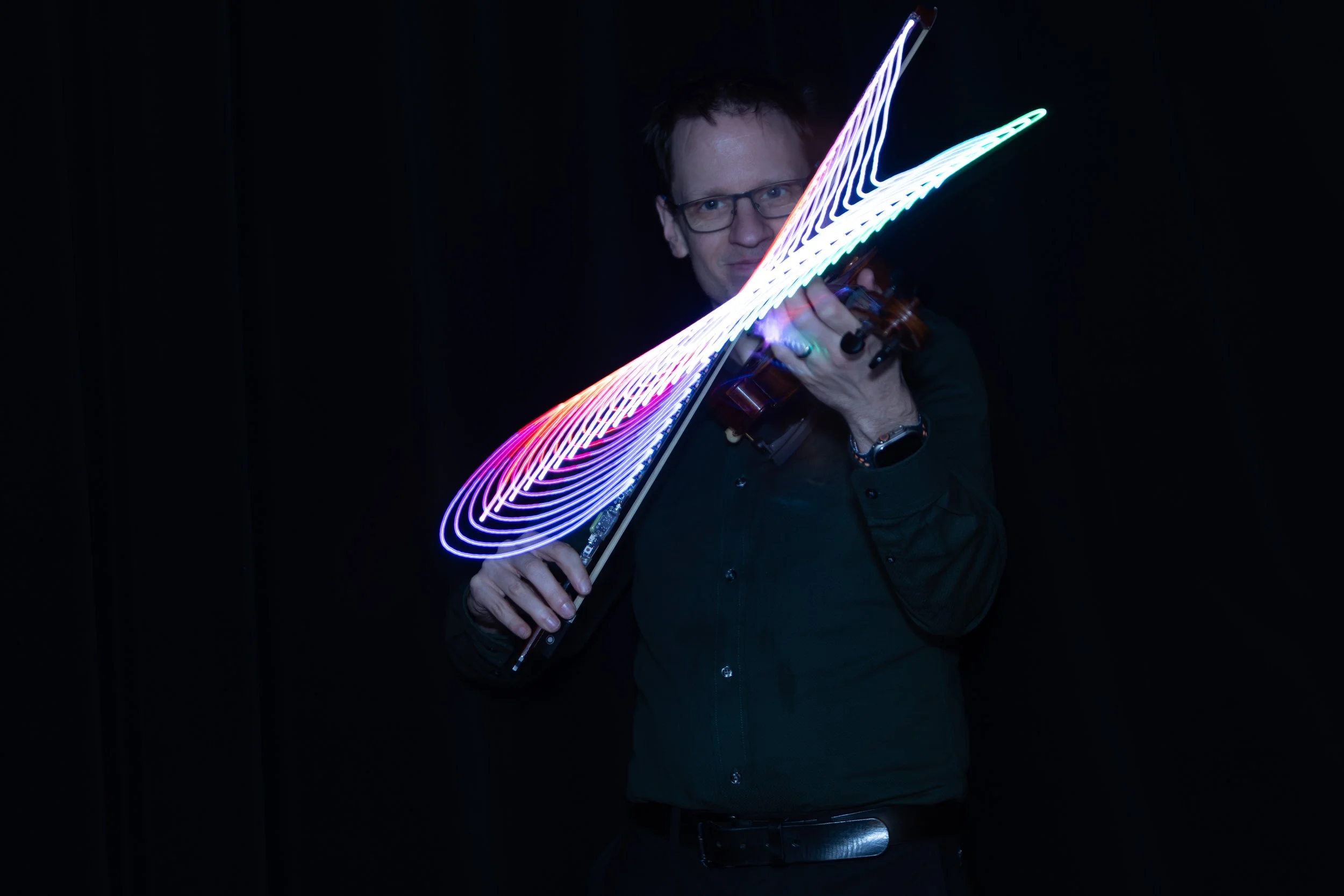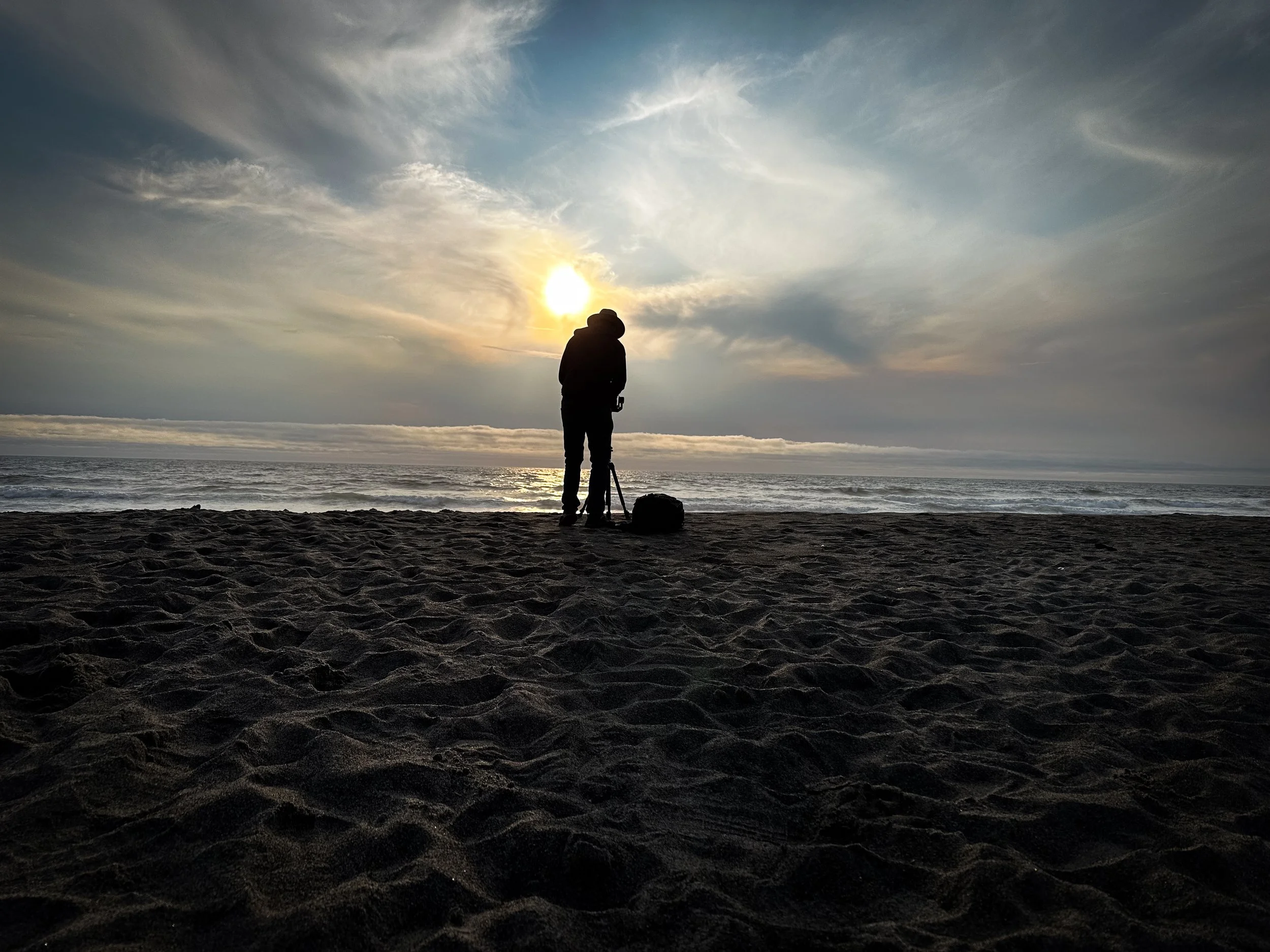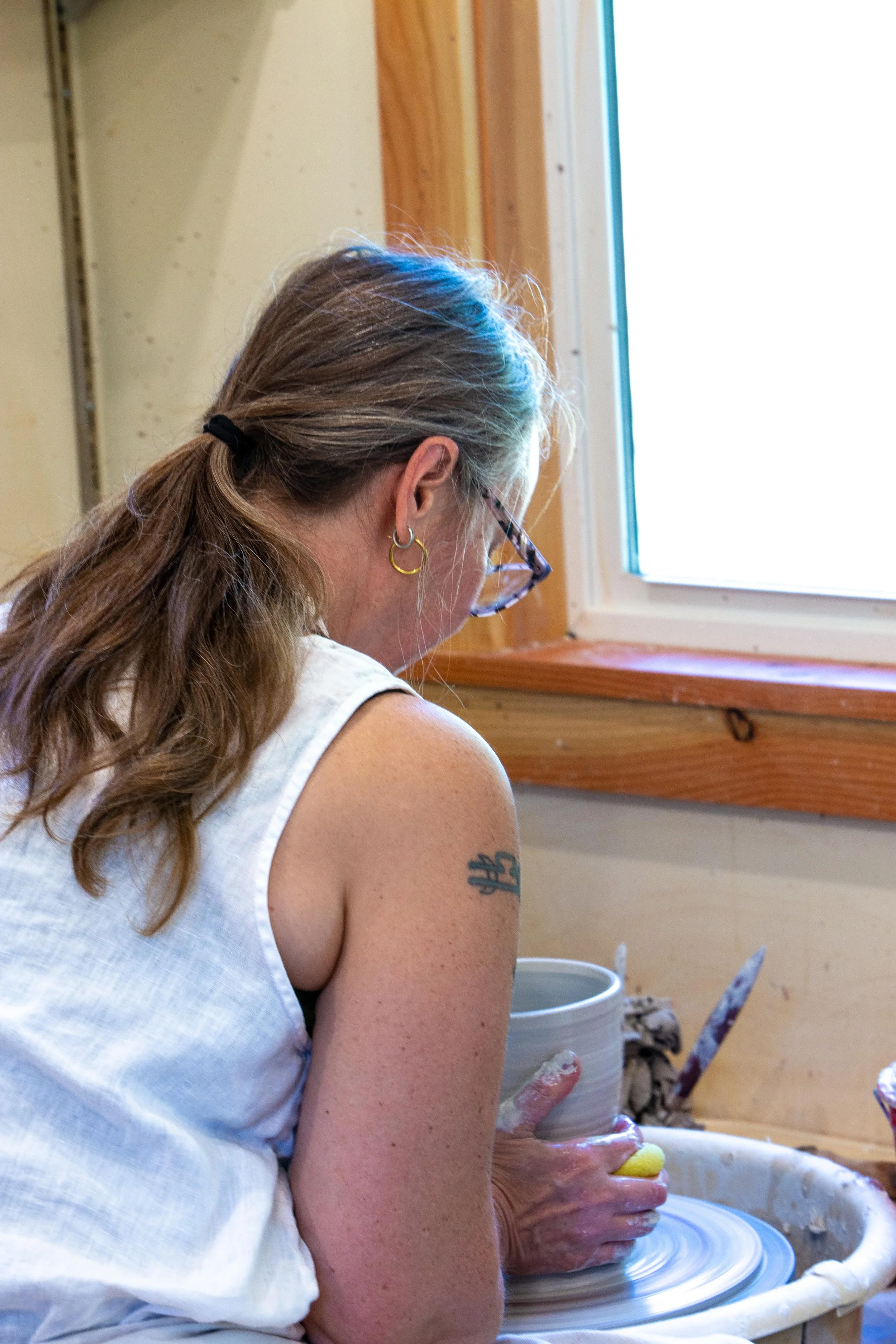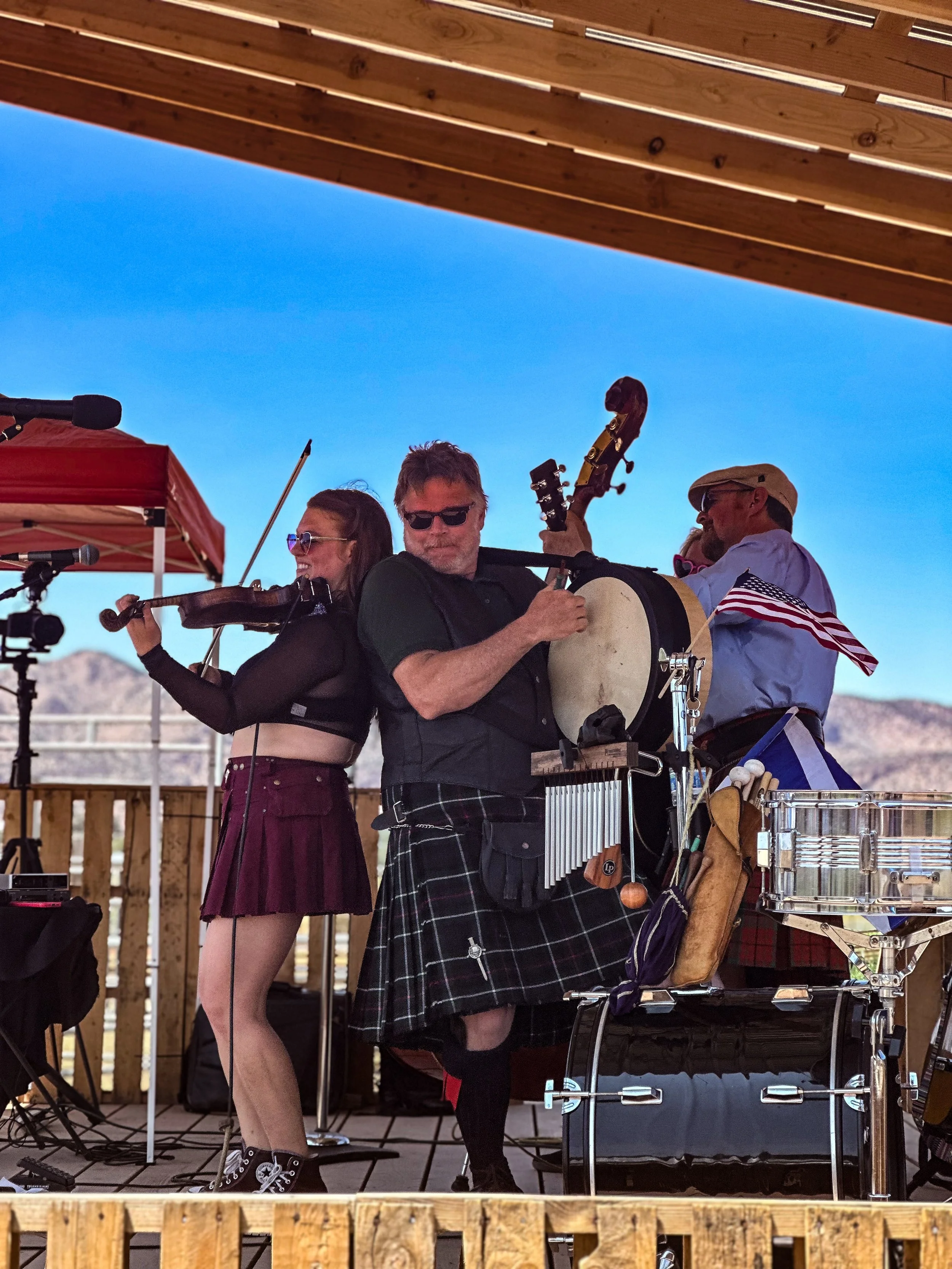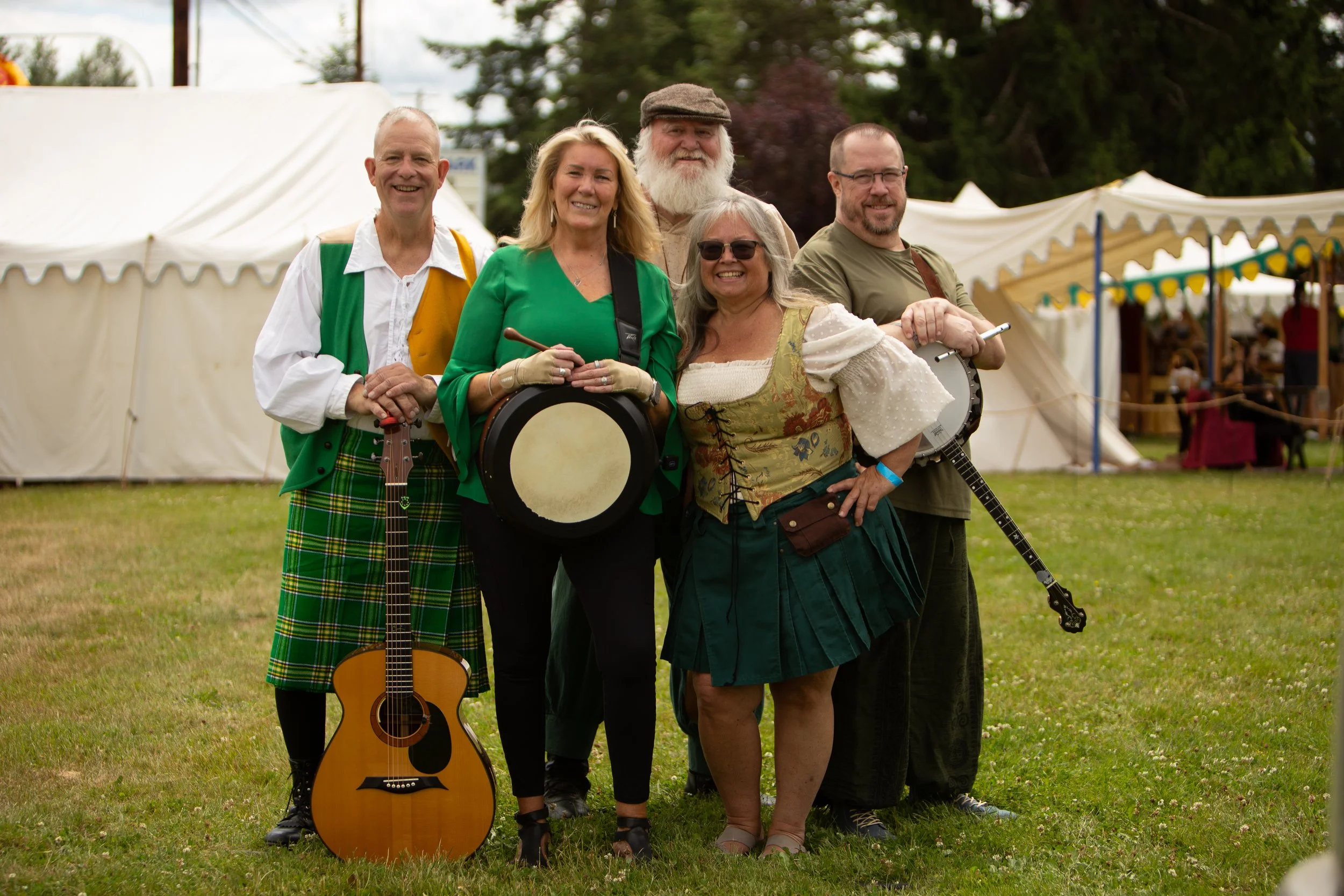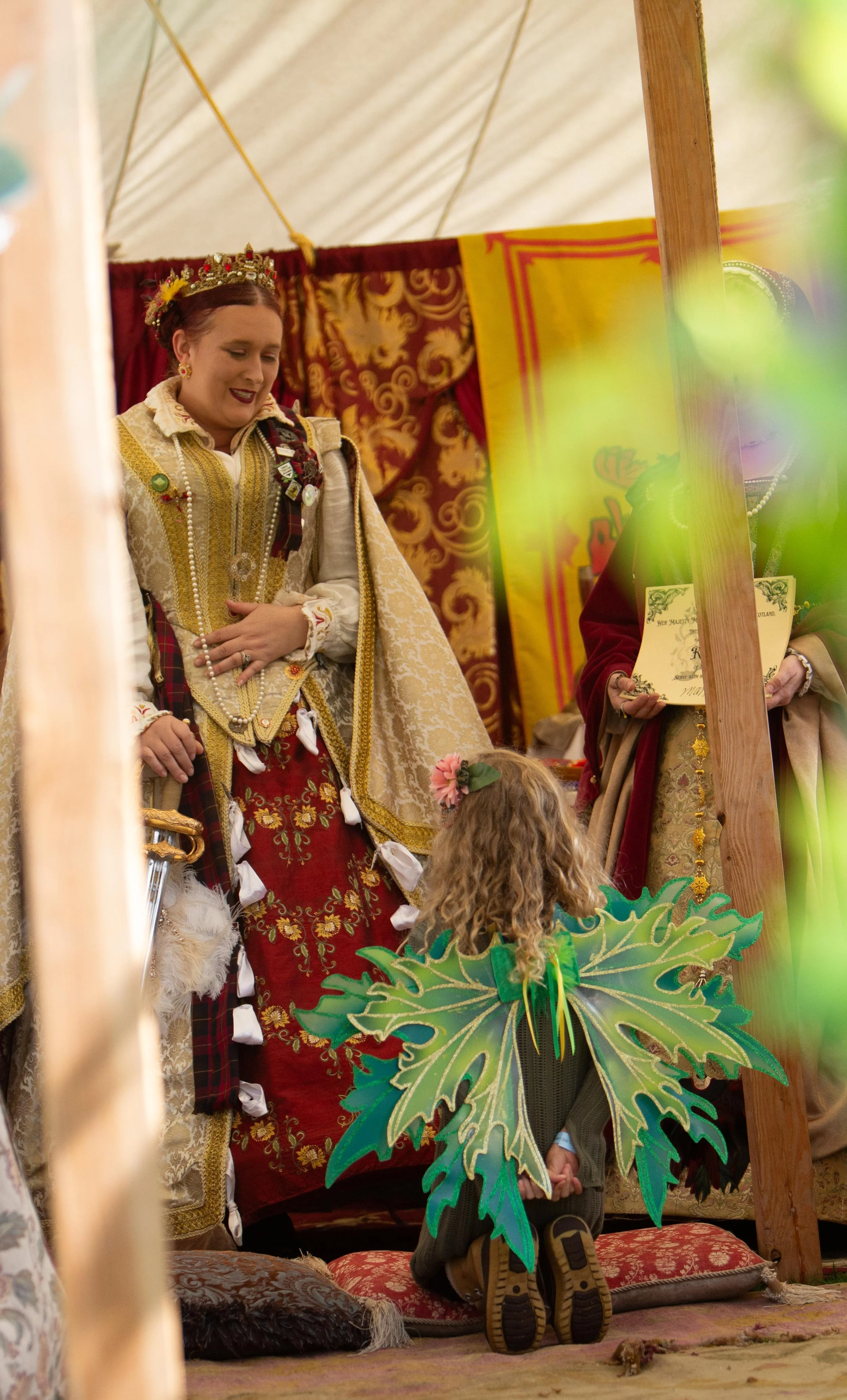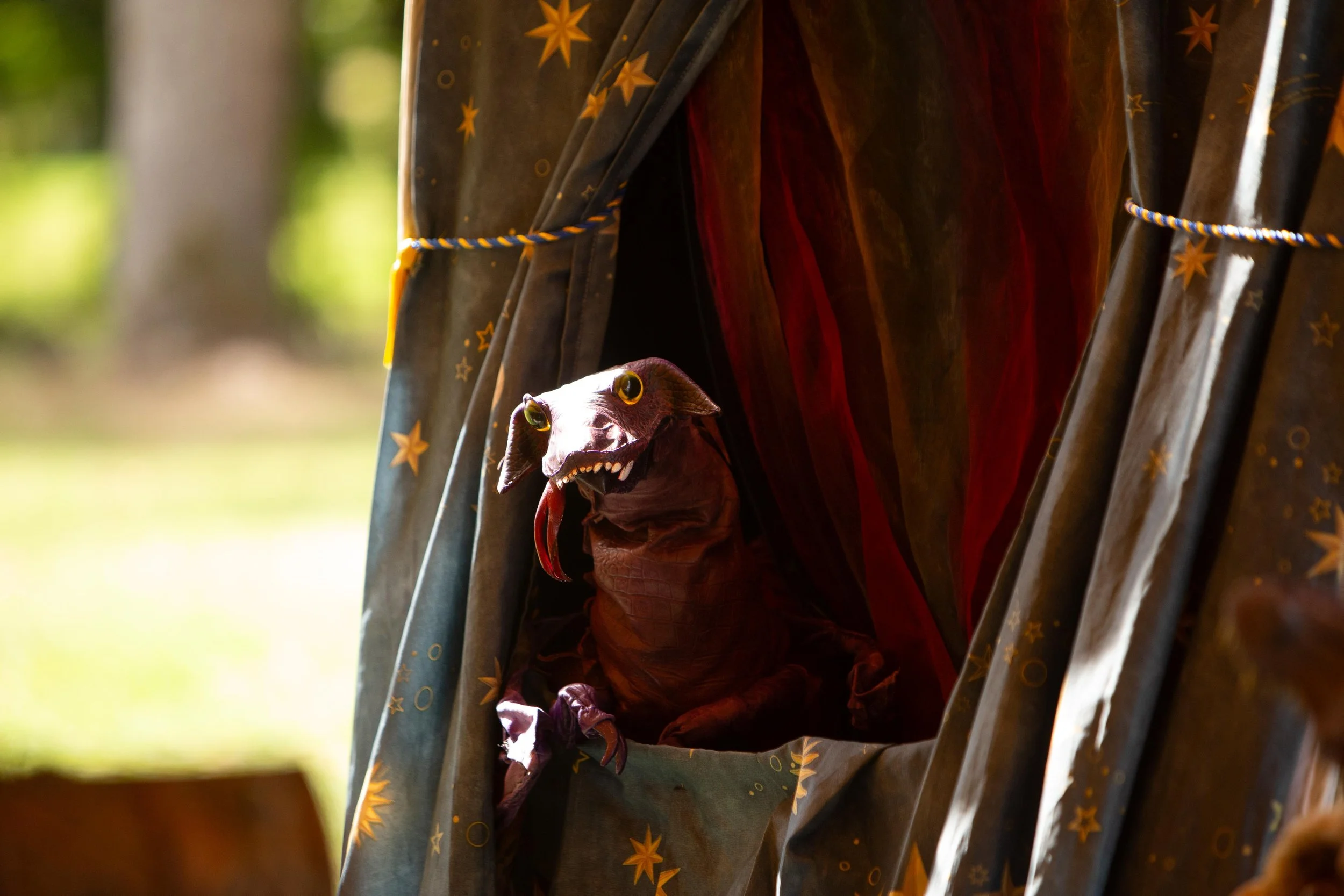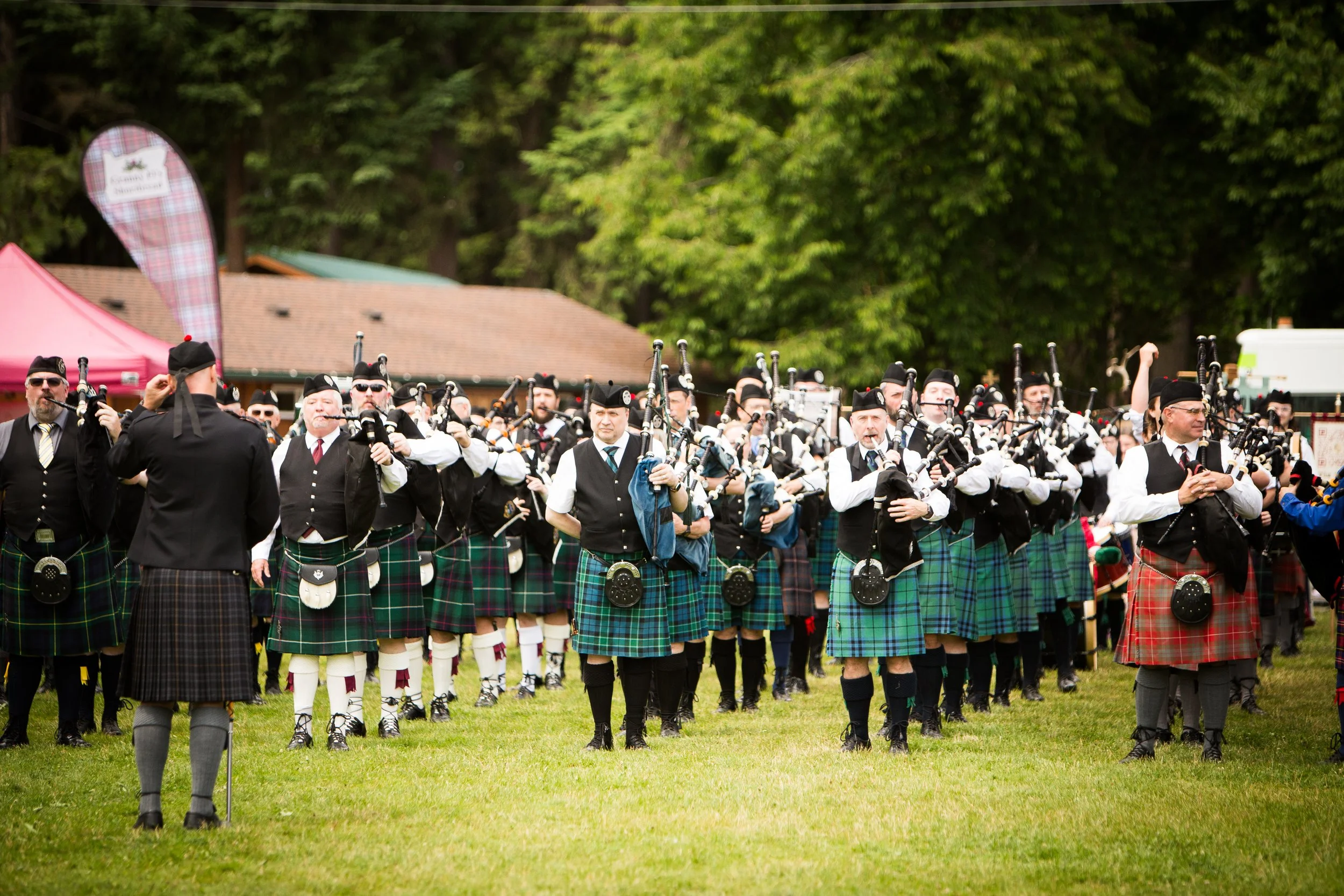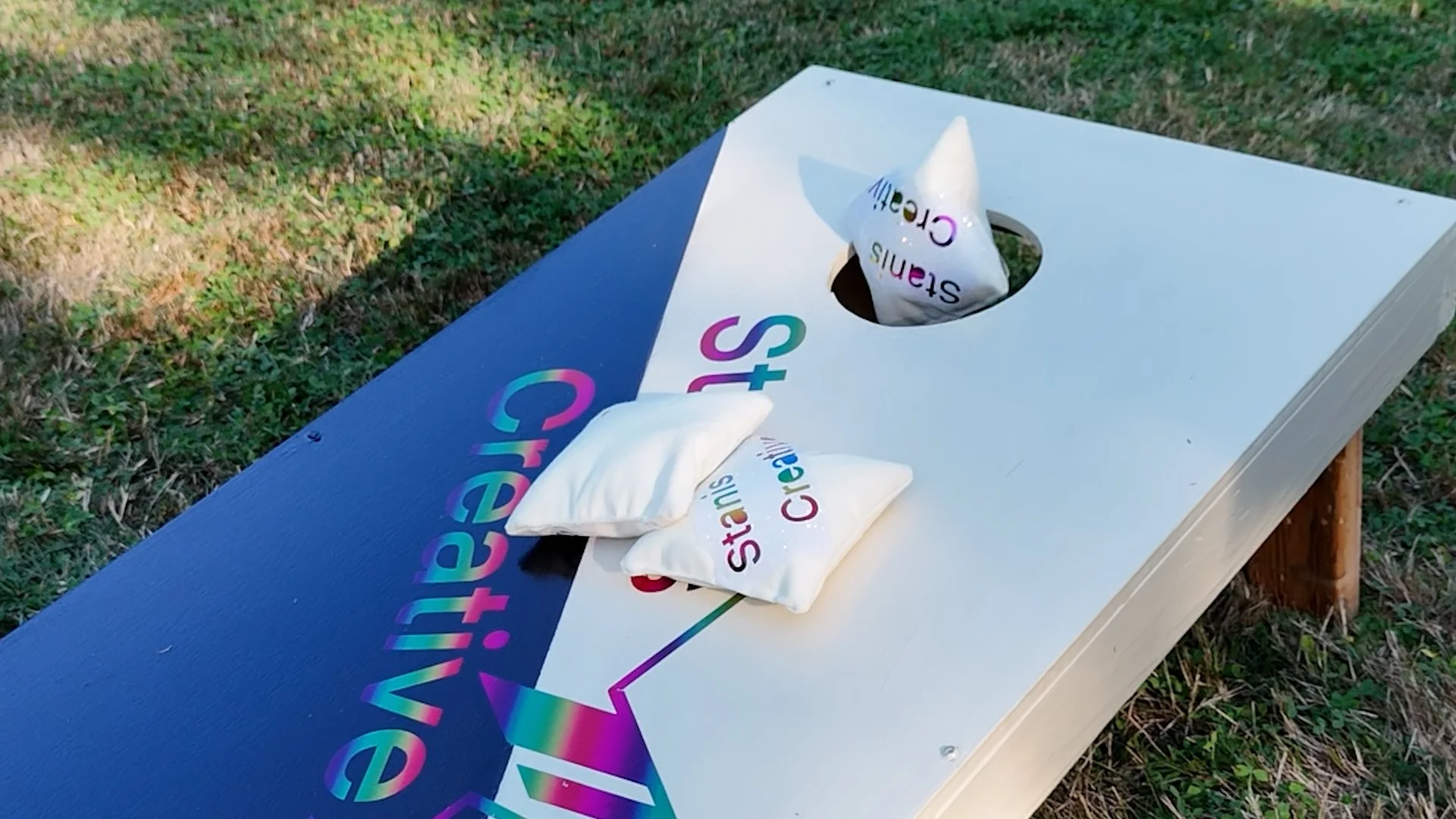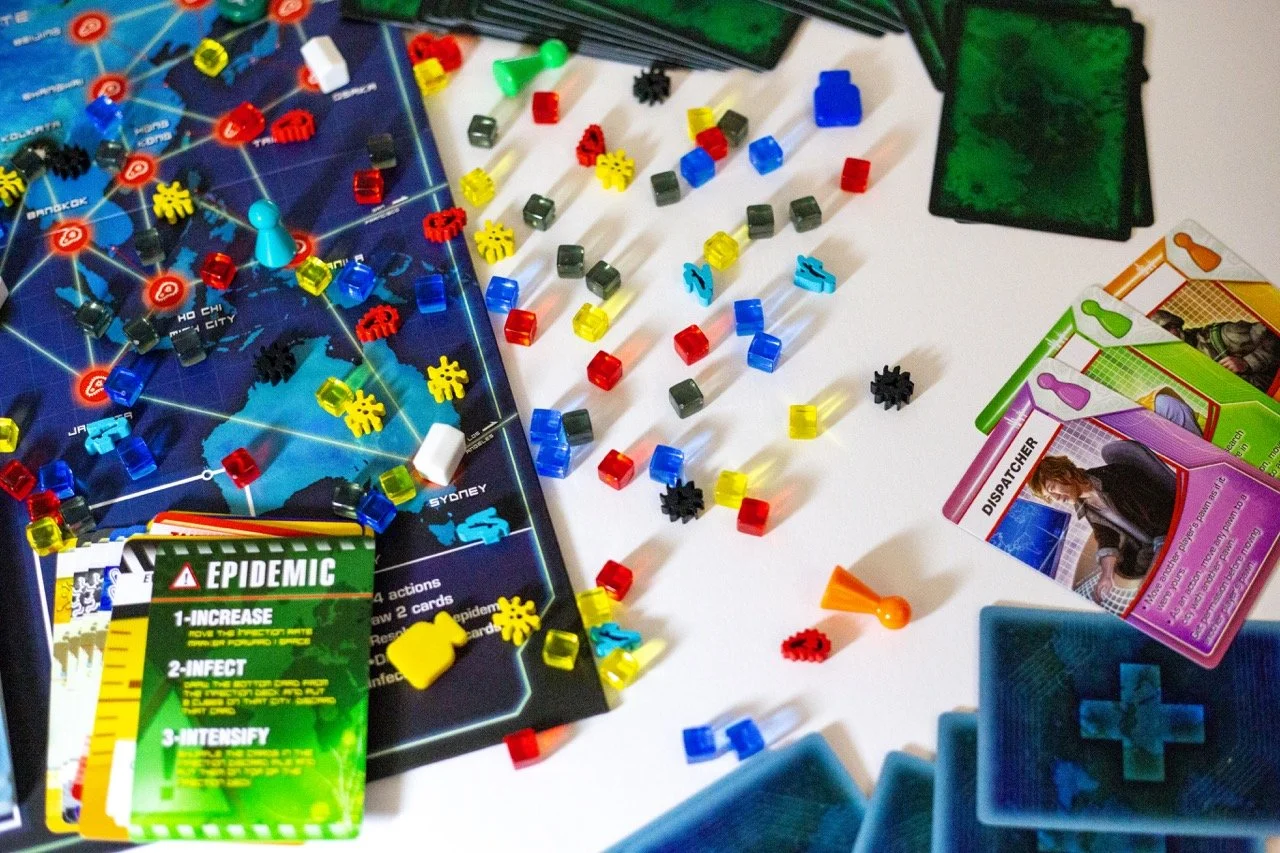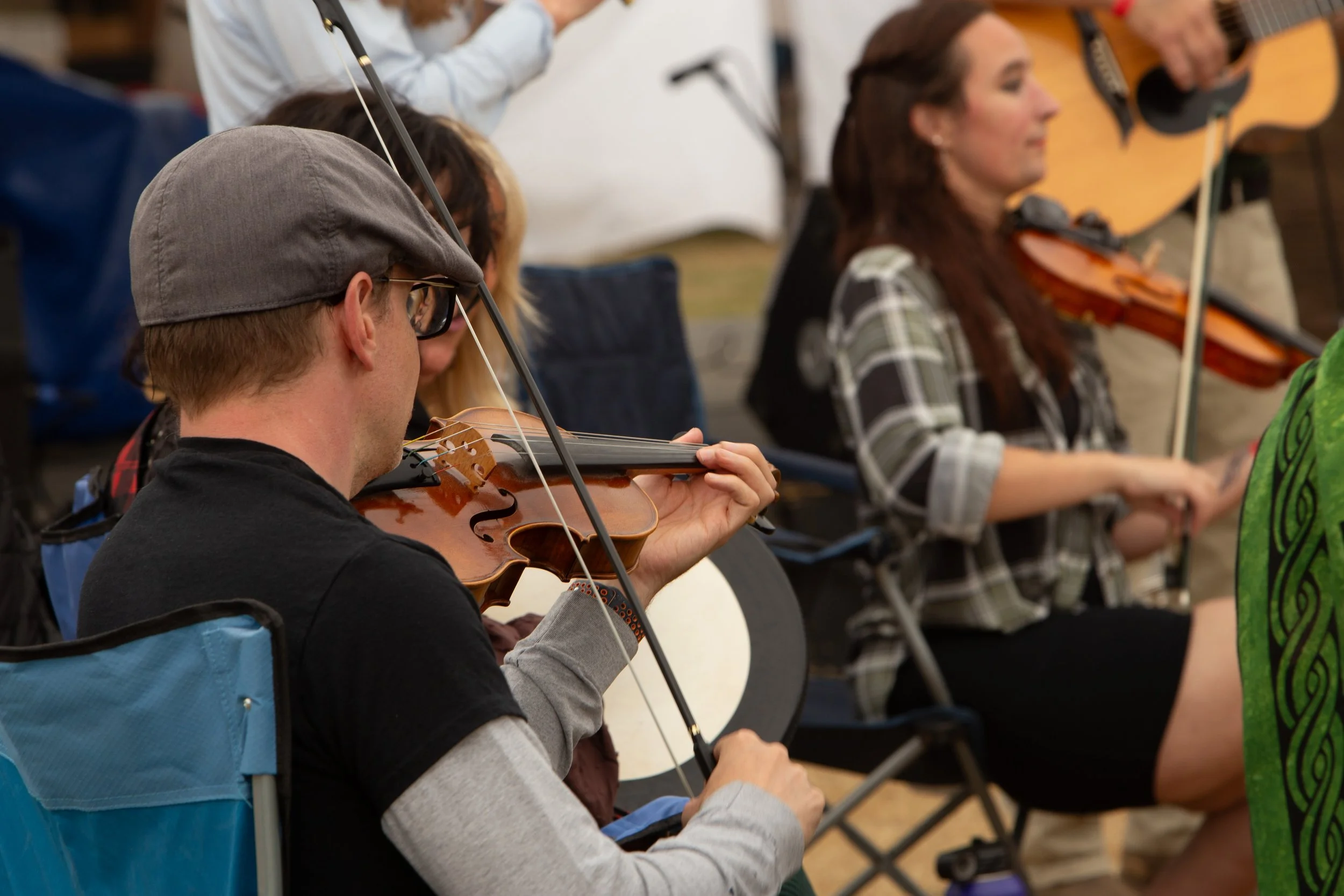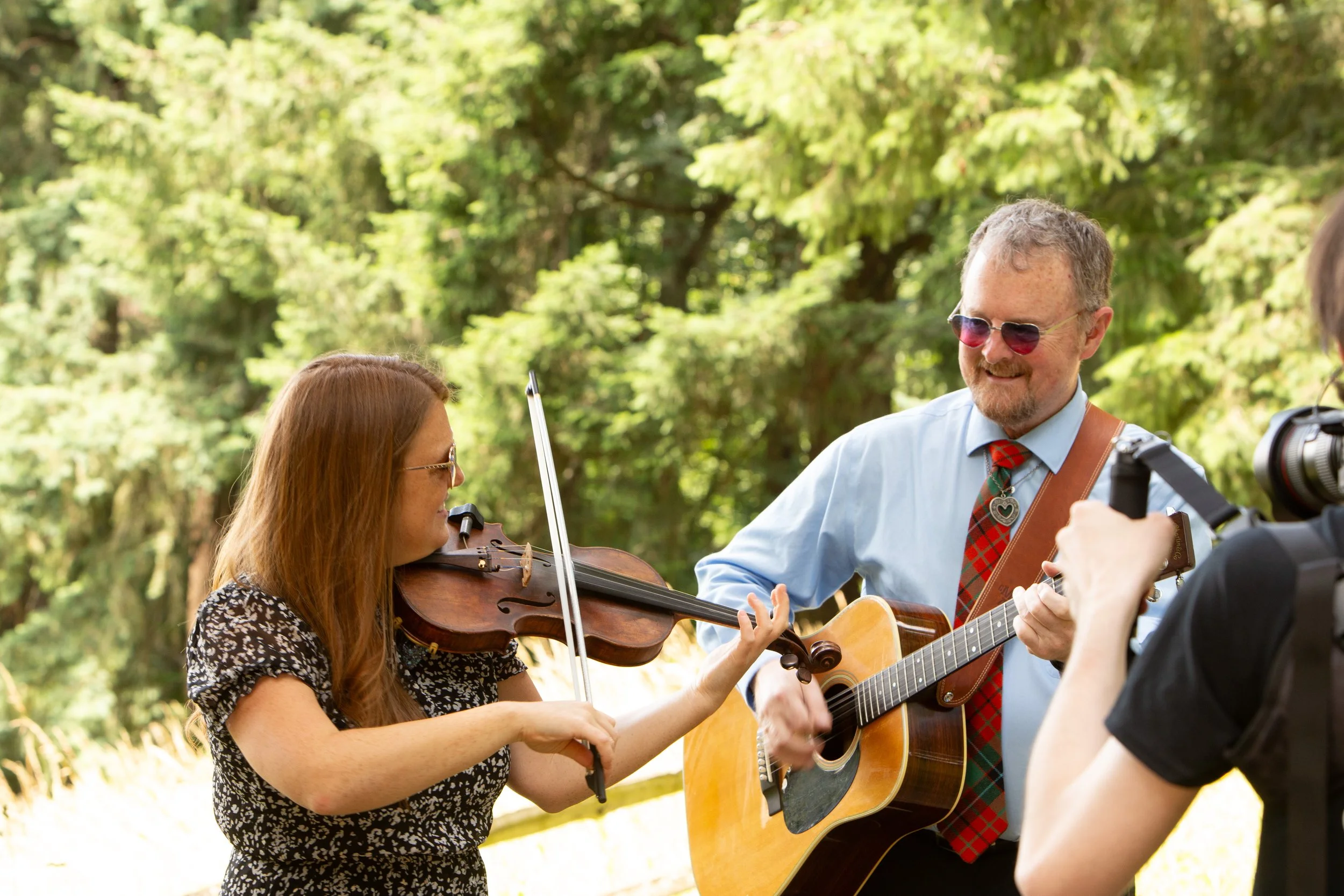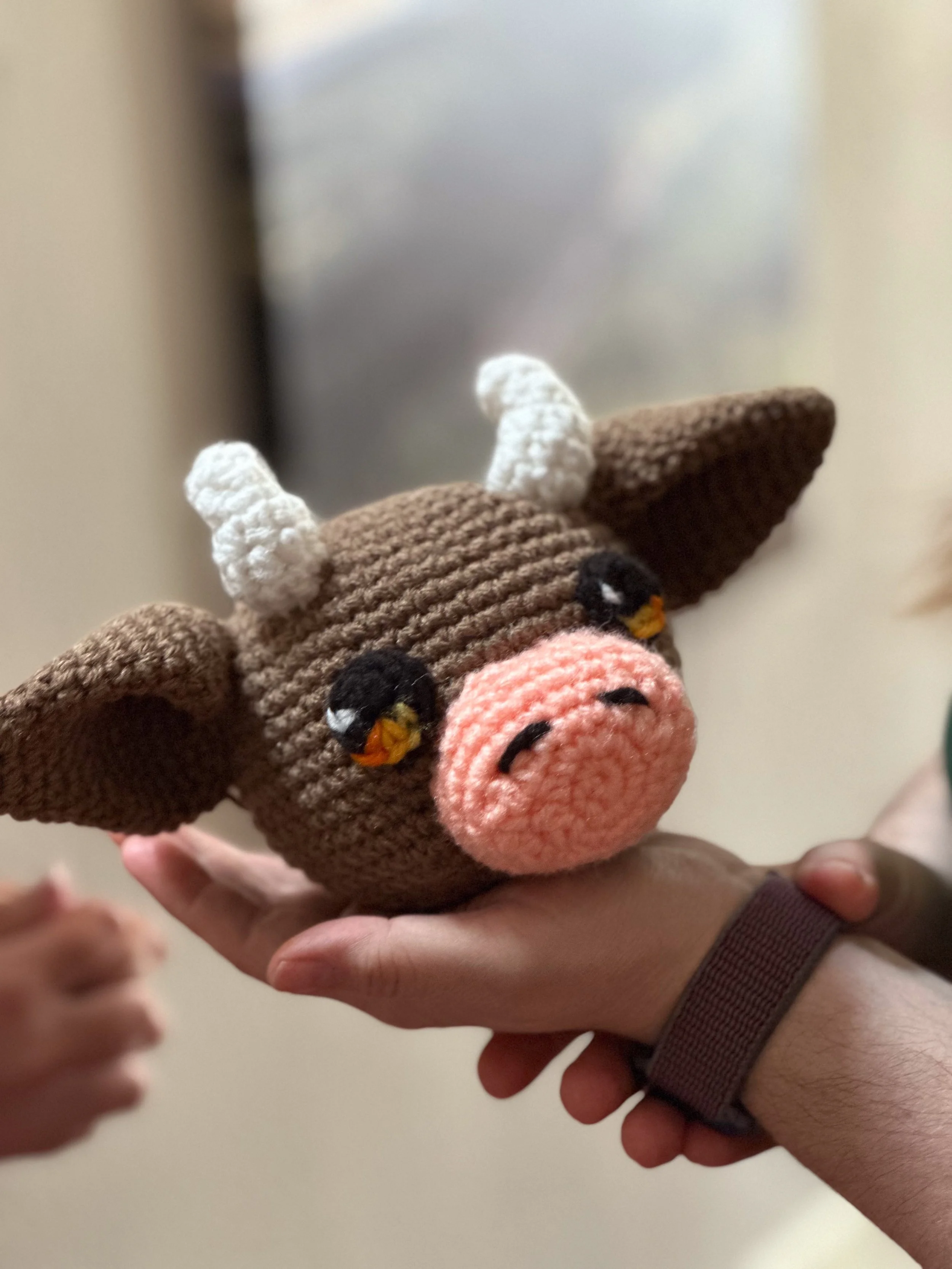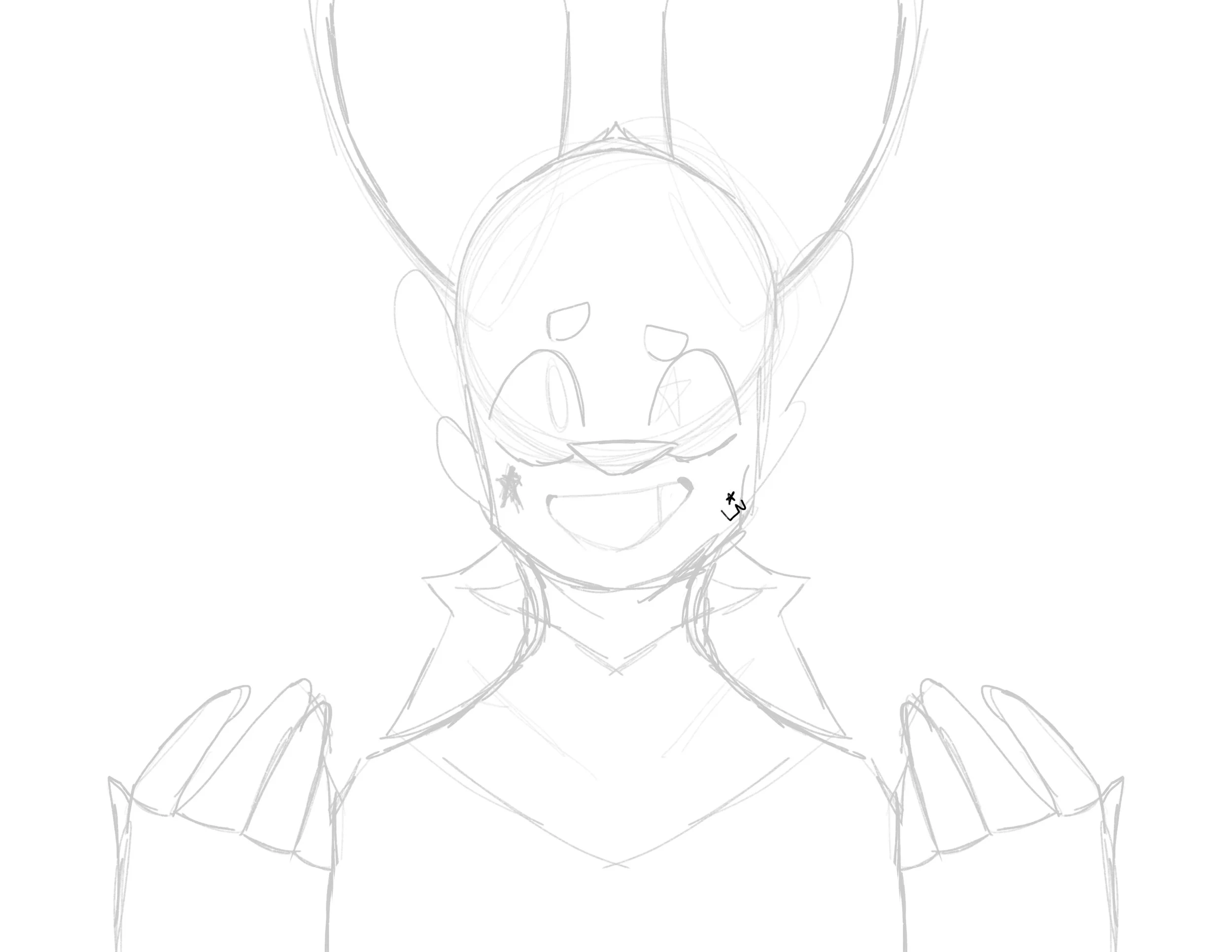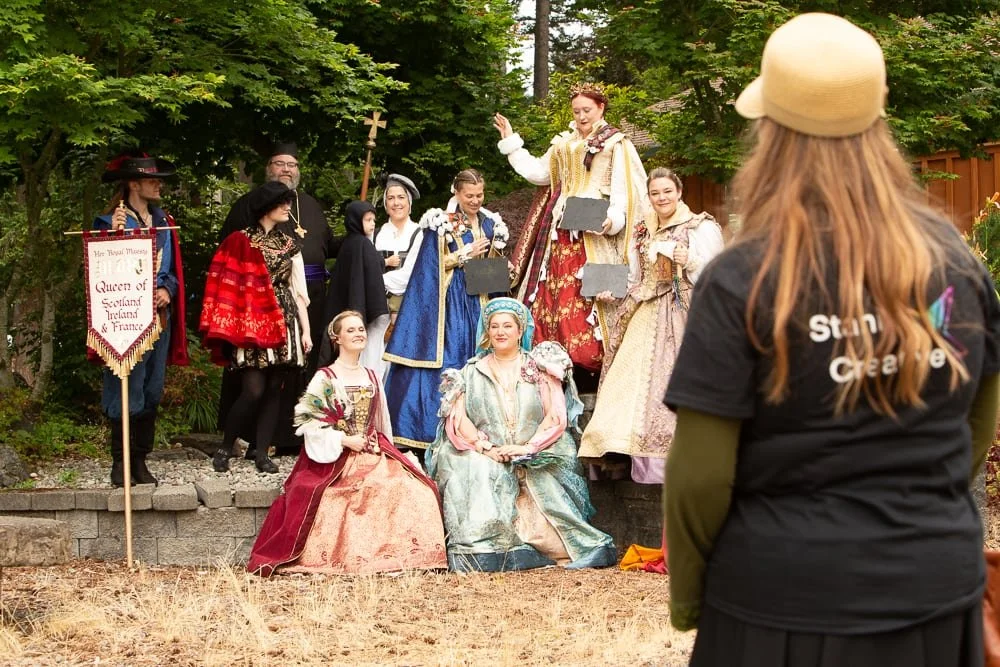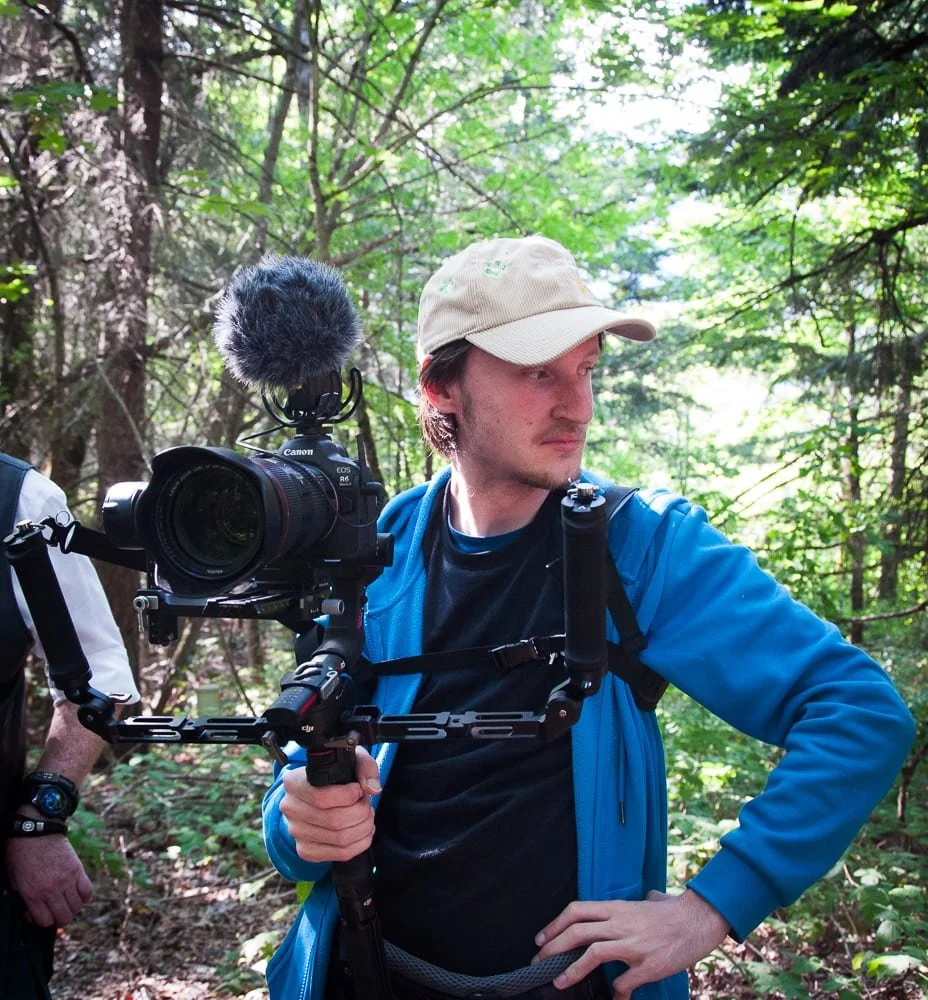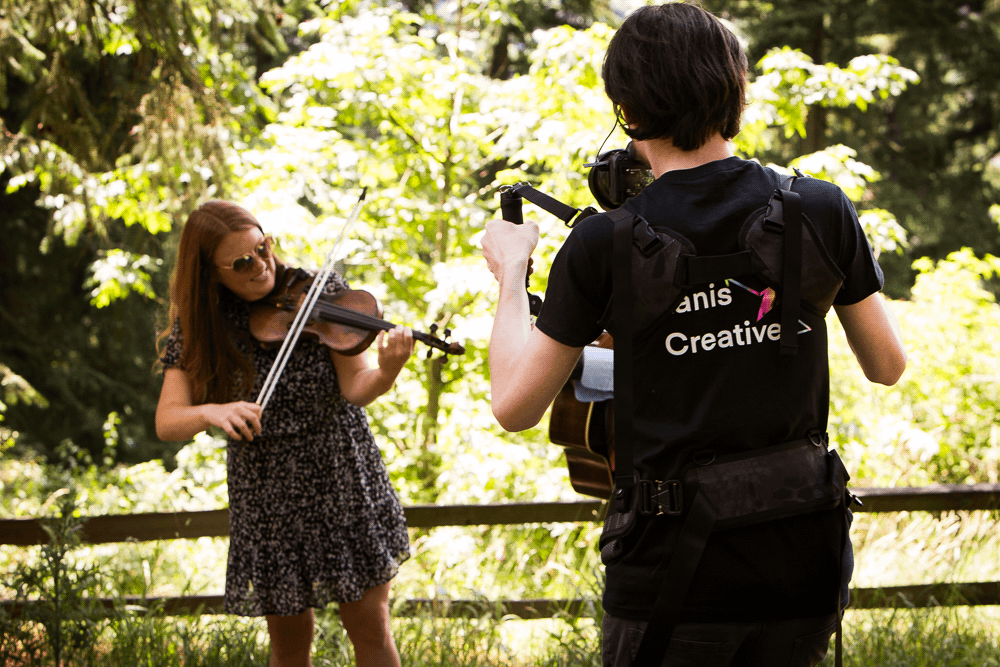Creative Compass
The Power of Storytelling Through Visual Design
Design is more than decoration—it’s storytelling. Colors, shapes, and composition weave narratives that connect people to brands, bands, and even crochet cows.
The McMinnville Scottish Festival banner at the main stage. It features several design elements that connect the festival to Scottish heritage, including Celtic knots, grapes, and an implied belt.
There are a lot of things that can catch the human eye’s attention. Colors and motion can especially draw the viewer's attention. Visual design allows creators to communicate emotion, identity, and meaning more immediately than words alone.
A single image can suggest a mood or signal a brand’s personality. When design choices are intentional, visuals can become powerful vessels for storytelling.
Why Visuals Tell Stories More Powerfully Than Words Alone
Words require processing. Visuals create sensations. It’s a common saying that pictures speak a thousand words.
A well-designed poster, logo, or character can communicate narrative elements: setting, attitude, and meaning at a glance. Visual storytelling is fast, intuitive, and when done right, it can be memorable.
Everyday Examples of Visual Storytelling
Storytelling through design isn’t limited to movies or graphic novels. It appears everywhere:
Branding
The Chocolate Lantern and Apothecary logo conveys its brand by using a dark color pallet and silhouettes of gears that convey a cozy and historical aesthetic.
A brand’s visual identity is the face of the brand itself. Color palettes, typography, and icons communicate your values: calm professionalism, bold innovation, or whimsical playfulness. A strong brand identity instantly signals what the brand is and what story it wants to tell with confidence.
Band Posters
Band posters often illustrate an entire genre or vibe without a single lyric. Textures, lighting, layout, and imagery can hint at energy (punk), atmosphere (ambient electronic), or emotion (folk storytelling).
Crochet Characters
A collection of crochet characters for sale at the Prosser Highland games.
Even fiber art conveys a story. A crochet creature like a tiny crow, cow, or fox reflects personality through its colors, posture, facial expression, and the props or scenery around it. These design choices invite viewers to imagine who the character is and what world it inhabits.
Key Design Principles That Strengthen Storytelling
Color
Color can set an emotional tone. Warm tones can signal energy or optimism; cool tones can convey calm or melancholy. Purposeful color use reinforces the story you want your viewer to feel.
Composition
Composition guides the viewer’s eye.
Balance, symmetry, the rule of thirds, and visual hierarchy shape how a viewer experiences the narrative. Good composition acts like pacing in a written story, and takes purpose and commitment to become proficient.
Emotion & Expression
Visuals should make people feel something.
Expressive forms, texture, contrast, and movement all help convey the emotional subtext of the story. The difference between a classic cartoon and a modern live-action series, for example.
Consistency
A cohesive visual language builds recognition and deepens narrative impact. It makes your product feel distinct, carefully crafted, and professional.
Tips for Creators: Infuse Story Into Your Own Design
Start with a narrative, not aesthetics. - Ask: Who or what am I designing for? What story should the viewer understand instantly?
Use color intentionally. - Build a palette that aligns with the mood, values, or personality you want to convey.
Think in scenes. - Even static designs can imply movement, environment, or character.
Let composition direct emotion. - Off-center subjects feel dynamic; symmetrical layouts feel stable and calm.
Add small details that imply history or personality. - A stitch pattern, a background symbol, and a shadow can all function as narrative hints.
Aim for consistency. - Repeated shapes, motifs, or colors build a cohesive visual story across platforms.
Every design is an opportunity to tell a story. When we treat visual elements as narrative tools and not just decoration, we create work that resonates, connects, and lingers in memory. Whether you’re developing a brand, crafting a band poster, or bringing a crochet character to life, your design choices shape the story your audience will see, feel, and remember. It is one of the most important parts of your project’s identity.
My Process With Digital Painting — Landing in the Top 10 of a Warhammer 40,000 Coloring Competition
>>Entering the competition… //
One of my Necron miniatures as an example. These guys are tiny!
Recently, I participated in the Warhammer 40,000: Mechanicus II Coloring Competition. Even though I’ve been drawing and improving my art for several years, I had never felt confident enough to join an art competition before. That changed when I discovered the Warhammer community earlier this year through a friend. I quickly became immersed in Warhammer’s rich lore, expansive universes, and its creative hobby side. After trying a few of the games, the first Mechanicus title especially caught my attention - so when I learned a second game was coming, and that a coloring competition was being held to celebrate it, I knew I wanted to participate.
For my entry, I chose to base the design on my personal Necron painting scheme! White base, gold details on the shoulders, and glowing rainbow energy for their weapons.
(For the unfamiliar: Necrons are evil undead skeleton robots. Yes, they’re as cool as they sound.)
//Reanimating My Creativity…//
Liv’s submission for the Warhammer 40,000: Mechanicus II Coloring Competition. It features a skeletal robot with glowing rainbow blades and gold plating.
The glowing rainbow blade shifts colors from pink to purple. Depth is added with a darker ue in the middle.
The piece took me roughly six hours to complete. I began by blocking in the general colors (white, black, and gold) to establish the foundation. This is important to see how your colors contrast with each other, and if they remain readable. Then comes the real challenge: shading and texture. Necrons don’t have a lot of variation in their metal textures, so I had to be intentional about adding scratches, scuffs, and small details to keep the metal interesting without overwhelming the design. I was really happy with how those subtle touches turned out!
The glowing elements, however, were by far the hardest. Creating a believable glow without using the provided glowing brushes requires constant refinement: shading, brightening, and shading again. To sell the illusion that the light is intensely bright, everything surrounding it has to be correspondingly darker. On top of that, the glow needed to be multi-colored per my color scheme. Blending hues while maintaining texture was a challenge I genuinely enjoyed. I even deepened the center of the blade to make it look as though some sort of liquid energy was flowing through it.
Because of the competition rules, I avoided adding a full background to prevent any risk of introducing extra linework. Still, I added subtle color in the corners to enhance the overall vibrancy. The character is what should stand out, and with so many colors I would risk adding too much to the piece.
//Submitting entry…//
When I submitted the final piece, it came with its fair share of anxiety. This was my first entry into a competition ever. But I was proud of what I had made, and I was encouraged by the positive feedback from the community on Discord. Seeing everyone else’s submissions was amazing as well, each submission brought more creativity and unique content when working in the restrictions given. It was so much fun to see the community come together and be creative!
When submissions closed, and the task of shortening the huge mass of submissions fell upon the judges, I woke up a few days later to a huge surprise that I would never have expected: I had made it into the top ten finalists on the Necron side.
At first, I didn’t even understand what I was looking at. I had never valued my art this highly before, and seeing it recognized in such a visible way was incredibly validating. It felt like a milestone I wasn’t sure I would ever reach.
Progress images of my submission from blocking to shading to finalizing.
//Concluding message…//
I’m incredibly grateful for this experience, and I’m truly excited to see how the final results unfold. Voting continues through the end of the month and I highly recommend checking out the finalists’ entries if you get the chance! Every single piece is a testament to the creativity and passion of the Warhammer community.
Great job to everyone who participated, and those of you who made it to the shortlists!
Wishing everyone the best of luck,
Signed, Liv
The Creative’s Guide to Designing Email Newsletters That People Actually Want to Read
A great newsletter feels like hearing from a friend. Whether it’s updates, stories, or new releases, consistency and authenticity are key to keeping your audience connected.
Jonathan and Julie on a boat.
A great newsletter feels like hearing from a friend. It’s not just another piece of marketing — it’s a moment of connection. Whether you’re sharing your latest creation, a behind-the-scenes story, or a special offer, your email should sound like you. That’s how you build trust, connection, and a creative community that lasts.
Why Newsletters Matter for Creatives
Jonathan smiling at the camera.
Social media is noisy. Algorithms shift, trends fade, and posts disappear in the scroll. But email? It’s direct. Personal. Chosen. When someone signs up for your newsletter, they’re saying, “I want to hear from you.”
For creatives — artists, musicians, makers, writers, and storytellers — newsletters do more than promote. They build consistency and community. They keep your name, your story, and your craft in your audience’s world, even between projects or events.
Think of your newsletter as your digital campfire — a place where your community gathers to hear what’s new, what’s next, and why it matters.
Define Your Newsletter’s Goal
Before designing or writing a single sentence, ask yourself: What do I want this newsletter to do?
Here are a few common goals:
Sales: Promote new products, artwork, or event tickets.
Updates: Keep fans or clients in the loop about upcoming shows, drops, or launches.
Storytelling: Share your creative process, inspiration, or personal journey.
Education: Offer tutorials, insights, or resources that help your audience grow.
Community Building: Celebrate customer stories, collaborations, or milestones.
You don’t have to pick just one — but knowing your primary purpose will guide your design, tone, and structure.
Structure That Keeps Readers Engaged
Think of your newsletter like a short story — it should have a rhythm and flow that keeps readers scrolling. Here’s a tried-and-true structure:
1. Header / Banner
Your logo or a simple, recognizable image. Keep it clean — this sets the tone for your brand.
2. Greeting or Hook
A quick intro that feels conversational. “Hey friends,” “From the studio this week…,” or “Behind the scenes at last weekend’s festival…” all work great.
3. Main Story or Feature
One focused highlight — your latest artwork, video project, or event. Add a few lines about the why behind it. This is your storytelling moment.
4. Visuals
Images make all the difference. Use high-quality photos or artwork that show your craft and personality.
5. Call to Action (CTA)
Guide your reader: “Watch the new video,” “Shop the collection,” “Read the full story,” or “Reply and tell me what you think.” Clear, simple, and inviting.
6. Sign-Off
Close like a person, not a company. “See you next week,” “With creativity,” “From our family workshop,” — whatever fits your voice.
Design Tips for Creative Businesses
Keep It Simple: Don’t overload with text or colors. White space gives your content room to breathe.
Use Consistent Branding: Fonts, colors, and tone should match your website or social feeds.
Make It Mobile-Friendly: Over 60% of readers open emails on their phones — test your layout.
Prioritize the First Impression: The subject line and preview text decide whether your email gets opened. Keep it clear and friendly.
Include Personality: A personal note or small anecdote humanizes your message.
Finding the Right Frequency
Liv capturing different perspectives!
The perfect schedule depends on your capacity and your audience’s expectations.
Monthly: Ideal for artists juggling multiple projects — a round-up of what’s new and what’s coming.
Bi-weekly: Keeps momentum without overwhelming readers.
Weekly: Great for content creators or musicians with ongoing stories or releases.
The key is consistency — it’s better to send one meaningful newsletter each month than four rushed ones that feel impersonal.
Examples of Creative Newsletters That Work
Our newsletter example with labels!
The Studio Journal: A monthly note from an artist sharing new works, upcoming markets, and one personal reflection from their sketchbook.
Maker’s Dispatch: A bi-weekly email with short video clips, product drops, and vendor shoutouts from local fairs.
The Storyteller’s Note: A weekly message from a writer blending updates with a mini-essay about creativity and process.
Each one works because it’s authentic, visually cohesive, and built around relationship, not just sales.
Start Simple, Stay Consistent
Don’t wait for the perfect design or a massive list. Start with a small audience and a clear message. Every email is a conversation — an invitation for your community to grow with you.
Remember: your subscribers signed up because they want to hear from you. So tell your story, share your process, and let your newsletter become a creative space of its own.
(Signed with Ink, Yarn, and Pixels -Stanis
Creative)
What It Takes to Put on a Festival: Behind the Scenes of Community Magic
Ever wonder what it really takes to bring a festival to life? From permits and staging to community collaboration, step behind the curtain with us and see how the magic truly happens.
The audience claps along to a song.
Festivals might look effortless from the outside, but behind every sound check, dance, and vendor tent is a small army of passionate people (often volunteers). We’ve had the privilege of seeing it firsthand, and it’s nothing short of magical.
The Morning Magic Before the Gates Open
There’s nothing quite like the first morning of a festival. The sun rises over the grounds, casting golden light on a flurry of activity. Vendors unload boxes of hand-crafted goods, stages come alive with sound checks, and volunteers rush between tents with coffee in hand. There’s a hum in the air, an anticipation that something extraordinary is about to begin.
From the outside, it looks like spontaneous magic. But behind that moment are months, sometimes years, of planning.
The Hidden Work Behind the Scenes
Every festival is a small city built from scratch. Power lines and staging, safety checks and sanitation, permits and insurance, each piece must come together in perfect timing. Vendors coordinate deliveries, musicians finalize setlists, and organizers juggle logistics that most of us never see.
Setting up a canvas tent at Realms Unknown.
Then there are the volunteers, who make the impossible seem effortless. They direct parking, clean up spills, guide guests, and keep the rhythm flowing so the magic never falters.
Collaboration and Community
No festival happens in isolation. It takes the combined creativity of artists, organizers, and the local community to make it thrive. Behind the booths and stages are long conversations about layout, accessibility, storytelling, and connection.
When it works, it’s because everyone shares the same vision: creating a space where people can step outside the ordinary and feel part of something bigger.
Lessons from the Field
At Stanis Creative, we’ve had the privilege of capturing that behind-the-scenes energy at festivals like the McMinnville Scottish Festival, Vashon Highland Games, and Realms Unknown. Each has its own vibe, but they all share one thing: heart.
The best moments often happen when the cameras aren’t rolling, everyone pitching in to reset a fallen tent, an artist lending tools to another, a tired organizer grinning as the first guests arrive. These are the real stories that make festivals unforgettable.
Clay artisan at a festival from this season.
The Payoff: Seeing It All Come Together
When the gates open and the first notes of music drift across the scene, the months of late nights and problem-solving fade into the background. What remains is pure, collective joy. The laughter, the applause, the sense of belonging, it’s why so many people pour their time and energy into bringing festivals to life year after year.
A Final Reflection
Festivals are more than events; they’re living proof of what communities can create when passion meets purpose. They remind us that magic isn’t something you stumble upon, it’s something you build, together.
How to Create Scroll-Stopping Videos That Convert
In a World of Endless Scrolling, Connection Is the Real Currency
Every swipe, tap, and scroll is a chance for your story to be seen.
On social media, video has become the universal language of engagement. Whether it’s a behind-the-scenes clip, a product demo, or a heartfelt message from your team, the right video doesn’t just get views. It builds trust, connection, community, and conversions.
So how do small businesses and creators make videos that actually stop the scroll? Let’s break it down!
Why Video Dominates Social Media Engagement
Videos are the heart of digital storytelling. Fresh Move Media says, “Studies show that users spend up to 88% more time on pages with video, and social posts with video generate up to 1200% more shares than text and image posts combined.” That’s because video does what static content can’t: it conveys emotion, movement, and personality.
But it’s not just about the numbers, it’s about human connection. Video allows your audience to see you, hear your voice, and feel the passion behind your brand. It’s dynamic, relatable, and digestible, especially on mobile devices where short-form video is more common.
When you tell your story through video, you’re showing your purpose.
Understanding Each Platform
Each platform rewards different types of video content. Knowing the culture, tone, and algorithmic preferences of each is key to maximizing reach and engagement.
Instagram Reels
Reels are built for discovery. Keep them upbeat, visually engaging, and branded in your signature style. Use trending audio sparingly, it helps boost visibility but should still feel authentic to your brand.
Length: 7–15 seconds works best. You can post reels up to 3 minutes, however the algorithm prefers videos to be shorter than this. You will get more promotion by keeping your reels below 3 minutes.
Tip: Start with the main action to hook attention, and use subtitles!
YouTube Shorts
Shorts are ideal for education and storytelling. Viewers expect more context here, so you can go a little longer while still keeping it fast-paced.
Length: 15–60 seconds.
Tip: End with a cliffhanger or call-to-action (“Watch the full video on our channel”) to pull viewers into your longer content. Or you can make a neat looping effect!
TikTok
TikTok thrives on relatability and creativity. Audiences here want authenticity over polish. Think storytelling, quick tips, or personal insight from your brand’s perspective.
Length: 9–20 seconds is the sweet spot.
Tip: Use captions and text layers to emphasize emotion or key phrases, since many people scroll with sound off.
Matching Video Length, Tone, and Format to Your Audience
The most effective videos meet your audience where they are, both literally and emotionally.
Length: Keep it short enough to respect attention spans but long enough to say something meaningful.
Tone: Match the mood to your message. A playful brand might use humor, while a service-based business may focus on empathy and clarity.
Format: Vertical video dominates (9:16), but you can experiment with square (1:1) for feed posts, or horizontal (16:9) for YouTube and websites.
Most importantly show people, not just products. Faces drive engagement. Whether it’s you, your team, or your customers, human presence builds trust, warmth, and can bridge the gap between corporation and community.
Consistency, Storytelling, and Authenticity
The best social video strategies are built on consistency.
Consistency: Post regularly and stay within a visual and tonal identity. Familiarity breeds connection.
Storytelling: Even 10-second clips can tell a story! Use a simple arc: hook, reveal, takeaway.
Authenticity: Don’t chase trends that don’t fit your brand. Viewers can spot forced content easier than you think. Be real, be kind, and be creative.
One easy framework to remember:
Educate, Entertain, or Emotionally Connect.
If your video does at least one of these things, you’re building value, not just visibility.
Measuring Success and Adapting Your Strategy
Views are only part of the picture. Measure what matters:
Engagement: Likes, comments, saves, and shares show your content resonates.
Watch Time: Indicates whether viewers are staying through the full clip.
Click-Through Rate (CTR): Reveals how effectively your video drives traffic or conversions.
Follower Growth: Signals that your storytelling is turning viewers into a community.
Track performance monthly and refine your approach. Which topics or tones perform best? Do certain types of videos convert more followers to customers? Use these insights to guide your next batch of content.
Remember: algorithms evolve, but authenticity and storytelling never go out of style.
How Small Businesses Can Stand Out in the Scroll
You don’t need a massive budget to make an impact. What matters most is intention. Use what you have; your phone, your voice, your story, and build from there. Plan, post, and learn with each video. It takes time to grow, why not learn while your building?
Brands that will thrive are the ones that feel human. The ones that show behind the curtain, share their process, and talk with (not at) their audience.
In a world of endless scrolling, your next video could be the one that makes someone stop, and say,
“This is exactly what I was looking for.”
Elevating the View: Using Drones for Videography
From soaring overhead shots to sweeping crowd views, drones give us the ability to tell stories from entirely new perspectives. At Stanis Creative, drone videography has become one of our favorite tools for capturing festivals, music, and community events in ways that ground cameras simply can’t.
Liftoff
Cinematic, beautiful, and offering a fresh point of view, these are just a few of the things drones can deliver. Small and agile, these quadcopters open up the skies, allowing us to see the world from an entirely new perspective.
Why Use a Drone?
Drones are remarkable little machines capable of capturing unique vantage points such as sweeping aerials, crowd shots, surrounding landscapes, and breathtaking vistas. With the right technique, they can add cinematic quality to your footage, engaging viewers through dynamic movement and fresh perspectives within a scene.
Getting Started with Drone Videography
Beginning the drone journey is relatively simple. For recreational flying, you must complete a basic drone safety quiz and earn a passing score to obtain a recreational license. We took the FAA-approved Drone TRUST course, which teaches the rules and regulations for recreational drone flying in the United States—where it is safe to fly, how to handle different weather conditions, and more. Once you complete the course and receive your certificate, you may fly in accordance with recreational rules.
Flying drones commercially, however, requires a greater investment of both time and money. To obtain a commercial license, we enrolled in Part 107 Made Easy from Pilot Institute—a more comprehensive course designed for professional use. Following this, there is the actual 107 test, a federally mandated test used to certify drone pilots to fly them commercially.
Of course, learning the rules is only part of the process. We also had to learn how to operate a drone effectively. To start, we purchased the DJI Flip, a lightweight, compact model offering 30 minutes of flight time on a single charge. After several test flights, we began to get a feel for the controls and overall flight behavior. We are still learning, but each new shot shows noticeable improvement.
Applications in Creative Projects
Drones can capture the scope and energy of gatherings and festivals, providing valuable context by showing how different areas of an event connect. They can create dramatic reveals or sweeping overhead shots of venues, products, or landscapes. Ultimately, they are powerful tools for achieving strikingly different perspectives that enhance visual storytelling.
Challenges With Flying
Owning a drone capable of capturing high-quality video is exciting—but not without its challenges. Weather poses significant issues for any filming equipment, but while ground-based gear can be shielded with tarps and sandbags, drones are far more vulnerable. Rain and wind can easily threaten their stability. Strong gusts can blow a drone off course or, in severe cases, knock it out of the sky entirely. A short drop can mean the end of your aircraft.
Lessons Learned & Tips
Always scout your shooting locations in advance to identify safe areas for takeoff, landing, and filming.
Bring spare batteries and memory cards—you never know when you’ll need them.
The DJI Flip does not record audio; even if it did, the rotor noise would overpower everything else. You will need a separate audio source.
Fly slowly and steadily for smoother, more cinematic footage.
Combine drone footage with ground-level shots to create a complete, cohesive story.
Touchdown
Overall, drones complement ground-based videography beautifully, enhancing storytelling with stunning aerial perspectives. They are accessible, versatile, and capable of delivering truly cinematic results.
We encourage you to explore how aerial videography can elevate your own storytelling and filmmaking!
From Stage to Screen: How to Turn Event Footage Into Powerful Marketing Content
The event may be over, but the story isn’t. Event footage can become powerful marketing content—highlighting energy, connection, and authenticity long after the lights go out.
The Question
Jonathan playing his violin during a jam session.
During an event, we at Stanis Creative capture all kinds of footage. Hours upon hours of it! But how does that mountain of raw video become a polished, story-driven marketing piece?
First Step Off SD-Card Lander
The first step in bringing the stage to the screen is sorting the footage. You can’t uncover a story until you know what you have, organized and ready to work with. We go through every clip, carefully naming each file and identifying the moments that could shape a powerful narrative.
The Editing Of A Story
Once everything is sorted, we move on to editing. This is where the movie magic happens. From the gathered footage, we create reels, teasers, testimonials, and long form videos that tell the story of the event. Whether it’s for social media, advertisements, website content, or any other digital marketing need, we create it and deliver it.
Highlights
Jonathan working the camera at a show!
We also love to highlight the unique and exciting things happening at each event, especially by supporting fellow small businesses we meet along the way. We interview them, film B-roll of their craft in action, and carefully cut it all into promotional videos that help showcase their products and passion. At Stanis Creative, we value community and creativity, and we will always do what we can to uplift small businesses and strengthen the communities that surround them.
Credit With Interest
And of course, with every video we produce, we make sure to credit the artists and organizers who make it all possible. The people who give us the opportunity to showcase their booths, businesses, and events. They put on the show, and we give them an audience. (Or at least, a bigger one.)
Concluding the trilogy
Taylor with the camera at a St. Patrick’s Day event.
Capturing event footage is a lasting storytelling tool. It transcends time and, with the right edit, can continue to benefit your event, your business, and your community for years to come.
Darkmoon Faire: Handcrafted Magic and Celtic Elegance
At the McMinnville Scottish Festival, Darkmoon Faire’s booth shimmered with hand-wrapped jewelry, horn crowns, and hand-sewn books — each piece a reflection of Betty and Gary’s 20-year journey as creators. Step inside their world of craftsmanship, mythology, and imagination, and see why their artistry continues to captivate festival-goers across the Pacific Northwest.
A Booth That Feels Like a Story
Walking through the McMinnville Scottish Festival, the skirl of bagpipes and laughter fills the air, but something about the Darkmoon Faire booth draws you closer. Glinting handcrafted jewelry and crystal suncatchers sparkle in the morning light. Nearby, beautifully hand bound books rest invitingly, their covers stitched and embossed by hand. Every piece looks as though it belongs in a Celtic legend or a fantasy novel come to life.
There’s an undeniable sense of intention here. As Betty Walberg puts it, “We don’t make or sell anything that I wouldn’t buy personally myself.”
And that authenticity is what makes Darkmoon Faire unforgettable.
The Artists Behind the Magic: Betty and Gary
For nearly two decades, Betty and her husband, Gary Hankle, have been the creative force behind Darkmoon Faire. What began as a shared hobby, fueled by Gary’s skill as a rockhound, stonecutter, and wire-wrap artist, and Betty’s drive to “make all kinds of different things,” has become a full-time creative journey.
Since 2018, Betty has devoted herself entirely to the craft. Together, they’ve built a name recognized across conventions and festivals, from horror events and masquerade balls to fine arts fairs and Celtic gatherings. “It’s a lot of fun to see everybody, meet everybody, and have people appreciate our work,” Betty says. “We love when people come back and ask, ‘What’s new?’”
A Craft Evolved from Passion
Hand made journal sold by Darkmoon Faire.
Like many great artisan stories, Darkmoon Faire started humbly. The couple began vending simply to “buy more materials and make more things.” But over time, their work found an audience of kindred spirits, people who connected not only with the beauty of their creations but also with the heart behind them.
Gary’s intricate wire-wrapped pendants, especially the dragons, ravens, and skull motifs, have become hallmarks of their style. Each one is designed, patterned, and wrapped by hand, showcasing a level of skill that borders on sculptural art. Betty complements that precision with pieces that radiate personality: delicate sun catchers and wearable art that blend gothic elegance with Celtic folklore.
What You’ll Find at the McMinnville Scottish Festival Booth
Elaboratly decorated gobblets wth skelletons, knights, and other mythical createures.
At McMinnville, the Darkmoon Faire booth balanced rustic charm with fantasy flair. Alongside their signature wire-wrapped jewelry, they displayed ornate horns and tiaras — pieces that seemed plucked from a royal court of myth. The addition of hand-sewn books drew in new admirers: beautifully crafted volumes perfect for sketches, spells, or stories waiting to be written.
The setup reflected a deep understanding of their audience. For this Scottish-themed event, Betty leaned into her Celtic silver collection and designs inspired by ancient artistry — a nod to heritage and fantasy alike. “We tailor our inventory to the event as much as we can,” she explained. “When we do Scandinavian or Celtic festivals, some of our lighter, more traditional pieces come out.”
The result? A booth that felt perfectly at home among tartans, music, and history, yet still distinctly Darkmoon Faire.
The Artistry of Wire Wrapping and Handcrafting
Gary’s wire wrapping remains one of the most remarkable features of their collection. Each dragon or raven skull pendant is a one-of-a-kind creation, the kind of piece that makes people stop mid-stride. His designs merge the precision of lapidary work with a flair for fantasy storytelling. “He designs all the patterns,” Betty says proudly. “His wire wrapping work is some of the most unique stuff that we have.”
These intricate works are complemented by Betty’s own touch, hand-sewn bindings, jewelry with mythic themes, and decor that glows with personality. Together, they create a booth that feels alive with variety yet united by vision.
Adapting to Every Festival
One of Darkmoon Faire’s secrets to longevity is adaptability. “We do all kinds of different events,” Betty says. “From horror conventions to fine arts shows, to masquerade balls to Comic-Cons, all over the Pacific Northwest.” Each event brings a new opportunity to showcase their range and connect with new communities.
They shift their palette to fit the vibe — spooky and dark for Halloween shows, shimmering and folkloric for Celtic gatherings. Yet no matter the theme, every booth feels unmistakably theirs. That consistency of spirit — warm, imaginative, and proudly handmade — is what keeps fans coming back year after year.
Why Their Work Resonates
A combination necklace and earrings featuring metal leaves and jewels.
Perhaps it’s the craftsmanship. Perhaps it’s the warmth of the artists themselves. Or maybe it’s that indescribable spark, the sense that every item holds a story, and that buying it connects you to something timeless.
As Gary likes to say, the booth is “a window into Betty’s soul.” From fossilized shark teeth and meteorites to elegant silverwork, everything on display feels personal. These aren’t just souvenirs; they’re pieces of a creative life built on passion, patience, and love for the fantastical.
Visit Darkmoon Faire at Upcoming Events
Whether you discovered them at McMinnville or are meeting them for the first time, one thing’s certain: Darkmoon Faire’s next appearance will be just as magical.
See where they’re headed next and explore their creations online:
Visit Darkmoon Faire’s Upcoming Events »
Each stop offers something new: new designs, new stories, and new kindred spirits to meet.
How to Build an Email Marketing Strategy That Turns Fans Into Loyal Supporters
Learn how indie artists can use email marketing to connect with fans, boost engagement, and build long-term support with smart strategies and storytelling.
You poured your heart into the show, the festival, or that art fair, and it was a hit. The lights have dimmed and the stage is clear, but the connection with your audience doesn’t have to end when the event does. In fact, now is the perfect time to turn that one-time excitement into a lasting relationship.
How?
By mastering the art of email marketing.
This post will walk indie artists (and event organizers or vendors) through creating an email strategy that keeps the post-event spark alive. We’ll cover staying connected after an event, why email still matters in 2025, how to segment your audience (from fans to sponsors), writing subject lines and calls to action that actually work, using visuals and storytelling, measuring engagement, and ultimately turning event attendees into loyal supporters. Grab a cup of coffee, and let’s dive in – in a friendly, conversational way, artist-to-artist.
Why Email Still Matters for Artists, Vendors, and Festivals
In the age of TikTok, Instagram, and endless social feeds, you might wonder: Does anyone still read emails? The answer is a resounding yes – and for indie artists and event organizers, email is often the secret weapon. Here’s why email still matters (possibly more than ever):
Direct Access to Your Audience: Social media algorithms are fickle friends. One day your post might reach thousands, the next day only a handful. Email, on the other hand, goes straight to your subscribers’ inboxes – no algorithm deciding who sees it. When a fan signs up for your mailing list, they’re saying “I want to hear from you.” That’s a powerful connection. You’re not just scrolling by in a feed; you’re in a personal space where they check messages from friends and family.
Higher Engagement and ROI: Email isn’t some outdated medium, it remains one of the most effective marketing channels. Studies have shown that email marketing can yield a high return on investment (some marketing reports estimate an average of about $40 earned for every $1 spent on email marketing campaigns). While you as an artist, might not be thinking in terms of corporate ROI, what that means is email drives action. Fans are more likely to see your message and click that link to your new single or merch store in an email than they are to notice a single tweet in a noisy timeline.
Ownership of Your Audience List: One of the biggest reasons to invest in email is ownership. If you have 5,000 followers on a social platform, you don’t “own” that contact list – the platform does. If the platform changes or fades in popularity (remember MySpace?), you might lose your connection. But your email list is yours. It’s a community you can take with you wherever you go – from one project or band to another, or one festival to the next. This is crucial for sustainability as an indie creator.
It’s Personal and Preferred: Email feels one-to-one. It can be tailored with the recipient’s name, acknowledge past interactions (like “Thanks for attending our June show in Portland”), and generally feels more intimate than a public social post. Many fans – and sponsors, and vendors – prefer important communications via email. It’s considered more professional for business matters and more thoughtful for fan communications. In short, when you really want someone’s attention, an email beats a social post.
So yes, email very much still matters. It’s the trusty old friend in your communications toolkit: reliable, effective, and capable of carrying a message with genuine weight. Now that we’ve established its importance, let’s look at how to fine-tune your emails for different groups in your audience.
Getting Started with Email Collection
There’s no better place to grow your mailing list than at your shows. When fans are still buzzing from your performance, they’re emotionally connected, inspired, and much more likely to say “yes” to staying in touch. The key is to make signing up quick, effortless, and part of the fun—not a sales pitch.
Make It Part of the Show: Don’t be shy about inviting fans to join your list from the stage. A simple, natural mention goes a long way. For example: “If you liked what you heard tonight, scan the QR code at the merch table or on the screen behind us to join our mailing list. We’ll send you the live version of our closing song and let you know when we’re back in town!”
You can also have your bandmates mention it between songs or right after your set—fans love feeling like they’re part of an inside circle.
Use QR Codes Everywhere: QR codes are your best friend. Generate one that links directly to your signup form (Mailchimp, ConvertKit, Squarespace Email Campaigns, etc.) and display it on:
Your merch table
Posters or signage near the stage
Your merch packaging (stickers, tags, CD inserts)
A slideshow on a screen before or after your set Tip: Make sure the page loads fast and works on mobile. The fewer taps it takes, the better.
Create a Low-Tech Backup: Not every venue has great Wi-Fi, and not every fan is quick with tech. Keep an old-school signup sheet or notebook at your table for anyone who prefers pen and paper. Just make sure you can read the handwriting later! You can even design a small, on-brand card with space for names and emails—something you can collect and enter later.
Incentivize On-the-Spot Signups: Give fans a little extra reason to sign up now. For example:
A raffle for a free t-shirt, signed CD, or shoutout in your next newsletter.
Instant download link to a live track or acoustic demo sent after they confirm their subscription.
“Backstage Crew” access: a private newsletter segment where you share stories, early merch drops, or setlist polls.
You can announce the incentive during your set—make it part of your storytelling and community vibe.
The Art of Staying Connected After the Event Ends
The curtain may have closed, but your communication with fans is just getting started. Staying connected after an event ends is an art in itself. Think of it like the encore after a concert, a little extra something that leaves a lasting impression.
Here’s how you can keep the relationship going once the event is over.
Directly after the show
Send a Warm Thank-You Email: Shortly after the event, send out a sincere thank-you note. Let your fans or attendees know how much their presence meant to you. This isn’t just polite – it’s the first step in building loyalty. For example, an indie band might email, “Thank you for coming out last night – you made our album launch unforgettable!” along with a photo from the show.
Share Exclusive Post-Event Content: Give fans a reason to stay tuned. You might share a link to a highlight reel video, a gallery of photos, or a live recording from the event. This not only rekindles the excitement, but also makes those who missed it feel included (and maybe a bit envious, in a good way!). The art festival that emails a “post-event recap” with vibrant images and stories from the weekend keeps folks engaged and looking forward to next time.
Keep the Conversation Going on a Personal Note: Encourage replies by asking a question. For instance, “What was your favorite moment?” or “Which new song should we release as a single?” Engaging your audience in two-way communication via email helps them feel seen and valued. It’s not a one-sided broadcast; it’s a conversation that can continue long after the venue empties.
Staying connected is about nurturing the relationship when the memory of the event is still fresh. By showing gratitude and offering something of value (like behind-the-scenes content or personal interaction), you’re effectively bridging the gap between one magical night and many more to come. This leads us to our next point: using email as the bridge.
Strategies for Segmenting Your Audience (Fans, Customers, Sponsors)
Not all subscribers are the same, and a one-size-fits-all email can fall flat. The solution? Audience segmentation, a fancy term for grouping your contacts by certain criteria so you can communicate more relevantly with each group.
HubSpot’s marketing research finds segmented email campaigns get about 30% more opens and 50% more click-throughs than non-segmented email sends. Data from Kinsta likewise shows that segmentation boosts results: segmented campaigns can yield over 100% higher click rates compared to broad “one-size-fits-all” email blasts.
As an indie artist or event organizer, you might have at least a few distinct groups in your list. For example:
Fans (General Audience): These are folks who love your art, attend your shows, stream your music, or follow your journey. For them, you’d send content that nurtures their fandom – tour dates, new releases, personal stories, and freebies. They want to feel like part of your inner circle.
Customers (Buyers/Merch Purchasers): This group has financially supported you – maybe they bought a signed poster, a VIP ticket, or a piece of artwork from your booth. They’ve shown a higher level of interest (and means). Emails to them can include things like exclusive discounts on new merch, early access to tickets, or “thank you” rewards. Since they’ve spent money on you before, they’re more likely to again, especially if you acknowledge their support.
Sponsors and Partners: If you run events or festivals, you might also be emailing sponsors, vendors, or collaborators. These emails will be more businesslike – think along the lines of event wrap-up reports, sponsorship opportunities for the next event, statistics about attendee engagement, and lots of gratitude for their involvement. The tone might be slightly more formal, and the content more data-driven (for example, “Our festival saw 5,000 attendees – a 20% increase from last year, which means increased exposure for your brand.”)
How do you actually segment? Most email platforms (Mailchimp, Constant Contact, ConvertKit, etc.) allow you to tag subscribers or create separate lists. Start at the point of signup: you can have checkboxes (“I’m a fan/student; I’m a fellow artist; I’m a potential sponsor”) or separate signup forms. Or segment based on behavior – anyone who bought something becomes a “Customer” segment, for instance.
Segmentation Strategy Tips:
Consider creating segments. By geography; to target emails about local shows only to people in that area, by engagement level; your “street team” super-fans vs. occasional listeners, or by interest; if you’re a multidisciplinary artist, say music and visual art, segment those who like your music vs. those who bought your paintings, so you can send the right content to each.
Segmented emails have higher open and click rates because they feel hand-picked for the reader. Instead of blasting everyone with the same message, you’re respecting their interests and time. As an indie creator, this might sound like extra work, but it can be simple. Even a small amount of personalization goes a long way. For instance, start your email with “Hey Sam, thanks for buying a ticket to our online concert last month…” versus a generic “Dear fan”. Sam will think, “Yep, that’s me, I did attend!” and will be more inclined to read on.
Crafting Effective Subject Lines and Calls to Action
Now let’s get into the writing part of your emails – specifically two make-or-break elements: subject lines and calls to action (CTAs). Subject Lines: The First Impression
Your subject line is like the marquee on a venue – it’s gotta draw people in. A great subject line can significantly boost your open rates. Here are some tips for subject line magic:
Keep It Short and Sweet: Aim for about 6–8 words if you can. Many people check email on their phones, where long subject lines get cut off. “Thank You Portland – You Rocked!” is punchy and clear, whereas “Thank you so much for coming to our show in Portland last night” might get truncated to “Thank you so much for coming to our sh…” in the inbox preview.
Be Specific and Enticing: Let readers know what’s inside, and make it interesting. Compare “Newsletter #12” (yawn) with “New Song Sneak Peek + Upcoming Show Dates!” The latter tells the fan exactly why they should open the email – there’s a sneak peek of a song and tour dates. If you’re a festival organizer, something like “We heard you – festival feedback & 2024 presale!” could catch an attendee’s eye (it signals you have news about next year and you value their input).
Add a Personal or Urgent Touch: You can use the recipient’s first name in the subject if your email tool allows (e.g., “Hey Alex, ready for our next live session?”). Or introduce a bit of urgency/tease: “24 Hours Left: Early Access for VIPs”, “Tonight: Live Q&A with Your Name – Join Us?”. Just be careful not to overdo the urgency or use clickbait – you want to keep trust. No one likes feeling tricked into opening an email.
Calls to Action (CTAs): Guiding Your Fans on What to Do Next
Once they’ve opened your email (hooray!), what do you want them to do? Every email should ideally have a purpose and a clear call to action. Here’s how to craft effective CTAs:
Make It Clear and Singular: Decide on the one thing you’d love readers to do most, and make that the star. It could be “Listen to the new single”, “Buy tickets”, “Watch the recap video”, or “Reply with your favorite track”. Even if you mention multiple things in an email, try to highlight one primary CTA (with a nice big button or a standout link). If you give people too many choices, they often choose nothing – paradox of choice is real.
Use Action-Oriented Language: CTAs should be phrased as an action: “Download the free track,” “Shop the new merch,” “Get early bird tickets,” “Sign up for the live stream.” Start the phrase with a verb and make it inviting or beneficial. For example, instead of a dull button that says “Newsletter Sign-up” (for a secondary CTA perhaps), say “Join our Creative Community” or “Get Art Updates.” It subtly reminds them what they gain.
Tone and Design Matter: As an indie artist, you can keep CTAs conversational, too. It doesn’t have to sound like a corporate ad. A musician might say, “🎧 Give the new song a listen,” with a little headphone emoji for flair. Visually, make sure the CTA is easy to find – whether it’s a hyperlinked line of text or a big colorful button. Don’t hide the ask; be proud of it!
For example, let’s say you send an email with the subject “Craft Fair Highlights & What’s Next.” In the email you share a story of how fulfilling the event was, include a few photos (visuals, which we’ll get to in a moment), and then your CTA is “Browse the New Online Store” – linking to your shop where those who couldn’t attend can purchase items. You might phrase it as: “Missed out or want more? Browse the new online store to snag the artworks we debuted at the fair.” Now a fan knows exactly where to go and why (they can get what they saw or missed). In summary, subject lines get them to open the door; CTAs invite them to take a step further inside. Craft both with intention and creativity, just like you do your art.
Integrating Visuals and Storytelling
They say a picture is worth a thousand words – and in email, a good image can also save you a thousand words. Visuals and storytelling go hand in hand to capture your audience’s imagination. Here’s how to integrate them: Use Authentic Images: For an indie artist, glossy stock photos aren’t nearly as compelling as real moments. Include a couple of your own photos from events, studio sessions, or artwork images. Fans love seeing candid snaps – like you on stage basking in the crowd’s applause, or a behind-the-scenes shot of your painting process or soundcheck. Visuals make your email feel alive. A festival might include an image of the crowd at sunset, or a vendor might show their booth with happy customers around. These visuals instantly bring back the emotion of the experience.
Tell a Story Around the Visuals: Don’t just drop an image in – give it context with storytelling. For example, you might include a short paragraph like, “Here’s me with my jaw on the floor – you all sang along to every word of my new song! I was so surprised I nearly forgot a lyric. This photo captures that exact moment I stepped back and let you, the crowd, handle the chorus. Goosebumps.” By narrating what’s happening or what you felt, you’re taking fans into that moment. Storytelling transforms an image from just “something to look at” into “something to feel.”
Make It Part of a Larger Narrative: Your emails can have an ongoing narrative. Perhaps you’re sharing chapters of your journey. One email you tell the story of writing a song, next time the story of performing it live for the first time, later the story of recording it in studio, and finally the release. Visuals can accompany each step – a snapshot of the original notebook scribbles, a clip from the live debut, a photo of you at the mixing board, and then the final album art. This continuity keeps subscribers looking forward to the next “episode.”
Maintain a Consistent Aesthetic: As an artist, your visual style is part of your brand. Try to reflect that in your emails too. Maybe you always use black-and-white photos, or you have a color scheme that matches your latest album art, or a certain font that’s very you. These touches make your emails instantly recognizable. For example, festival emails could always feature a little festival logo in the header and use the same vibrant colors from the event’s signage. Consistency builds a feel of professionalism even in indie communications and reinforces your artistic identity.
And yes, storytelling isn’t just about images – your writing itself should be narrative where possible. Instead of just announcing things in a dry way (“I have a new single, it comes out Friday, here’s the link.”), wrap it in a mini-story (“Back in January, I was humming a tune while walking in the rain. That melody turned into ‘Midnight Downpour’, the new single I’m finally ready to share with you this Friday…”). People love stories; we’re hardwired for them. They create emotional investment, which is key to turning casual fans into superfans. In essence, visuals catch the eye and stories capture the heart. Combining them in your emails is a recipe for deeper engagement.
Measuring Engagement and Refining Your Strategy
Alright, by this point, you’ve sent out a few emails that shred. How do you know if they’re actually resonating? Just as you’d listen to audience feedback after a gig, you should “listen” to the data from your emails. Measuring engagement helps you refine your strategy over time. Here’s what to pay attention to and how to iterate:
Open Rates: This tells you what percentage of recipients opened your email. It’s largely a measure of your subject line effectiveness and your sender reputation. If only 10% opened, perhaps the subject line didn’t grab them or your emails are going to spam. If 50% opened, you’re doing great! Over time, you’ll learn what subject keywords your fans like (e.g., maybe emails with “New Music” or “Free Download” consistently get higher opens).
Click-Through Rates (CTR): Of those who opened, how many clicked a link or button inside? This shows how compelling your content and CTA were. If lots of people click the “Watch Video” link, that content hit the mark. If hardly anyone clicks, maybe the offer wasn’t exciting or the CTA was buried. Compare different emails – did the email with the simple design and one big button get more clicks than the one with 10 links? Use that insight.
Engagement Beyond Clicks: Depending on your goals, “engagement” might also include replies (did fans respond to your questions or share stories with you?), social shares (some email platforms show if people share your email to Facebook/Twitter), or forward rates (did anyone forward it to a friend?). If you notice, for example, that a good number of people replied to an email where you asked for feedback, that’s valuable engagement! It means your list is not just passive – they’re willing to talk with you. That’s gold.
Unsubscribes and List Health: It’s normal for some people to unsubscribe over time – don’t take it too hard. But monitor that rate. If you get a spike in unsubscribes after a particular email, reflect on what might have caused it. Was the tone off? Did you email too frequently that week? Use it as constructive feedback. Also keep an eye on bounces (bad email addresses) and remove or correct them. A clean list with people who want to be there is more important than a large list full of ghosts.
Conversion Rates (if applicable): Sometimes you want a direct conversion – such as ticket sales, product purchases, etc. Track those if you can (many email tools let you integrate with your store or use tracking URLs). For instance, if 100 people clicked your “Buy Ticket” link and 20 actually bought tickets, that’s a 20% conversion after the click. Knowing this can help you forecast and also tweak your approach (was the link too early/late in the email? Did those who clicked get the info they needed on the ticket page?).
Refining Your Strategy:
Use the above data to gradually tweak your approach. Maybe you discover your audience tends to open emails more in the evening than in the morning, you might schedule sends later in the day. Or you find that including a video thumbnail (a picture with a play button) drastically increases clicks because people love your video content. Then you’ll do more of that. Perhaps shorter emails get better engagement than long newsletters – so you decide to trim copy or break content into two separate emails (e.g., one for news, one for a story). Also, consider doing A/B tests for fun if your platform allows: send two versions of a subject line to small segments, see which wins, then send the winner to the rest. For example, test “Guess What? 🎁 New Single Inside” vs “New Single “Midnight Downpour” is here!” and see which gets higher opens. It’s a bit advanced, but can teach you a lot about your fans’ preferences.
Lastly, remember that quality trumps quantity. It’s better to send fewer, meaningful emails that people love to read, than to bombard inboxes daily and get tuned out. Pay attention to engagement metrics to find your sweet spot in frequency. If open rates start dropping as you increase send frequency, you might be over saturating. If you only email twice a year, people might forget who you are and not engage when you finally do – so find a regular cadence (whether that’s bi-weekly, monthly, or tied to your project cycles) that keeps you in their mind without overwhelming. Email strategy isn’t “set it and forget it” – it’s “send, measure, learn, adjust, repeat.” Over time, as you refine based on real data from your own audience, your email newsletters will become super-tuned to what your fans love.
Turning Event Excitement into Lasting Relationships
Let’s zoom out and look at the journey we’re taking our audience on. An event might last a day or a weekend, but the relationship with a supporter can last years. Email marketing, done in a human and strategic way, is your bridge from that peak moment of the event to a long-term connection. It’s how you turn fleeting fans into loyal supporters. By staying connected after the event, you show that your gratitude and interest in your fans didn’t end when the merch table packed up. By recognizing why email matters, you chose a channel where you won’t have to fight an algorithm to reach the people who care about you.
Through segmenting your audience, you speak more directly to what each group values, making your emails more relevant and appreciated. Crafting strong subject lines and CTAs ensures your lovingly written content actually gets seen and acted on. Adding visuals and storytelling brings your artistic flair into the inbox, captivating your readers just as your art does on stage or on canvas.
And finally, measuring engagement closes the feedback loop, letting you continuously improve and understand your supporters more deeply. Think of some of the artists or events you admire. Chances are, they have made you feel like part of a community, not just a customer. That’s the goal here. A well-executed email strategy helps you treat 10, 1,000, or 10,000 people not as a faceless “mailing list,” but as individuals who resonate with what you do. Talk to them with the exact authenticity you would in person. Over time, those individuals become true fans, the kind who tell their friends about you, who come to every show you play in their town, who buy your new print the day it’s released, who maybe even support you on Patreon or Kickstarter for your next big idea.
In a nutshell, turning event excitement into lasting relationships is about consistency and care. Each email is like a friendly wave or a handshake after the show, reminding your fans, “Hey, we’re connected – and I’m glad you’re here.” With the strategies we discussed, you’re well on your way to building an email marketing approach that not only markets, but also nurtures. So next time you’re packing up after a great gig or closing down your festival stage, smile knowing it’s not really over – it’s just moving to a new phase. You’ve got an email list and a strategy in your back pocket to keep that energy flowing. Happy emailing, and here’s to many more encores – both onstage and in the inbox!
Realms Unknown: Not just another Ren Faire
Step into Realms Unknown and you’ll find yourself somewhere between legend and history. It’s not just a Renaissance fair — it’s an immersive, living story filled with queens, adventurers, artisans, and dreamers. For creators like us at Stanis Creative, it’s a celebration of imagination and community unlike anything else.
When you step into Realms Unknown, you’re not just attending another Renaissance faire — you’re entering a living story. The festival hums with energy, music, laughter, and sometimes chaotic capers. Everywhere you turn, costumed nobles and wandering adventurers share in a collective fantasy that feels both ancient and alive. It’s a place where artistry meets imagination, and where everyone — from the quiet observer to the bold performer — has a role to play.
A Festival Built on Storytelling
One of many fantastical performers at the Realms Unknown.
Unlike a traditional Renaissance fair that leans purely historical, Realms Unknown blends history, myth, and original lore. The result is a realm where time and reality bend in service to creativity. One moment, you might encounter a royal procession of The Gilded Thistle, portraying Mary, Queen of Scots and her court — all elegance, pageantry, and wit. The next, a troop of goblins might thunder through the lanes on a Faerie hunt, their laughter echoing between the tents.
Across the field, pirates fire their cannons in booming challenge, while the Faerie Queen, crowned with tall antlers and mystery, wanders the merchant rows thinly disguised as a curious traveler. Around the corner, a zany tea party beckons, straight from the whims of Alice in Wonderland, where laughter and eccentricity spill over cups of shimmering brew.
Music drifts through it all — a band of traveling minstrels strumming lively tunes that carry between laughter, cheers, and the occasional clang of steel. Children gather at puppet shows, wide-eyed with wonder, or join the circus troupe in moments of joyful chaos, chasing giant bubbles that shimmer like portals to another world.
Blink and you might miss the mermaids!
And when you need a moment of calm, there’s a quieter kind of magic waiting — the soft murmur of the merpeople’s cove, where visitors can glimpse glistening scales and listen to stories from beneath the water.
Realms Unknown is more than a fair — it’s a living storybook, written by every performer, maker, and guest who steps inside.
The Marketplace of Makers
A puppet performance!
If Realms Unknown had a heartbeat, it would be found in its expansive bustling haven of artistry and imagination. More than any Scottish festival or Highland Games we’ve attended, this fair was truly a marketplace of makers. Every tent brimmed with creativity: rows of hand-crafted trinkets, rich fabrics swaying in the breeze, and crafters demonstrating their crafts. .
A purple silk dancer performing.
Familiar names from the festival circuit stood proudly alongside new discoveries. We wandered through the colorful stalls of InDiPro Games, Audities, The Adventurer’s Emporium, Dress Like a Pirate, Kinder Woods, and Wandering Moons — to name only a few — each a world unto itself. From whimsical wands and finely crafted leatherwork to delicate jewelry and fantasy garb, the artistry on display celebrated imagination in every form.
Shopping here means supporting local creators and small businesses. Each item — every stitched hem, forged clasp, or carved rune — carries the mark of human hands and imagination. It’s commerce as connection, not transaction. Each booth felt personal — the kind of place where you could talk to the maker, learn the story behind a piece, and leave with something that carried both craft and heart.
And of course, no fair is complete without its culinary temptations. The air was alive with the aroma of giant turkey legs, hearty chili, handmade tamales, and even ice cream — a delightful anachronism on a warm autumn afternoon. The food, much like the festival itself, offered a blend of the familiar and the fantastical — something for every appetite and every adventurer.
A painted cloth for one of the pirate boats: The Mythmaker, depicting a humanoid figure with antlers.
Realms Unknown wasn’t just a place to shop — it was a living gallery of creativity, where every purchase uniquely carried a story and every encounter sparked inspiration.
Music, Performance, and Merriment
Music is the pulse of Realms Unknown. It spills from tavern, the pirate ship and vendors, woven through conversations and the clatter of mugs. Minstrels, drummers, and fiddlers play as knights duel, jesters tumble, and dancers spin beneath banners of every hue.
The mime presents you with a leaf he discovered!
Unlike many festivals where the stage separates performer and audience, here the boundary often dissolves. A pub sing might break out without warning, or a circle of dancers might pull you in with a smile. The joy is contagious — laughter, rhythm, and shared experience become the true currency of the realm.
Inclusivity extends even to the performances themselves. The knighting ceremonies, for example, honor bravery and creativity rather than birthright or gender. Here, everyone can be a knight. The spirit of participation is open and welcoming — a celebration of character, not category.
An Inclusive Realm
One of the most remarkable aspects of Realms Unknown is its commitment to inclusion. From the festival’s accessibility features to the diversity represented in its guilds and performances, it stands as a model for how historical and fantasy spaces can evolve.
Groups like The Gilded Thistle embrace an ethos of belonging. Their portrayal of the royal court isn’t limited to historical accuracy — it expands to reflect the community that builds it. The queen’s court includes members of all identities, and performances celebrate the shared joy of creativity rather than adherence to rigid tradition.
One of the Seattle Knights clad in Scotland Green, charging forward on his horse with their flag in hand.
Inclusivity at Realms Unknown also extends to accessibility: pathways and encampments are designed for mobility devices, and sensory-friendly areas allow visitors to enjoy the festival at their own pace.
Even the grand joust invited connection. After the thunder of hooves and clash of lances faded, the knights and their squires didn’t retreat behind ropes — they stepped forward to meet the crowd. Children and adults alike were welcomed to ask questions, take photos, and even pet the horses that moments earlier had charged across the field in full gallop. The openness of these performers turned spectacle into shared experience — a reminder that every guest belonged in the story being told.
As preservation group Saving Places reminds us, creating inclusive movements in historical spaces isn’t only about who is represented — it’s about who feels welcome to participate. That spirit thrives here.
Steel and Steeds: The Joust at Realms Unknown
A knight in full armor on his horse, dressed in the green of Scotland.
No Renaissance festival is complete without the gleam of armor and the roar of the crowd — and Realms Unknown delivered a spectacle worthy of legend. The Seattle Knights, a renowned troupe of armored performers and professional stunt riders, brought the age of chivalry to life in a dazzling display of strength, skill, and showmanship.
Their performances unfolded in stages — first with fierce hand-to-hand combat, where swords clashed and sparks flew in tightly choreographed battles that left the crowd gasping and cheering. Then came the tests of marksmanship, as knights on horseback demonstrated precision with lances and spears, striking targets at full speed with astonishing accuracy.
Finally, the main event: the joust. The air crackled with anticipation as the knights lowered their lances, the horses pawed at the earth, and the heralds called the field to order. When the first impact landed — armor ringing — the crowd erupted in applause.
A joust between two knights and their steeds, dressed in France blue and Spain purple. Their javelins strike each other’s shields with force.
A knight inviting guests over to pet the horses and ask questions.
What made this performance special wasn’t just the athleticism or pageantry, but the authenticity and warmth of the performers themselves. Between bouts, they smiled, waved, and bantered with the audience — turning what could have been a distant spectacle into something deeply human.
It was more than a competition; it was an inclusive celebration of courage, camaraderie, and storytelling — a perfect embodiment of what Realms Unknown does best: bringing myth to life and inviting everyone to take part in the magic.
The Magic of Community
In the end, what makes Realms Unknown so special isn’t just the costumes or the craftsmanship — it’s the people. Artists, vendors, performers, and guests come together not as customers or cast, but as co-creators of something extraordinary.
Totoro the forest spirit at the Realms Unknown.
Between the laughter shared at the tavern, the stories whispered in the guild halls, and the music echoing under the stars, a kind of magic takes root — one that can’t be scripted or staged. It’s the feeling of belonging, of being seen and celebrated exactly as you are.
Realms Unknown reminds us that fantasy isn’t just an escape from the world — it’s a reflection of what we most hope it can be: connected, creative, and kind.
If you’ve ever dreamed of stepping into a story, Realms Unknown is your invitation. Meet the Queen. Talk with the artisans. Join the dance. Support the creators who keep this world alive.
Because this festival isn’t just a place you visit — it’s a community you become part of.
Garage Dyeworks: The Art and Alchemy of Hand-Dyed Yarn
Step inside the colorful world of Garage Dyeworks, where Oregon artist Sharon turns her love of travel and community into vibrant, hand-dyed yarn. From her Hillsboro home studio to artisan markets across the Northwest, Sharon’s “road trip through color” celebrates creativity, sustainability, and connection—one skein at a time.
There’s a moment at every festival when the sun hits just right, when the air hums with music and laughter, and a wash of color catches your eye. Skeins of yarn hang in the light like stained glass, glowing with hues of forest moss, sea spray, and desert sunrise. This is the world of Garage Dyeworks, where every strand tells a story and every color carries a spark of adventure.
Meet the Driver: Sharon’s Journey Through Color
“Barbie’s Been Bad”
“Hey there, Roadster.”
That’s how Sharon, the artist behind Garage Dyeworks, welcomes visitors to her creative road trip through hand-dyed yarn. Based in Hillsboro, Oregon, Sharon’s story begins long before the dye pots, back in childhood, when crayons were her first tools of transformation. She remembers the smell of wax and paper, the way a bright red-orange crayon could fill a blank page with life.
Years later, her grandmother’s patience introduced her to the rhythm of knitting needles and the soft click of yarn between her fingers. And then came the moment of rediscovery; stepping into a small, independent yarn shop and finding herself captivated by the richness of hand-dyed color. It was like holding a memory in her hands, the same magic she felt as a child coloring outside the lines.
From Rock ‘n’ Roll to Road Trips
Before launching Garage Dyeworks, Sharon rocked the fiber world as Stitch Jones, a hard-rock-themed brand filled with bold hues and electric energy. That fearless creativity never left, it simply evolved. Garage Dyeworks became her next chapter, rooted in authenticity, travel, and community.
Her colorways are inspired by the landscapes she’s explored with her husband, winding coastal roads, forested highways, and small-town sunsets that blur into watercolor skies. “So if you like to travel,” she says, “you’re going to find a lot to like in my color names and colorways.”
Even after seventeen years of dyeing, she still delights in the unexpected. When the outcome veers from the plan, she embraces it:
“When I get something a little different,” she says, “I name it something else and put on the label—one of a kind.”
Each skein becomes a celebration of creativity, spontaneity, and discovery. “Once you get into the yarn,” she explains, “and find out how much there is to it, you want to include it all.” Her goal is simple but ambitious: “I want to have every color they make.”
The Art and Ethics of Hand-Dyeing
“Smuggler’s Cove”
The beauty of Garage Dyeworks lies in its craftsmanship and conscience. From her Hillsboro home studio, Sharon hand-dyes each skein in small batches, blending intuition with intention. She sources her fibers responsibly and works sustainably, ensuring that the joy of her process leaves a light footprint.
Every yarn carries her touch, the subtle shifts of hue, the depth of tone, the unpredictable harmony that can only come from handcrafted work. No two skeins are ever identical, which is exactly what makes them special.
Community at the Heart
For Sharon, artistry and community are inseparable. “Community is very important in what I do,” she explains. “When you’re building a brand, you want a following—and you have to come up with ways to include people.”
That sense of inclusion shines through whether she’s chatting with festivalgoers or setting up shop at the Artisan Market in Corvallis, one of the one-to-two markets she participates in each month. Just last weekend, she was invited to speak at the Tigard Knitting Guild, where she shared stories from her dyeing journey and hosted a pop-up shop featuring her newest colorways. Everywhere she goes, she brings a sense of warmth, conversation, and belonging.
Why Fiber Lovers Flock to Her Booth
“Oregon Wine Country”
At festivals, you’ll spot Sharon’s booth long before you reach it. Strands of yarn shimmer in the daylight like a patchwork of journeys, each colorway with a name that evokes a place, a feeling, or a memory: Imbolc Fields, Cannon Beach Adventures, Oregon Wine Country.
But what draws people in isn’t just the color, it’s the connection. Visitors linger to share stories of their own travels, to touch the yarn, to find that perfect skein that feels like them. Sharon listens, laughs, and beams when someone picks up a label marked “One of a Kind.” “That’s the joy of it,” she says. “It’s like finding your own little piece of the rainbow.”
Where Creativity Meets Tradition
Sharon’s dye pots bridge old-world craft and modern expression. Inspired by master dyers like Tina Newton of Blue Moon Fiber Arts, she honors traditional methods while continuing to experiment, blending the predictable with the possible. Her artistry is both disciplined and daring, a reminder that the best creations happen somewhere between planning and play.
A Symbol of Craft and Connection
At its heart, Garage Dyeworks is about more than yarn, it’s about story, color, and community. It’s about the hands that dye, the hands that knit, and the threads that connect them all.
Each skein tells a tale of curiosity and courage, of a lifelong love affair with color, of a woman who never stopped seeing the world through the eyes of a child with a crayon.
Because for Sharon, every dye bath is a new destination, and every maker who picks up her yarn continues the journey, one stitch at a time.
“Asparagus”
How a Guild of Historical Actors Creates an Inclusive Performance
Step inside the court of Mary, Queen of Scots — where everyone is welcome to be a knight.
At The Gilded Thistle, history meets heart. Their inclusive knighting ceremony celebrates courage, kindness, and community — whether you’re a child, a parent, a performer, or even a plush dragon.
We discovered The Gilded Thistle earlier this summer when we visited the Prosser Scottish Fest and Highland Games. Upon arrival, we were greeted with a tent that was both inviting and intimidating. Court was not in session, but the sign next to the roped entrance stated that we would be allowed to meet with Mary, Queen of Scots, when the court opened. We were intrigued.
The floor is covered in carpet, the tent is supported by stout wooden beams, and richly embroidered cloth hangs throughout the space. To enter is to be impressed. You feel like you’ve stepped into a place of privilege and ceremony. It makes you pause and wonder if you even belong there—until you’re warmly greeted and reminded that this court is open to all. When court is in session, anyone is welcome to have an audience with the queen or other members of her court if she is indisposed (the queen is very popular).
The queen herself, portrayed by Nikki Miller, is always gracious to guests who enter her tent, as are the troupe of other historical actors portraying members of her court such as Lady Mary Fleming, Jean Stuart, and David Rizzio. They will offer you a seat, refreshment, or (if you come at the right time) a knighthood.
The Experience of Knighting
A highlight of Mary’s court at any event is the knighting ceremony. All are welcome to become knighted, including children, animals (living or stuffed), and even woodland spirits. Upon approaching the tent, you are asked if you would like to be knighted. If so, you will be presented to the queen and asked to kneel before her. She then requests that you share the reason for your knighthood that day. Reasons can range from protecting the realm to something as simple as having made your bed that morning.
The Queen of Scots Knighting a girl after describing an honorable deed.
The queen then knights you with the appropriate sword, large for humans, tiny for small creatures, bestows a certificate of achievement, and proclaims your title: Dame, Sir, Sirma, or any honorary you wish. The court and gathered audience then erupt into a jubilant (or tiny) “Huzzah!”
After the ceremony, you’ll meet with the court’s chief legal counsel to have your name officially entered into the knighthood registry. These records are carefully maintained, and anyone who has ever been knighted may return to the court for a replacement or updated certificate. Congratulations! You are now a Knight of the Realm!
Making the Exclusionary Inclusive
While it may seem like lighthearted fun, The Gilded Thistle’s knighting ceremony holds deeper meaning. Historically, the institution of knighthood has been highly exclusionary, reserved for men of noble birth, restricted to certain nations, and steeped in systems of power and privilege. Women were not eligible for knighthoods until after World War I, and even today, there is no officially recognized title for non-binary individuals.
The Gilded Thistle reimagines this ancient ritual to build community through inclusion and play. Their knighting ceremony embodies the spirit of acceptance and celebration that transcends social, historical, and gender boundaries.
Ways in Which The Gilded Thistle’s Knighting is Inclusive
The Queen knighting a plush pet dog.
- All genders and identities are recognized. Participants may choose any title or form of address they wish. The queen honors and affirms each person’s chosen identity without hesitation.
- There is no cost to participate. The experience is offered freely, emphasizing accessibility and community over exclusivity or financial status.
- Every story is worthy. Whether your deed of valor is slaying a dragon or cleaning your room, the ceremony celebrates personal triumphs big and small.
- Physical differences are accommodated. If someone cannot kneel, the ceremony is adapted so all may participate with dignity and comfort. If you have a sensory issue, such as not liking loud noises, a tiny huzzah will be performed.
- Families, children, and pets are welcomed equally. The Gilded Thistle reminds us that joy, imagination, and recognition belong to everyone.
- Cultural sensitivity is practiced. The actors thoughtfully portray history without glorifying colonialism or exclusion, focusing instead on connection, artistry, and shared humanity.
The Power of Inclusive Historical Performance
The Gilded Thistle shows that historical reenactment doesn’t have to glorify outdated hierarchies. Instead, it can transform tradition into a living story of inclusion, one where everyone, regardless of age, ability, or identity, can be part of the magic. Through humor, empathy, and authenticity, they demonstrate that history is not just something to be observed, but something to be reimagined together.
Their work aligns with contemporary movements toward inclusive and participatory heritage interpretation, such as those encouraged by the National Trust for Historic Preservation and Museums for Everyone. By opening the court to all and honoring every person’s story, The Gilded Thistle not only preserves history, they make it belong to everyone.
The court’s Highland cows sitting inside goblets and vases.
Looking Ahead: The Future of Stanis Creative Solutions
As our creative journey grows, so does our vision. Here’s where we’re headed next—and how we plan to keep building with creativity and community at the center.
Working on our tent display and showcasing our logo on our new hand crafted table cloth - oh, and Milo our puppy!
Reflecting
Every creative journey starts with an idea. That idea grows through effort, experimentation, passion and creativity. As we look back, it’s exciting to see how far we’ve come and how much momentum we’ve built! What started as a few passion projects has grown into a collaborative journey with real impact.
Where We Started
Kim from MilkStone Ceramics demonstrating throwing a clay vase.
Stanis Creative began with a love of storytelling and a drive to create. Our first projects were small but full of meaning: filming and drawing supplements for nursing students, maintaining small website projects, and producing promotional materials for local festivals. These projects weren’t just about the final product; they were (and continue to be) about people, stories, and community.
From the start, our mission has been simple: to blend creativity, storytelling, and connection. Whether it’s capturing the sound of a live performance, designing something that makes people smile, or sharing a story that inspires others to be creative, we’ve aimed to make art that brings people together.
What We’ve Built
Over time, our creative reach has grown. We’ve built a foundation that spans video production, digital art, animation, hand crafted lines, and marketing support for small businesses and artists. Each project reflects our belief that creativity isn’t limited to one medium.
Our family team makes that collaboration possible. Each of us brings different skills to the table. From film, design, marketing, crafting, and storytelling, we turn ideas into reality. That teamwork is what makes Stanis Creative unique and versatile for any project!
Jon and Taylor filming at an event over the summer!
Trends & Opportunities We’re Watching
We’ve also been keeping an eye on where creativity is headed. The rise of digital-first creative businesses has opened up new ways for artists and makers to share their work. More than ever, audiences are craving authenticity; real stories, local roots, and creative voices they can connect with.
We’ve also seen growing excitement around educational and DIY creative experiences. People want to make things with their own hands, learn new skills, and to feel part of something bigger. Our crochet and cross stitch kits have shown us how art can empower others to create too.
Our Next Steps
Band playing at Vashon Island Lowland Games.
Looking ahead, we’re ready to scale what we’ve started. On the media side, we’re expanding our video and event production to support more artists, musicians, and community organizations. On the crafting side, we’re growing our crochet and cross stitch patterns that celebrate handmade creativity. (see our free cross stitch Hamish pattern below!)
We’re also building partnerships with musicians, festival organizers, and small businesses who share our vision of creative collaboration. Long term, our goal is to develop Stanis Creative into a hub that supports both artistic and community initiatives. A place where stories, skills, and people come together to make something truly meaningful.
Conclusion: Creativity as Connection
Community members learning celtic dance at the ceilidh!
At the heart of everything we do is one simple truth: creativity connects us. It’s how we tell our stories, how we build community, and how we make the world a little brighter.
We’re deeply grateful for the support, collaborations, and encouragement we’ve received along the way. This is just the beginning, and we’re excited to keep growing, creating, and connecting!
If you’ve been part of our journey, or want to join us, follow along, reach out, or collaborate with us! Let’s keep building something beautiful together.
The Stanis Creative Team
A knight of the court of Mary Queen of Scots.
The Katie Jane Band rocking the McMinnville Scottish Festival.
A tea party hosted by performers of Realms Unknown!
The Role of Creativity in Community-Building
When people create together, communities thrive. Whether through music, art, or storytelling, creativity has the power to connect, heal, and inspire resilience.
Creativity is More Than Art, It’s Connection
Creativity isn’t limited to painting a canvas or writing a song. At its heart, creativity is about connection. It is about finding new ways to express ourselves, build relationships, and strengthen communities. When people come together around creative projects, they share more than talent; they share stories, identities, and a sense of belonging.
What Happens When Communities Nurture Creativity
Communities that invest in creativity create space for people to feel seen and heard. Festivals, workshops, and collaborative art projects become gathering points where differences fade and common ground emerges. Creativity doesn’t just entertain. It engages. It sparks dialogue, builds trust, and helps people discover their place within the whole.
Stories From Our Work
We’ve seen this firsthand:
Music
Jonathan showcasing the Glow Bow, designed and featured by Katie Jane & the Celtic Light Orchestra.
At local festivals, live performances draw strangers into a shared rhythm. The audience isn’t just watching; they’re part of something larger, something deeply human. A great example is the BYOF fiddle workshops hosted by Katie Jane at the McMinnville Scottish Festival. This activity invites children and people of all abilities to try out instruments, explore sounds, and experience the joy of making music for themselves. It is not just performance—it is participation, and it opens the door for everyone to belong in the world of music.
Crafting
A simple crafting project can become a thread of connection across generations. Ava began with a crochet project, creating Hamish the Highland Cow. From there, her inspiration grew into a line of Hamish-themed materials and kits that now includes seasonal cross-stitch scenes, mini stuffed versions, and companion characters. Each new piece tells a story and invites others to join in, no matter their skill level or background. It is refreshing to see these skills growing into younger generations!
Design
Stanis Creative’s web development team is partnering with local artists to showcase their talents and handcrafted products in ways that reach wider audiences. Our projects with The Chocolate Lantern and Apothecary and Milkstone Ceramics highlight not only the artistry of their work but also the stories behind it. Through design, we are building digital spaces where creativity and community meet, giving local makers a platform to share their identity and connect with others.
Video
Storytelling through video brings people together by celebrating experiences too big to capture in words alone. One of our favorite projects was creating a 90-minute feature film that combined all three of the 2025 St. Patrick’s Day shows performed by Katie Jane and the Celtic Light Orchestra. This action-packed feature highlighted the best moments of the tour and showcased the range of talent Katie brings to her productions, from Irish and LED dancers to stilt performers and student musicians and dancers. By blending all of these voices and performances into a single film, we created a shared experience that honors creativity across many forms and invites audiences to feel part of the journey.
At Stanis Creative, we hold firmly to the belief that creativity belongs to everyone. There is always a role for each person—whether that is leading, collaborating, or simply participating.
Creativity as Inclusion and Shared Identity
When creativity is shared, it becomes a mirror where people see themselves and a bridge where they meet others. This sense of belonging is especially powerful in diverse communities. Public art that reflects many cultures, workshops that welcome every level of ability, and performances that make space for many voices remind people that they are part of something bigger.
Inclusivity is at the center of our approach. We believe every person has creative potential, and our work is shaped by the commitment to ensure no one is left out. Creativity says: you belong here, just as you are.
Highland Pipe Bands
Jon and Taylor filming on set - in the beautiful Columbia River Gorge!
Tips for Communities to Integrate Creative Projects
Host festivals that celebrate music, art, food, and culture from multiple traditions.
Offer workshops where people of all abilities can learn and contribute in a supportive environment.
Support public art like murals or sculptures that share stories from many voices.
Encourage collaboration between artists, schools, nonprofits, and businesses so everyone has an entry point.
These efforts don’t require massive budgets. They just need intention, openness, and a commitment to making sure that creativity has room for everyone.
The Healing and Unifying Power of Creative Expression
Julie enjoying the music at the Tacoma Highland Games!
Creativity is also profoundly healing. It gives people space to process experiences, cope with challenges, and transform pain into beauty. Shared creativity can soothe divisions, restore trust, and remind us of our common humanity. When people know they have a place and a purpose in creative expression, they carry that sense of belonging into every part of community life.
Building Stronger, Kinder, More Resilient Communities
At the end of the day, creativity is about more than expression. It is about connection and belonging. When communities nurture creativity, they create space for inclusion, empathy, and resilience. Stronger connections lead to stronger communities, and creative expression is one of the most powerful tools we have to get there.
Jon filming on the beautiful Oregon Coast!
SEO Basics for Musicians, Artists, and Creators
SEO doesn’t have to be intimidating. For musicians, artists, and creators, it’s simply about helping the right people discover your work online. Here’s a beginner-friendly guide.
Kim from Milkstone Ceramics working on a pottery piece.
When you're a creator, the last thing on your mind is writing for search engine optimization (SEO). You want to be doing the thing that brings you joy and fills you with energy, like performing for an audience, throwing acrylic on some canvas, or methodically crocheting your latest stuffed creation. What you don't want to be doing is keyword research, configuring HTML correctly, or optimizing images.
The truth of the matter is that when you are starting out, you need to wear many hats, and a marketer is just one of them. So put your violin down, put your notifications on do-not-disturb, and open whatever writing app gives you the least amount of anxiety. We're going to go over the basics.
1. Content
Content is the foundation of SEO. Without it, search engines have nothing to index, and your audience has nothing to discover. It can come in many flavors, form main pages of your website, such as your homepage, to blog posts (like this one), to more detailed information like an extensive about page that covers the history of your band.
1.1 Content Length
The internet is crowded with short blurbs and quick posts. While there’s nothing wrong with a two-sentence Instagram caption, Google favors content that demonstrates depth and expertise.
- Aim for at least 500–800 words for blog posts. This gives you enough space to cover a topic meaningfully.
- Long-form content (1,500+ words) often performs even better for competitive topics, but don’t add fluff just for length.
- Mix it up. A musician might publish short gig announcements (300 words) and also maintain a long-form article like “The Story Behind My Album” (1,500 words).
The key is value. Ask yourself: will someone walk away knowing something new, inspired to act, or feeling more connected to you?
2. Linking
Links are like the highways of the internet—they connect your content to the larger web. When Google first launched, they discovered that the best way to tell which pages were valuable was by tracking how many links were pointing to different pages. The more links pointing at a site or page the higher that site or page would rank on Google search for keywords used in the links or on the page.
There are three main types of links when it comes to your website, based on where they are pointing:
- Internal Links: These connect one page of your site to another. Example: on your “New Album” page, link to your “Tour Dates” page. This helps search engines understand site structure.
- External Links: These point to other websites. Link to sources of inspiration, reviews of your work, or press mentions. It builds credibility.
- Backlinks: When other sites link to you, it’s like a vote of confidence. We’ll cover this more in the advanced section.
Tip: Use descriptive text. Instead of “Click here,” write “Read more about my creative process.”
3. Formatting
SEO isn’t just about what you write—it’s about how it’s presented. Website are made up of HTML, with semantic meaning. The code tells Google, as well as screen readers, what the structure of your content is. It’s important to use formatting correctly.
3.1 Headings
Headings (H1, H2, H3, etc.) are your content’s skeleton. They make it scannable for humans and understandable for search engines.
- One H1 per page (usually your title).
- Use H2s for major sections (like “Image Optimization”).
- H3s and H4s for sub-sections (like “Alt Text”).
Think of it like a set list for your show—you wouldn’t jumble songs randomly, you’d guide the audience through an experience. Don’t just change a heading from an h3 to an h1 because you want it to be a different size. You can do that with styling while maintaining the heading structure.
3.2 HTML Structure
Even if you’re not a coder, pay attention to your platform’s editor. You can often see the content directly as code. Take a dive into the HTML. It’s actually pretty straightforward.
- Paragraphs. These should be wrapped in <p\ data-preserve-html-node="true"> tags, and are the majority of the content on a page that is not your homepage.
- Bullet points and numbered lists. These should be formatted with the appropriate HTML as well, <ol\ data-preserve-html-node="true"> ordered list, and <ul\ data-preserve-html-node="true"> unordered list respectively.
- Bold or italicize sparingly for emphasis. For the most part I would try to avoid italics as it makes it harder to read. Instead, go for bold or quotes if you want to add emphasis.
A clean structure will make your content easier to read for everyone, and help your SEO as well!
4. Image Optimization
A cartoon illustration of Liv cutting physical film.
Artists and musicians often rely on visuals, but images can slow down your site if not optimized. Slow sites lead to both a bad user experience and poor SEO, as Google reduces your authority if you don’t pass certain metrics. I can’t count the number of times I have found a 10 megabyte image on a site even after I have educated the publisher that you need to keep those images small.
4.1 Sizing
Upload images sized appropriately for the web. A 5MB photo from your DSLR might look beautiful, but it will tank your page speed. Resize to around 1200px wide for most blog uses and compress it. It should not be more than 250KB.
4.2 Format
- JPEGs for photos.
- PNGs for graphics with transparency.
- SVG for icons and logos.
- WebP for modern browsers (smaller size, high quality).
4.3 Alt Text
Alt text describes the image for people using screen readers and for search engines. When creating alt text, thing of how you would describe the image to someone who cannot see.
Example:
Representation of changing ALT text in an image.
Instead of “IMG_2451.jpg,” write: “Musician playing violin under stage lights during Portland concert.”
This boosts accessibility and SEO.
5. Video Embeds
Video is a huge part of creative work; music videos, painting tutorials, performance clips, etc. First, you will likely offload these videos to a third party platform, like YouTube or Vimeo. You can then embed these video’s on your website. Then there are a few things to make these videos more accessible and SEO friendly.
5.1 Transcripts
Include a transcript of the video. It makes your content accessible and provides searchable text for Google. There are quite a few good tools out there to help with this, including Descript, Riverside, or Evernote. Make sure to review and clean up the transcription after you generate it as even the best tools make mistake and can have difficulty with heavy accents.
5.2 Closed Captioning
Similar to transcribing tools, platforms like YouTube generate captions, but they’re often inaccurate. Editing captions ensures accessibility for your audience and improves SEO because keywords are captured correctly.
6. Meta Data
Metadata is the behind-the-scenes information that search engines read to understand your page. It is what you see when you search Google.
6.1 Page Titles
Your title tag is what shows up in Google search results.
- Keep it under 60 characters. More than this and the title can get cut off in search results.
- Make it clear and specific: “Portland Indie Musician – New Album Release 2025.”
6.2 Meta Descriptions
This is the short blurb under your title in search results.
- Keep it under 160 characters. Again, longer than this and it can get cut off in search results.
- Use action-oriented language: “Listen to my latest Celtic album, inspired by the fusion of the Pacific Northwest and Bag Pipes. Stream now!”
I have seen so many sites that skip meta descriptions and titles. Don’t skip this. It’s your first impression.
Encore: SEO Optimization (Advanced)
A cartoon illustration of Jonathan pointing at a white board.
Once you’re comfortable with the basics, you can go deeper. And deeper. And deeper. SEO is the kind of thing you can constantly be tweaking, so set aside a set amount of time for it, but don’t go overboard.
1. Keyword Research
Keywords are the phrases people type into Google. Your job is to match your content with what your audience is searching for.
- Use free tools like Google Keyword Planner or Ubersuggest to brainstorm.
- Think about long-tail keywords: instead of “art,” target “abstract acrylic paintings Portland.”
- Avoid stuffing keywords unnaturally. Write for humans first.
2. Pillar Page Development
Pillar pages are a strategy to create interwoven content structure around a particular topic. The pillar page is a long, comprehensive guide on a core topic, with links to smaller related posts.
Say you want to be known for a particular type of art that is becoming a new trend. A pillar page strategy would include one large page that covers the art in general, while there would be supporting pages on things like techniques, materials, and the history of the art form. These pages then link between each other and to other pages on your site to create a all encompassing pillar of content.
Examples:
Pillar Page: The Complete Guide to Celtic Music Traditions Cluster Posts:
- The History of Celtic Harp Music
- Irish Session Tunes Every Musician Should Know
- Bagpipes vs. Uilleann Pipes: What’s the Difference?
- Top Celtic Festivals in North America and Europe
- The Role of Music in Celtic Storytelling and Mythology
Pillar Page: Life in the Court of Mary, Queen of Scots Cluster Posts:
- What Did Nobles Wear in 16th Century Scotland?
- Foods of the Renaissance: Feasts, Fasts, and Everyday Meals
- The Role of Music and Dance in the Royal Court
- Famous Battles and Their Re-Enactments Today
- How Historical Re-Enactments Keep Culture Alive
Pillar Page: The Tradition of Handmade Crafts Across Cultures Cluster Posts:
- The History of Crochet and Its Modern Revival
- Weaving as Storytelling: From Celtic Tartans to Navajo Textiles
- Sustainable Crafting: Using Recycled and Natural Materials
- Craft Fairs in the Pacific Northwest: A Complete List
- Why Handmade Matters in a Mass-Produced World
These pages build authority on your site and increase engagement as your audience reads individuals pillar pages and then digs deeper into individual topics.
3. Backlink Building
Backlinks are essential for SEO growth. They tell search engines, “Other people think this site is valuable.” Again, this is how Google first developed its ability to find the best stuff on the internet.
Here are some great ways for artists to earn backlinks to their sites:
- Collaborate with other artists and exchange blog features. You link to your collaborator’s site and vice versa.
- Submit your work to online galleries or indie music blogs. These blogs can then link back to your site with backlinks.
- Guest post on relevant sites. This will increase your credibility in the field and can earn you links back to your own domain.
Avoid spammy link-buying schemes. Search engines can penalize you for it.
4. Optimization Tools
Finally, let’s talk about tools that make SEO less overwhelming. The tools help you research how much traffic keywords get, help develop content for pillars and blog posts, and can even identify backlinks to your sites and if you lose them.
4.1 SEMrush
A powerhouse platform for keyword tracking, competitor research, and site audits. Paid, but robust.
4.2 Ahrefs
Excellent for backlink analysis and keyword research. If you want to see who’s linking to your competitors, this is the tool.
4.3 SiteImprove
Great for monitoring accessibility, broken links, and overall website health. Especially useful for creatives managing their own sites.
SEO for a Standing Ovation
SEO may sound like a corporate buzzword, but for musicians, artists, and creatives, it’s simply about making your work easier to discover. You don’t have to master every tactic overnight. Start small: write meaningful content, add alt text to your images, and fill out your meta descriptions.
Over time, these habits compound. Your art deserves to be seen, and SEO is one of the most sustainable, cost-effective ways to make that happen.
So the next time you put down your paintbrush or guitar, take 30 minutes to tweak your website. The future version of you, the one playing to a packed room, selling out your prints, or shipping custom commissions worldwide, will thank you.
A cartoon illustration of Jonathan sitting at a laptop.
Supporting Local Bands and Festivals: Why it Matters
Local bands and festivals breathe life into communities. Supporting them isn’t just about music—it’s about preserving culture, creating joy, and sustaining the artists who bring people together.
Live Music: The Heartbeat of Culture
Katie Jane and Brian Campbell of the Katie Jane Band playing violin and bodhron at the Central Highland Games.
Live music is the heartbeat of culture. It has a way of connecting us, whether it’s the sound of fiddles at a summer festival, a small band playing in a corner pub, or a community gathering around a stage at the park. These moments of shared music carry traditions forward, bring people together, and remind us that art is not just entertainment. It is culture in motion.
What Local Bands and Festivals Bring to Communities
The Katie Jane Band community before playing at the celtic festival at the Whidbey Island Community Center.
Local bands and festivals infuse life into neighborhoods and towns. They create spaces where people can gather, celebrate, and be inspired. A festival is more than a lineup of musicians. It is the food vendors, the laughter of children, the stories woven between sets, and the connections made in the crowd. Local bands often grow out of these spaces, bringing with them unique sounds shaped by heritage, friendship, and the communities they represent.
Challenges These Groups Face
Celtic Spoons Band at Tacoma Highland Games.
But keeping live music alive isn’t easy. Many bands and festivals face challenges with funding, visibility, and audience reach. Organizing a festival takes resources, from renting sound equipment to securing permits and paying performers. Bands often juggle day jobs alongside their music, struggling to find the time and means to record, promote, and share their work. In a crowded digital world, reaching an audience beyond the local community can feel daunting.
How Stanis Creative Supports Them
This is where we step in at Stanis Creative. We believe in the power of music and the importance of storytelling. By filming live performances, creating highlight reels, and capturing the spirit of a festival, we help local artists and organizers extend their reach far beyond the stage. Promotion isn’t just about visibility. It is about helping audiences experience the energy, the joy, and the cultural richness that music brings.
Examples from Summer Festivals
A video reel made of the highlights of the Prosser Highland Games.
For us, summer festivals have been a special place to do this work. From the soaring tunes of fiddles to the powerful beats of drums, Celtic gatherings celebrate tradition while welcoming new audiences. We have captured close-ups of musicians pouring their hearts into a song, sweeping shots of dancing crowds, and the vibrant atmosphere that makes these events unforgettable.
At Realms Unknown, Mary Queen of Scots’ knighting ceremonies make the magic of the realm come alive!
Festivals also highlight other art forms beyond music. The Court of Mary Queen of Scots, brought to life by the Gilded Thistle, blends history and imagination through theater, pageantry, and immersive storytelling. At the Renaissance festival Realms Unknown, jousting adds the thrill of medieval sport to the artistry of the event, while the presence of many different courts celebrates the fusion of varied interests and traditions. Together, these performances show how festivals create layered cultural experiences, where music, drama, and living history stand side by side to captivate audiences.
Visit us at the Vashon Lowland Games!
Next up, we are excited to attend the Vashon Island Lowland Games on September 27th! The Lowland Games are a community-powered celebration and fundraiser to help bring a full-scale Highland Games to Vashon Island in 2026. Attendees can enjoy a day filled with Celtic food and drink, live music and local vendors, games and booths, and family fun for all ages. A special feature of this year’s event is the chance to learn the caber toss with Jeff Thornton, Men’s Lightweight National Champion and world-record Highland Games athlete, who has twice been invited to Worlds in both Lightweight and Masters divisions. We can’t wait to see our own Jonathan try his hand at this!
These experiences show that culture is alive not only in sound, but also in performance, artistry, sport, and community.
How Readers Can Support Their Own Local Artists
Supporting local artists does not always mean grand gestures. It can be as simple as buying a ticket to a show, sharing a band’s video on social media, or telling a friend about a festival you love. Small actions add up. Each share, each clap in the audience, each donation helps sustain the artists and organizers who keep culture alive in our communities.
Support equals sustainability. By showing up, spreading the word, and valuing the artists among us, we ensure that music, our cultural heartbeat, continues to thrive.
Awsome performances at Realms Unknown by the Dragon Theater
Behind the Build: Our Stanis Creative Cornhole Set
We set out to build a backyard game with a Stanis Creative twist—and ended up crafting a one-of-a-kind cornhole set, complete with hand-made bean bags and a fully branded design. Along the way, we documented the process in video to share the fun, challenges, and satisfaction of building something from scratch.
The Joy of a Simple Game
There’s something about a backyard game that always brings people together. The laughter, the little bit of competition, and the sound of bean bags smacking the boards—it’s pure fun. I decided to take that joy one step further by building a cornhole set for Stanis Creative, one that’s fully customized and reflects both our brand and my love for making things by hand.
Why Cornhole?
Cornhole is a staple of the festival and social gathering scene, if you’ve ever been to outdoor gatherings, chances are there may be a cornhole set somewhere. Cornhole brings people together in a fun game. This project started with a simple thought: what if we had our own cornhole set, built with the same creativity we put into all of our work at Stanis Creative? We wanted it to be practical but also branded, a statement piece we could use at events to spark conversations and show off some personality. The theme was obvious—Stanis Creative colors, logo, and design woven right into the game.
The Build
Once I committed to the idea, it was time to get my hands dirty. I built the boards from solid wood, cutting, sanding, and assembling each piece with care. Every detail mattered, from the size of the holes to making sure the surface was perfectly smooth. Then came the fun part: personalization. Ava painted the boards with the signature black and white of our color scheme and Julie, Jon, and Liv cut the logo out of adhesive vinyl, sticking it to the boards. Then came a final few coats of polyurethane to seal it and keep the paint and vinyl from chipping.
Our cornhole set in the painting process, painted by Ava.
The Bean Bags
You can’t have cornhole without bean bags, and we weren't about to buy them. We at Stanis Creative wanted every part of this project to be handmade. The team of Liv, Ava, and Julie carefully crafted the custom beanbags for our set. They, cut the fabric, applied the logo, filled each bag with beans then sewed them shut. It was a lot of work, but it made a huge difference.
Documenting the Process
Like everything we do at Stanis Creative, this project wasn’t just about the end result—it was about the story. I filmed the process, from cutting the wood to painting the boards and applying our logo. The behind-the-scenes moments show the build taking shape. Sharing that journey is just as important as showing the finished product.
Lessons Learned
Of course, it wasn’t all smooth sailing. The frame build went smoothly with the minor problem that the boards I got were just a little too short, more than enough to work with, but the corners of the base are a bit off. Getting the bean bags balanced just right was also a challenge. But honestly, that’s the fun of a project like this.
The Finished Product
When it was all said and done, I had a fully customized Stanis Creative cornhole set—and it looked amazing. More than just a game, it’s a piece that shows off our brand, starts conversations, and brings people together. I can’t wait to break it out at events, festivals, and team gatherings.
The cornhole set featuring the Stanis Creative brand.
Creativity in Everyday Life
Building this cornhole set reminded me how creativity can show up anywhere, even in the simplest things. A backyard game turned into a hands-on project that reflects who we are at Stanis Creative. My challenge to you is this: look around your life. What’s something ordinary you could make your own with a spark of imagination? Sometimes, it only takes a small project to turn everyday fun into something truly unique.
Building Community Through Creative Marketing
Great marketing isn’t about selling—it’s about belonging. By using creative strategies that prioritize connection over conversion, small businesses can build communities that last.
Marketing Isn’t Just Selling — It’s Connecting
‘Pandemic’, a board game based on curing virus cubes.
We live in an era of isolation. Algorithms keep us in silos from each other. It’s easier to swipe on a screen to keep yourself “entertained” than going out to an event. Going out takes time. Going out takes effort. Why not just stay in and continue to swipe up to get the next hit of dopamine?
This is what you are up against when you’re in a creative field. An infinite supply of content from the world that wants to keep you separate from those you can help. Those you can connect with. Those you can build with.
So how does an artist combat the never-ending waterfall of content at everyone’s fingertips? How do you find your audience and connect with them? I am here to say it does not mean putting out more and more content, hoping to get found. It’s not about jumping on the latest trend to get the algorithms to push you to the top. It’s about building something more sustainable, more reliable, and more concrete.
It’s about building a community.
Why Community Matters
Community is easier said than done. You have to find your people and connect with them on a deeper level than just likes and follows. The good news? You’re creative. You have ideas and perspectives that set you apart from everyone else. That spark — that little je ne sais quoi — is what helps you find your tribe.
A community jam session with Jonathan.
But here’s the hard truth: being creative isn’t enough on its own. You need to share your creativity. You need to put yourself and your work into the world so people can connect with it. And that means embracing marketing.
For many artists and small business owners, marketing feels dirty, like selling out. I used to feel the same way until I realized that marketing isn’t manipulation or propaganda, it’s simply letting people know you exist. It’s saying, “Here I am, and here’s what I have to share with you.”
If you keep your work hidden, you aren’t just depriving yourself of opportunities; you’re depriving others of the chance to connect, learn, and grow through what you have to offer.
Your band, your event, your hand-crafted goods — they have value simply because they exist. But they have greater value when they’re shared with the world. And when you approach marketing as a way to build community, it stops being about pushing products and starts being about connection.
Six ways to build community through marketing
1 - Collaborations
Collaborations are one of the purest ways to build community because they start with the seed of community: people working together. When you collaborate, you don’t just combine resources, you combine audiences, energy, and creativity.
The filming of a group performance with Katie Jane and Curt Ryan.
A band and a dance troupe put on a show together, creating an experience that’s bigger than either could achieve alone.
A Highland Games festival unites athletes, musicians, artisans, and vendors, weaving together different cultural threads into one shared celebration.
A coffee shop teams up with a local painter to host a gallery night, bringing the café’s regulars into the art world and giving the artist access to a whole new customer base.
Collaborations multiply impact. They also tell your audience, we value relationships more than competition. That message resonates deeply in a world that’s hungry for connection.
2 - Shared Spaces
Shared spaces are fading in our digital-first world. Most of us connect through Zoom calls, text messages, or comment threads more than we do over a meal or a handshake. That’s why shared physical spaces are more valuable than ever.
When you create or participate in shared spaces, you’re giving people something they can’t get online: presence. The energy of being in the same room with others who care about the same thing is irreplaceable.
Pop up shops where local makers can show their crafts.
Open-mic nights for musicians and poets to hone their works.
Co-working spaces for freelancers who crave human contact.
Even if you primarily operate online, consider hosting a physical gathering; a workshop, a small festival, a gallery event. Shared spaces build belonging in a way no livestream ever can.
3 - Clubs
Community thrives when people share more than just admiration for a brand or product — when they share experiences. Clubs and interest groups are a powerful way to make that happen.
Hamish the Highland Cow in the making.
A few examples:
A running shoe company that sponsors weekly running meetups.
A photography studio that hosts monthly photo walks for amateurs and pros alike.
A music shop that opens its doors for instrument “petting zoos,” jam sessions, or beginner classes.
These gatherings may not always generate direct sales, but they create loyalty. People bond over shared activities, and those bonds transfer to the brand that facilitated them.
4 - Fundraising with Purpose
Fundraising doesn’t just raise money — it raises community spirit. When businesses and artists attach their efforts to a cause, they invite people to join something bigger than themselves.
Examples:
A local band throws a benefit concert for wildfire relief.
A small bakery donates a portion of sales to the local food pantry.
An artist auctions a piece to support a local high-school robotics team.
These moments turn customers into allies. They don’t just buy your product or attend your show, they join your mission. That shared sense of purpose creates long-term loyalty and strengthens the community around you.
5 - Volunteering & Service
Sometimes, the best marketing isn’t about spotlighting yourself at all. It’s about showing up for others. Volunteering at events, donating time to local causes, or mentoring younger creatives is a way of saying, we care about this community because we’re part of it.
A running group that helps the people recovering from addition build a new life.
Adopting a highway or trail and picking up litter.
Bringing food and helping serve to a homeless shelter.
When your brand is seen pitching in, not for recognition but for genuine service, people take notice. They remember that you were there when it mattered, and that memory shapes how they engage with you in the future.
Service builds trust. And trust is the bedrock of community.
6 - Storytelling
An audience clapping along to a performance.
Stories are the heartbeat of community. They’re how humans have always made sense of the world and connected with one another. Marketing rooted in storytelling doesn’t just tell people what you do, it makes them feel something.
Instead of posting, “We have a new album out,” tell the story of the late-night writing sessions, the arguments and breakthroughs, the way one lyric came from a conversation overheard in a coffee shop.
Instead of announcing, “Our bakery makes the best bread,” tell the story of how your grandmother’s recipe traveled across an ocean and is still baked in honor of her.
When you tell stories, people don’t just buy your product. They join your journey. And once they’re part of your story, they’ll want to stick around for the next chapter.
Case Example: Bands and Festivals
One of the clearest examples of community-first marketing is in the music and festival scene.
A band doesn’t succeed because its songs magically go viral online. They succeed because they build a community around their shows. The people who come to that first gig tell their friends, bring their families, and eventually travel hours just to be in the room again.
Festivals take it even further. They create temporary villages where different creative tribes come together; dancers, musicians, artisans, athletes, vendors, and audiences. That mix creates bonds that last far beyond the festival grounds.
Marketing for festivals isn’t just about ticket sales. It’s about weaving a story that says, this is more than an event, it’s a place where you belong. When people feel that, they don’t just attend once. They come back year after year and bring others with them.
The Ripple Effect of Community-First Marketing
When you focus on community first, something magical happens. The benefits ripple outward:
Stronger Loyalty: People don’t just buy once; they return because they feel part of something.
Organic Growth: Word of mouth spreads naturally when people feel genuinely connected.
Resilience: Communities are more resilient than algorithms. Even if your online reach dips, your core group sustains you.
Impact Beyond Sales: Your work isn’t just about profit, it becomes part of people’s lives, their stories, and their sense of belonging.
A dancer in motion at the Portland Northwest Highland Games.
Tips for Small Businesses to Build Genuine Connections
You don’t need a massive budget to build community. In fact, smaller businesses often have an advantage because they can connect on a more personal level. Here are a few tips to start:
Be approachable. Reply to comments, emails, and messages with warmth and authenticity.
Host small events. Even a 10-person workshop can spark lasting connections.
Highlight others. Share customer stories, celebrate community wins, and spotlight collaborators.
Be consistent. Community isn’t built overnight. Show up regularly and reliably.
Listen. Ask your audience what they want or need, and adapt accordingly.
Strong Communities = Strong Brands
At the end of the day, marketing isn’t about shouting the loudest or chasing trends. It’s about connection.
In a world where isolation is the norm and endless content competes for attention, building a genuine community is revolutionary. It requires patience, vulnerability, and creativity. But the payoff is enormous: stronger brands, deeper relationships, and a sense of purpose that goes beyond profit.
Whether you’re a band trying to fill a venue, a small business hoping to reach new customers, or an artist wanting to share your vision, the same truth applies: if you build community, success will follow.
Because strong communities don’t just support strong brands.
Strong communities are strong brands.
From Concept to Creation: How Digital Art Becomes Reality
Every finished artwork starts with a spark of imagination. From rough sketches to polished digital pieces ready for prints and merch, here’s how raw ideas evolve into finished creations at Stanis Creative.
The Spark of Imagination
Every design I make starts with an idea. Sometimes it’s just a moment of inspiration that pops into my head during class or while looking at social media. I’ll imagine a character, a creature, or even just a mood, and when I have a moment, I grab my iPad to get started. From there, the idea starts to grow and take shape. Creativity is always a journey, whether it’s digital painting, crafting, or filming!
Brainstorming and Sketching Concepts
A sketch of a humanoid rabbit wearing a scarf.
The first stage is pretty messy. I usually start with loose sketches right in Procreate on my iPad. These aren’t meant to be perfect, they’re about capturing the feeling of the idea. Often, I’ll sketch three or four different versions before settling on the one that feels right. That’s when I know I have something worth rendering and bringing to completion.
Translating Ideas into Digital Platforms
Programs like Procreate give me the freedom to experiment with brushes, layers, and textures. This is where my art starts to transform from a rough sketch into something more polished. And because it’s digital, mistakes aren’t a big deal. There’s always an undo button or a new layer to try something different (and I use a LOT of layers).
A visual of the layers I used to create the drawing from above. In total, this drawing took me 20 Layers.
Feedback and Revisions
When drawing for someone else, I go through cycles of revising, changing details, and asking for feedback. Sometimes I’ll share drafts with friends, or I’ll just take a step back and look at it with fresh eyes the next day. Each round of edits makes the art look better and more unique. Some pieces go through dozens of tweaks before I feel like they’re complete.
Shading and Exporting
When the design is nearly finished, it’s all about the details. Adjusting shading to bring depth, and highlighting little features that make the piece pop. This is where my art really comes together. Once I’m happy with it, I export the file in the formats I need for sharing online, printing, or turning into merch. Often I use .png files to make my backgrounds transparent!
The completed rabbit drawing, with extra shading and background details.
From Digital to Real World
The digital version of the Stanis Creative stickers (A circle design with our logo in the center and website along the bottom) next to our real life stickers!
One of the coolest things about digital art is that it doesn’t just live on my screen. My pieces have become prints, stickers, and even a huge part of our Stanis Creative branding! A single design can find new life in so many places. Thanks to the internet, my work can reach people far beyond our local community.
A visual of the drawing process labeled Sketch, Color, Details and Finish.
Creativity Meeting Accessibility
From the first inspiration to the final exported file, digital art is about turning ideas into something tangible. For me, it’s a way to connect artists and audiences, and make creativity more accessible than ever. It’s proof that with a little imagination and the right tools, something that begins as a quick sketch can end up in someone’s hands, on their wall, or even on their favorite hoodie. Think about a piece of art you own that was made digitally!
Behind the Scenes: Editing Festival Performances
The Raw Footage
Taylor Stanis in a camera rig in the forest.
I find that with hours of video filled with unpredictable lighting and sound, capturing both the performers’ energy and the audience’s reactions is not an easy task. It feels almost impossible. I had to convey the atmosphere of the event, what people were doing, the activities available, and the range of performances featured. I felt like I needed to be everywhere at once, because if I wasn’t, I might miss the best part of the event.
All I could do was capture whatever I could, making sure it was the best footage possible, and trust that I could shape it into something meaningful during the editing process. Along the way, I learned, and am still learning, the importance of having a story in mind while filming. It helps guide decisions about which shots will serve the narrative best and makes it easier to determine what footage is necessary and what isn’t.
Organizing & Sorting
Once the event is over and I’m back home, the process of sorting, cataloging, and reorganizing all the footage begins. First, I offload the video from the SD cards into a dedicated folder for that specific event. Then comes the task of naming each clip clearly, so it’s easy to identify what each video contains and to highlight standout moments within the footage. For example I would name a video shooting performers on stage something like “1.1.2 - Great Violin Solo” if it had a great violin solo.
After copying and naming the files I format (or delete) all the footage on the card to ready it for my next shoot.
Crafting the Story
This is where the narrative starts to take shape. The goal of these videos is always to tell a compelling story, whether it’s about a specific person, the overall event, a particular aspect of it, or simply the vibe.
The first step is importing the footage into my editing software (Premier Pro for those interested), syncing the audio with the visuals, and correcting the color to ensure a consistent look across all clips. Then I search for music from the festival that matches the tone of the event. I edit the footage to align with the rhythm of the music, while also structuring the video in a concise, story-driven way.
Next, I send the video for review from the other members of Stanis Creative, first to Liv then to Jonathan, to get feedback on how it can be improved. I edit again, adding a clip here, removing one there, adjusting another, and send it off once more. This process repeats until we are both satisfied. With each round of feedback, the video becomes more refined and polished.
Taylor filming Katie Jane playing the violin at Mt. Tabor park in Portland
Final Cut & Delivery
Once Jonathan, Liv, and I believe the video is ready for performers or event organizers to review, we send it to them for final feedback. Based on their input, we make any final adjustments until they’re happy with the result. The video is then exported in multiple formats for various platforms like YouTube, Blue sky, and Mastodon, maximizing its reach. Throughout the process, our goal is to ensure the final product preserves the magic of the live performance.
Conclusion
Editing together a video capturing the fun and activities and entertainment and all the wonderful people is where the festival’s energy truly comes to life for future audiences. Through thoughtful editing, we can tell powerful stories and preserve moments from an event that lasts only a few days, allowing others to experience that same magic long after it’s over. This is why it’s so important for festival organizers to invest in high-quality video recording and editing, it ensures a lasting impact for years to come.
Contact Us
Got an event that needs some serious buzz? A business that deserves the spotlight? Or an idea so good it has to be shared with the world? Drop us a message below, and let’s chat about how we can bring your vision to life—without the smoke and mirrors (well, maybe a little smoke and lasers!).


